Trip Report - Tokyo, Matsumoto & Takayama
#1
Original Poster
Join Date: Sep 2005
Posts: 499
Likes: 0
Received 0 Likes
on
0 Posts
Trip Report - Tokyo, Matsumoto & Takayama
I spent twelve days in Japan (March 28-April 8) after disembarking from a cruise ship in Tokyo. Since Fodorites are always helpful with pre-trip questions, I like to provide a trip report in case it sparks someone elseís interest! Iíll cover logistics first and then summarize what I did and sights I saw.
Accommodation:
TOKYO (4 nights) at the Richmond Hotel Premier Asakusa in a Premier View Twin (single use) Non-Smoking room. Total cost was 220,300 JPY (about $1,422 USD). I chose this hotel based on progolís trip report recommendation and was very happy with it; they have a range of room types/prices and I chose this room type due to the wonderful view of the Tokyo Skytower, the Senso-ji Temple and the surrounding streets and the larger room size. The location suited me Ė itís in an older area, near several train/subway/bus stops, with evening hustle & bustle which was remote to me from 14 stories up! The front desk was very helpful with maps, directions and storing/forwarding my suitcase. Note: When making my reservation on their website, I joined the Richmond Club since it provided a bit of a discount on the room rate and I was staying at another Richmond hotel in Matsumoto; well, it turned out that I earned so many Richmond points from my Tokyo stay that the cost of my Matsumoto hotel was reduced by about $140 USD due to the points Ė woo hoo!
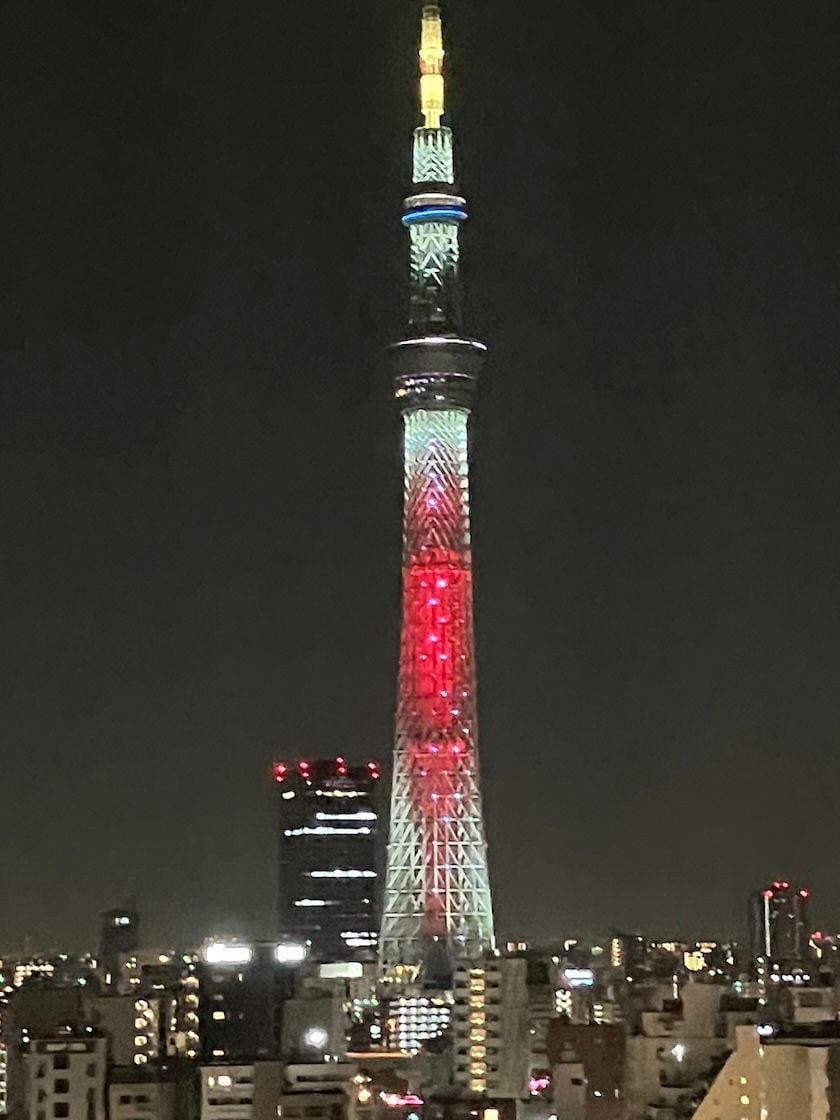
MATSUMOTO (3 nights) at the Richmond Hotel Matsumoto in a Deluxe double (non smoking)/single occupancy room. Total cost, before using my Richmond Club points, was 31,400 JPY (about $203 USD); after applying my Richmond Club points, the total cost was $61 USD. This was the best room of the four Japan hotels I stayed in (room #821). Very spacious with a huge window; large bed (maybe a king?); an upholstered daybed with cushions, an upholstered chair w a loose pillow, lots of lighting for reading anywhere in the room, and a large TV which had an English channel. The bathroom shower had great water pressure and temperature. It was conveniently located about 10 mins walk from the train & bus station, so it was easy to walk there but was away from the commercial area surrounding the station. It was also near all the main tourist sites (Matsumoto Castle, shrines, Frog Street, etc.) I would definitely recommend this hotel!

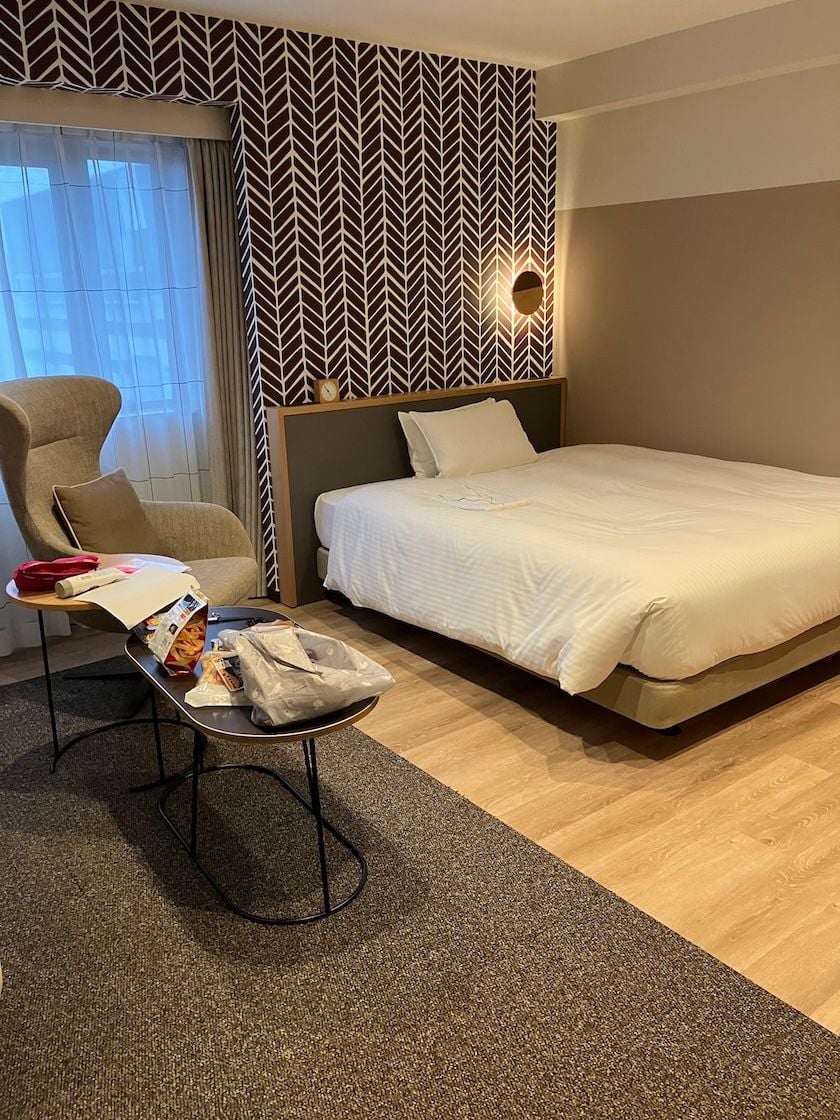

TAKAYMA (3 nights) at the Spa Hotel Alpina Hida Takayama in a Non-smoking single, Non-Smoking room (room # 412). Total cost was 29,928 JPY (about $193 USD). The room was fine; bed was comfortable, lighting was good and the window opened (that was important since the AC wasnít available yet (turned off for the entire hotel seasonally) but the evenings were cool, so by opening the window, the room was a perfect temp for sleeping). Hotel is about 8 mins walk from the train/bus station and about 8 minutes from the old historic areas.
NAGOYA (1 night) at the APA Hotel Nagoya Ekimae in a single room (room #1131). Total cost was 15,000 JPY (about $97 USD). Since was for one night only, I booked a small room which was teeny tiny, but acceptable. Not much room for luggage but since I only had a daypack, it was fine. Less than 10 minute walk from the train station.
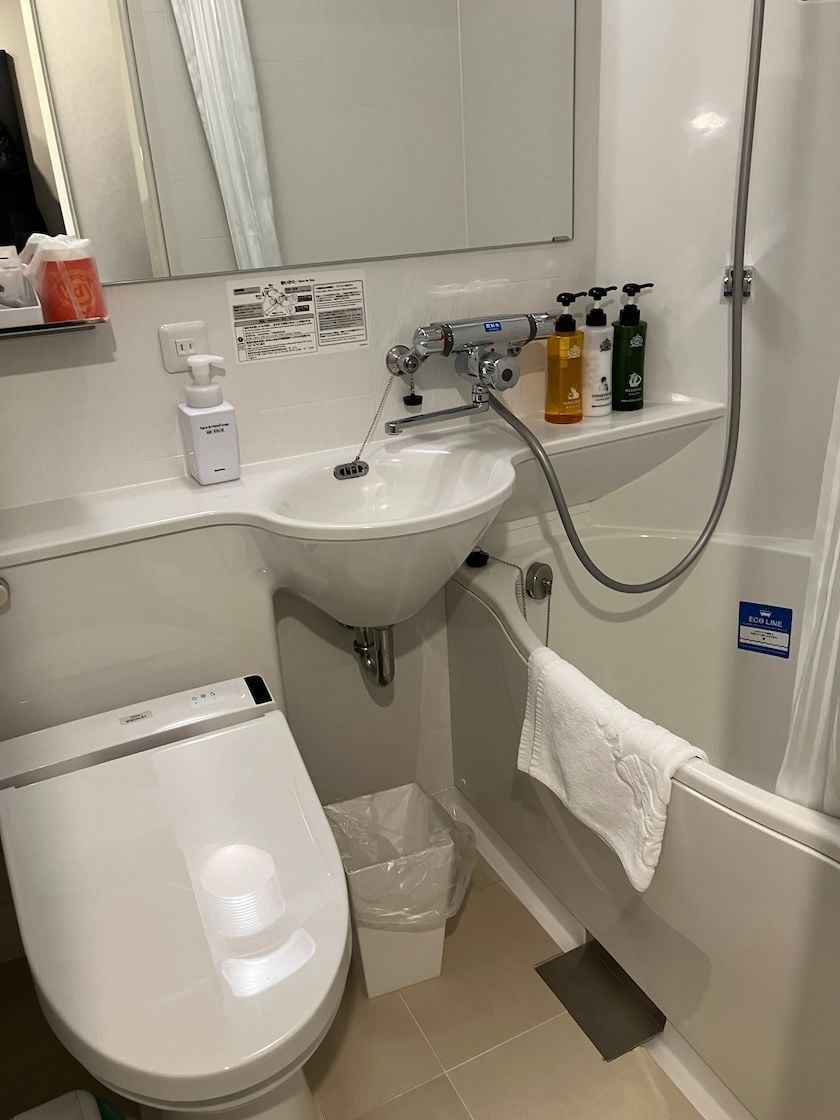
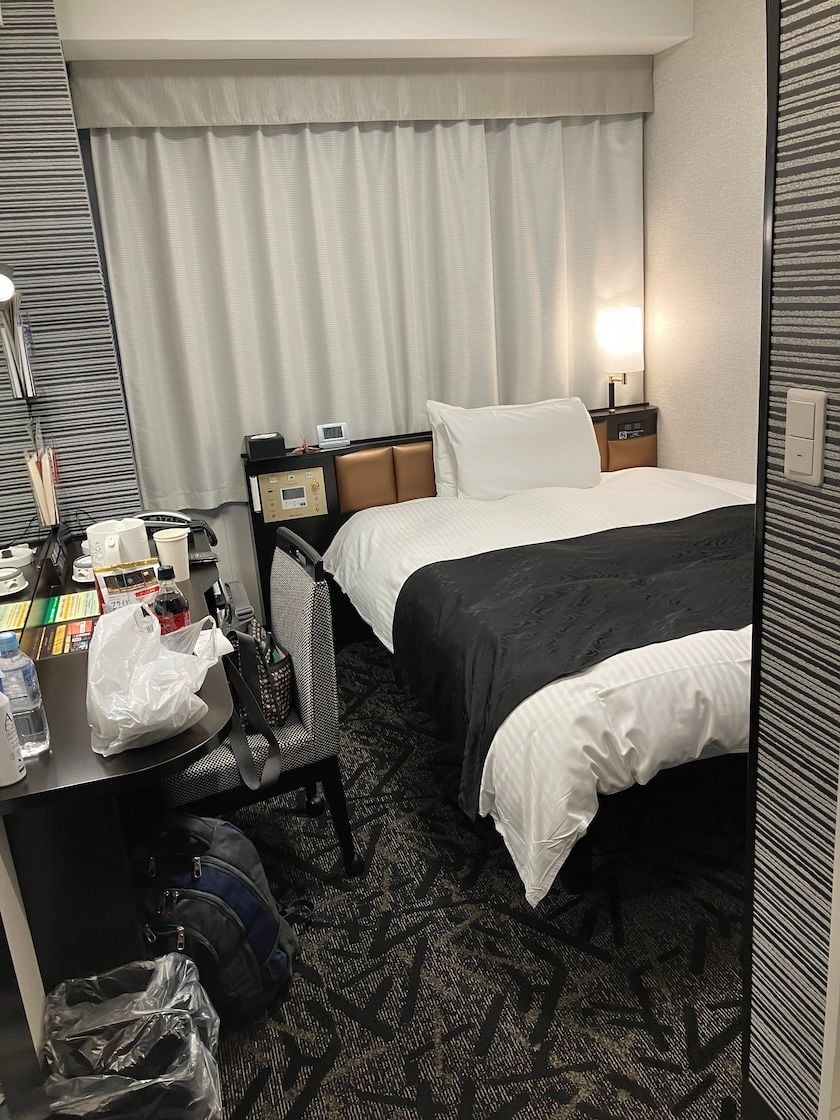
Hotel notes: All the hotels I stayed in provided ice machines, vending machines, washer/dryer and often a microwave on several floors of the hotel; I used the ice machines daily and the microwave a few times.
The hotels are very strict about their check-in time which is usually 2 or 3 pm. You can arrive earlier and leave your luggage with them but the actual check-in process has to be done at the hotelís prescribed time. In some hotels, you use a machine kiosk (looks like an ATM) to check in but at all the hotels you check out using a machine kiosk. There was always an ďlanguageĒ option and it was very easy to use, plus there were front desk staff to assist. If you have a hotelís club card and the machine prompts you to insert it, do it! Thatís how the system knew I had Richmond club points and asked me if I wanted to use them to pay for the Matsumoto hotel stay.
When searching for hotels, donít be afraid to stay in a hotel thatís only $50-$70 per night Ė sometimes called business hotels. They are perfectly fine Ė safe, clean, smaller but comfortable rooms, TVs, etc. They are a great way to save some money.
Public Transportation: I used a SUICA prepaid e-money card (left over from my 2019 trip) for all public transportation in Japan (not just in Tokyo) and a lot of shopping (such as convenience stores). Itís easy to add money to your cardís balance at ticket machines or convenience stores (cash only Ė get cash from ATMs at convenience stores and then use that cash to top up your SUICA card). Using a card removes the need to buy tickets from vending machines for trains/subways or from bus drivers. You just tap in & out and your current balance is displayed.
While the Tokyo subway system is easy to figure out, some of the stations are huge and if youíre transferring to another line, it can be a long Ė very long Ė walk between lines. Many of the stations have escalators or elevators, but not all; or sometimes they throw you off by having an escalator for one set of stairs but not the next (or itís going the wrong way). In Tokyo, I didnít use buses since trains & subways were most convenient for me.
Weather: This was an unexpected and slightly unpleasant surprise Ė it was much warmer than normal the entire time I was there. Tokyo was downright hot; Matsumoto & Takayama were cooler than Tokyo (further north and higher elevation) but still warmer than usual.
Food: Iím not a foodie and I donít like fish or seafood, so eating in Japan is always a bit difficult for me! Specifics are provided in the daily reports below.
Day 1 Ė Tokyo (March 28)
I disembarked from an 18 night cruise from Sydney at the newish Tokyo International Cruise Terminal located in the Odabai area of south central Tokyo. Following progolís suggestion, I was staying at the Richmond Premier Asakusa Hotel for four nights. Initially I had planned to take the terminalís shuttle bus to the Teleport station and thence to another station and onward via subway. However, I decided to just take a taxi to the hotel Ė forget trying to save money (versus dealing with subways and transfers while lugging a ten ton suitcase, plus a very full backpack and, because Iím a nutcase, a tote bag full of books.) The cab was about $55 USD and I was at the hotel by 9:30 am.
The hotel is located on the 5th-14th floors of a high rise building, with a very large Uniqlo store on the first 2 floors and a Don Quijote across the street (DQ is a Japanese discount chain and this store is open 24 hrs a day, 7 days a week; spread over 4 floors it sells EVERYTHING!. As many stores do, they offer tax free sales in which you show your passport and your purchases are sealed in a plastic bag which is not supposed to be opened while you are in Japan. I did some price comparisons for a certain line of make up and their prices were the same as drug stores. The big advantage of DQ is (1) itís an experience and (2) they carry a large range of goods.)
Because it arises later during the day, this is the deal with the books: I brought about three books with me from home and then I bought four more books from a charity shop in Sydney that were written by Australian authors, who arenít published in the US; so far so good. But my downfall was taking about six paperbacks (large ones) from the paperback exchange in the shipís library; most of them are Australian authors, so Iím pleased to have found so many books by authors I wouldnít normally be able to read BUT their paperbacks are bigger than ours dimension-wise and they weigh a lot. Before I actually carried them off the ship, I asked one of the Japanese hostesses on the ship if she thought my hotel could take care of shipping these books home to me in the US and she said yes Ė OK, that was the answer I needed so I lugged the books with me. Unfortunately, when I checked in, the hotel was very apologetic but told me that I needed to go to the post office to accomplish this and theyíll sell you a box and tape, etc.
Since it was so early, I couldnít actually check in but I left my suitcase and backpack and got nearest directions to the post office. Before the post office, I had another mission - to buy a new cheap watch; my Swatch watch has been losing time steadily and since the nearest Swatch store was on the other side of the city, I went into Don Quijote and bought a $12 Casio watch. Interesting Ė while I was perusing their large selection of cheap watches, they had Omegas and other expensive brands behind the counter (donít know if those were a good deal). I left happy as a clam.
The hotel is located equi-distant between several ďAsakusaĒ stations but it turned out that the subway stations I used most often were the Tawaramachi Station and the Tsukuba Express (TX) which were on the way to the post office, so this commercial area became a familiar path. Since I was looking at everything Ė and the books were heavy Ė it took me about 15 minutes; I passed two donut shops with long lines. Although the postal clerks only spoke a few words of English we figured it out and I packed up my box of books Ė but what a shockaroo, the shipping cost is $93. They better be darn good books!!! I didnít know the cost until everything had been packaged, and they had spent a fair amount of time with meÖ. Oh, well, itís been an experience and a good story. I stopped into the Bakery & Cafe Yamazaki to buy a breakfast roll (a hot dog type sausage in a roll with cheese) and a fantastic walnut roll.
All these errands took about two hours but now it was time for fun! I took the subway to the Kiyosumi Gardens. Although this is a traditional strolling garden (paths lead you around a man-made lake with islands, past a hill, etc.) this is sometimes referred to as a stone garden because it contains many and varied stones. Including stepping stones that allow you to venture out into the lake; apparently landscape stones are highly sought after and some of these are famous stones that were acquired from across Japan. I was particularly taken with the stone waterfall - an artistically arranged course of large, grapefruit sized rocks that tumble and swirl down a curvy hillside path Ö just the way water would do. Pretty nifty concept.
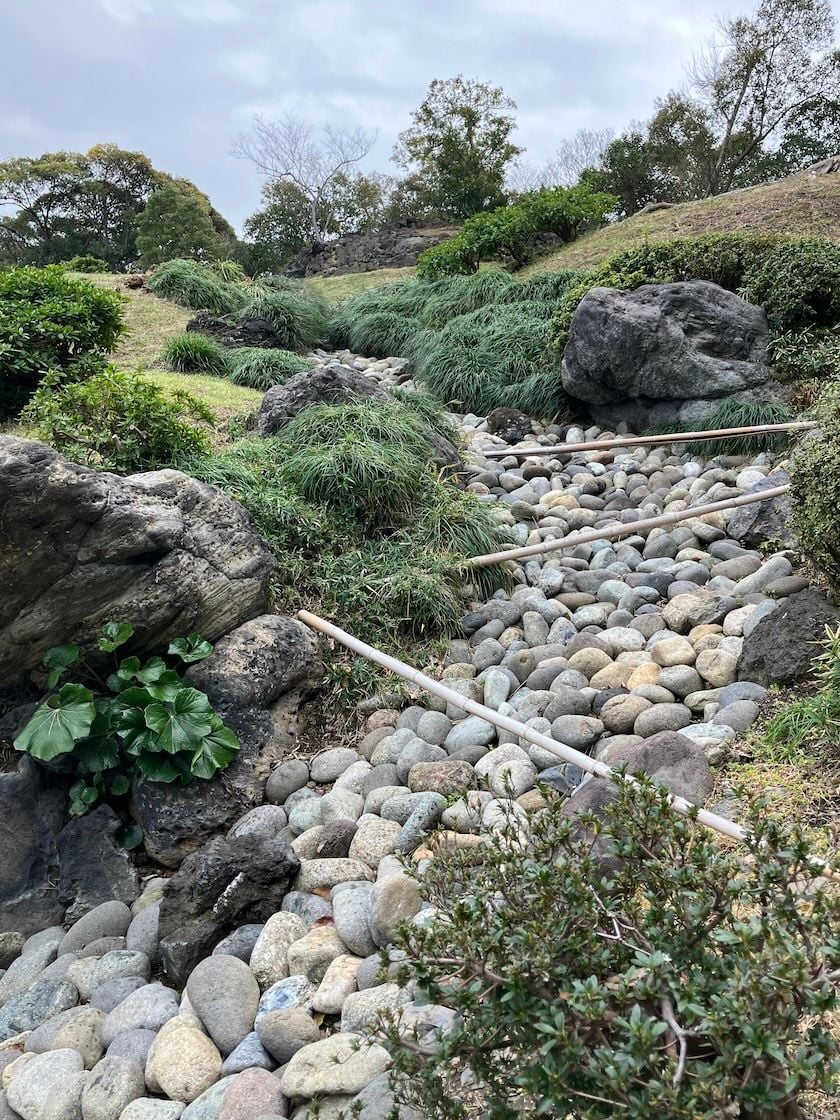
Stone (or dry) waterfall
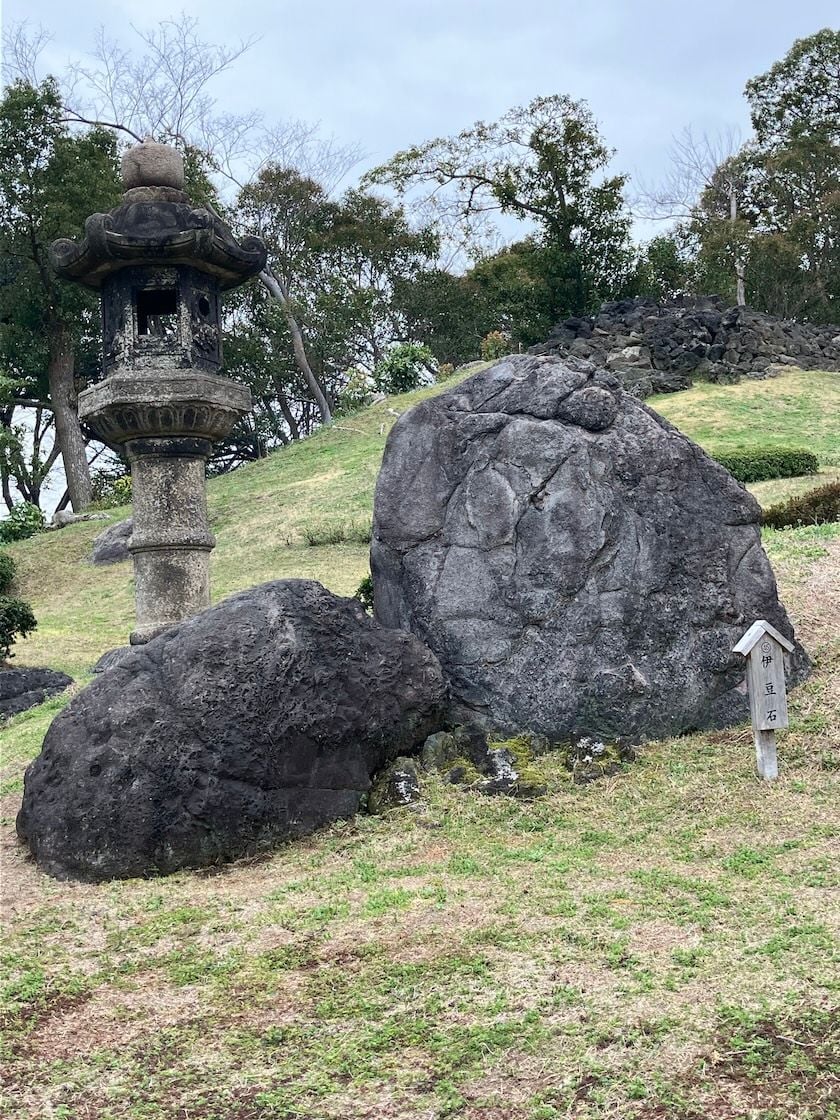
Interesting stones; each grouping had a little wooden sign which explained (in Japanese characters) the significance of the stones

I liked the green and white striations of this rock.
The garden was initially created in the early 18th c and was the home of a feudal lord. In 1878 the founder of Mitsubishi bought this land and he rebuilt the garden for use by his employees and VIPs; under him, all the stones were obtained and landscaped; it stayed in the family for a long time and then they gave it to the city.
My next stop was the Yasukuni-jinja shrine and the Yushukan Museum which are next to each other. Yasukuni-jinja is a shrine dedicated to those who have died fighting for Japan including convicted war criminals. The museum is a military museum containing artifacts, documents and narrative displays. Since Iím reading Shogun, the feudal exhibits of samurai armor & swords interested me and I got caught up that and by the time I got to the 20th century section, I didnít have much time before the museum closed. Understandably, the majority of the exhibits didnít have English descriptions but some, like the armor, were fairly easy to grasp. From reading, I gather this museum can be considered controversial due to possible revisionist history but since I didnít spend much time in the 20th c section, I canít speak to that. I didnít spend much time at the shrine because I was just too tired by now. More subways back to the hotel; I found a bakery in one of the larger stations and bought a ham and cheese on a whole wheat baguette, which would make a perfect dinner along with a bag of potato chips and a soda.
NextÖ the first day of an intensive two day walking tour of Tokyo.
Accommodation:
TOKYO (4 nights) at the Richmond Hotel Premier Asakusa in a Premier View Twin (single use) Non-Smoking room. Total cost was 220,300 JPY (about $1,422 USD). I chose this hotel based on progolís trip report recommendation and was very happy with it; they have a range of room types/prices and I chose this room type due to the wonderful view of the Tokyo Skytower, the Senso-ji Temple and the surrounding streets and the larger room size. The location suited me Ė itís in an older area, near several train/subway/bus stops, with evening hustle & bustle which was remote to me from 14 stories up! The front desk was very helpful with maps, directions and storing/forwarding my suitcase. Note: When making my reservation on their website, I joined the Richmond Club since it provided a bit of a discount on the room rate and I was staying at another Richmond hotel in Matsumoto; well, it turned out that I earned so many Richmond points from my Tokyo stay that the cost of my Matsumoto hotel was reduced by about $140 USD due to the points Ė woo hoo!

MATSUMOTO (3 nights) at the Richmond Hotel Matsumoto in a Deluxe double (non smoking)/single occupancy room. Total cost, before using my Richmond Club points, was 31,400 JPY (about $203 USD); after applying my Richmond Club points, the total cost was $61 USD. This was the best room of the four Japan hotels I stayed in (room #821). Very spacious with a huge window; large bed (maybe a king?); an upholstered daybed with cushions, an upholstered chair w a loose pillow, lots of lighting for reading anywhere in the room, and a large TV which had an English channel. The bathroom shower had great water pressure and temperature. It was conveniently located about 10 mins walk from the train & bus station, so it was easy to walk there but was away from the commercial area surrounding the station. It was also near all the main tourist sites (Matsumoto Castle, shrines, Frog Street, etc.) I would definitely recommend this hotel!



TAKAYMA (3 nights) at the Spa Hotel Alpina Hida Takayama in a Non-smoking single, Non-Smoking room (room # 412). Total cost was 29,928 JPY (about $193 USD). The room was fine; bed was comfortable, lighting was good and the window opened (that was important since the AC wasnít available yet (turned off for the entire hotel seasonally) but the evenings were cool, so by opening the window, the room was a perfect temp for sleeping). Hotel is about 8 mins walk from the train/bus station and about 8 minutes from the old historic areas.
NAGOYA (1 night) at the APA Hotel Nagoya Ekimae in a single room (room #1131). Total cost was 15,000 JPY (about $97 USD). Since was for one night only, I booked a small room which was teeny tiny, but acceptable. Not much room for luggage but since I only had a daypack, it was fine. Less than 10 minute walk from the train station.


Hotel notes: All the hotels I stayed in provided ice machines, vending machines, washer/dryer and often a microwave on several floors of the hotel; I used the ice machines daily and the microwave a few times.
The hotels are very strict about their check-in time which is usually 2 or 3 pm. You can arrive earlier and leave your luggage with them but the actual check-in process has to be done at the hotelís prescribed time. In some hotels, you use a machine kiosk (looks like an ATM) to check in but at all the hotels you check out using a machine kiosk. There was always an ďlanguageĒ option and it was very easy to use, plus there were front desk staff to assist. If you have a hotelís club card and the machine prompts you to insert it, do it! Thatís how the system knew I had Richmond club points and asked me if I wanted to use them to pay for the Matsumoto hotel stay.
When searching for hotels, donít be afraid to stay in a hotel thatís only $50-$70 per night Ė sometimes called business hotels. They are perfectly fine Ė safe, clean, smaller but comfortable rooms, TVs, etc. They are a great way to save some money.
Public Transportation: I used a SUICA prepaid e-money card (left over from my 2019 trip) for all public transportation in Japan (not just in Tokyo) and a lot of shopping (such as convenience stores). Itís easy to add money to your cardís balance at ticket machines or convenience stores (cash only Ė get cash from ATMs at convenience stores and then use that cash to top up your SUICA card). Using a card removes the need to buy tickets from vending machines for trains/subways or from bus drivers. You just tap in & out and your current balance is displayed.
While the Tokyo subway system is easy to figure out, some of the stations are huge and if youíre transferring to another line, it can be a long Ė very long Ė walk between lines. Many of the stations have escalators or elevators, but not all; or sometimes they throw you off by having an escalator for one set of stairs but not the next (or itís going the wrong way). In Tokyo, I didnít use buses since trains & subways were most convenient for me.
Weather: This was an unexpected and slightly unpleasant surprise Ė it was much warmer than normal the entire time I was there. Tokyo was downright hot; Matsumoto & Takayama were cooler than Tokyo (further north and higher elevation) but still warmer than usual.
Food: Iím not a foodie and I donít like fish or seafood, so eating in Japan is always a bit difficult for me! Specifics are provided in the daily reports below.
Day 1 Ė Tokyo (March 28)
I disembarked from an 18 night cruise from Sydney at the newish Tokyo International Cruise Terminal located in the Odabai area of south central Tokyo. Following progolís suggestion, I was staying at the Richmond Premier Asakusa Hotel for four nights. Initially I had planned to take the terminalís shuttle bus to the Teleport station and thence to another station and onward via subway. However, I decided to just take a taxi to the hotel Ė forget trying to save money (versus dealing with subways and transfers while lugging a ten ton suitcase, plus a very full backpack and, because Iím a nutcase, a tote bag full of books.) The cab was about $55 USD and I was at the hotel by 9:30 am.
The hotel is located on the 5th-14th floors of a high rise building, with a very large Uniqlo store on the first 2 floors and a Don Quijote across the street (DQ is a Japanese discount chain and this store is open 24 hrs a day, 7 days a week; spread over 4 floors it sells EVERYTHING!. As many stores do, they offer tax free sales in which you show your passport and your purchases are sealed in a plastic bag which is not supposed to be opened while you are in Japan. I did some price comparisons for a certain line of make up and their prices were the same as drug stores. The big advantage of DQ is (1) itís an experience and (2) they carry a large range of goods.)
Because it arises later during the day, this is the deal with the books: I brought about three books with me from home and then I bought four more books from a charity shop in Sydney that were written by Australian authors, who arenít published in the US; so far so good. But my downfall was taking about six paperbacks (large ones) from the paperback exchange in the shipís library; most of them are Australian authors, so Iím pleased to have found so many books by authors I wouldnít normally be able to read BUT their paperbacks are bigger than ours dimension-wise and they weigh a lot. Before I actually carried them off the ship, I asked one of the Japanese hostesses on the ship if she thought my hotel could take care of shipping these books home to me in the US and she said yes Ė OK, that was the answer I needed so I lugged the books with me. Unfortunately, when I checked in, the hotel was very apologetic but told me that I needed to go to the post office to accomplish this and theyíll sell you a box and tape, etc.
Since it was so early, I couldnít actually check in but I left my suitcase and backpack and got nearest directions to the post office. Before the post office, I had another mission - to buy a new cheap watch; my Swatch watch has been losing time steadily and since the nearest Swatch store was on the other side of the city, I went into Don Quijote and bought a $12 Casio watch. Interesting Ė while I was perusing their large selection of cheap watches, they had Omegas and other expensive brands behind the counter (donít know if those were a good deal). I left happy as a clam.
The hotel is located equi-distant between several ďAsakusaĒ stations but it turned out that the subway stations I used most often were the Tawaramachi Station and the Tsukuba Express (TX) which were on the way to the post office, so this commercial area became a familiar path. Since I was looking at everything Ė and the books were heavy Ė it took me about 15 minutes; I passed two donut shops with long lines. Although the postal clerks only spoke a few words of English we figured it out and I packed up my box of books Ė but what a shockaroo, the shipping cost is $93. They better be darn good books!!! I didnít know the cost until everything had been packaged, and they had spent a fair amount of time with meÖ. Oh, well, itís been an experience and a good story. I stopped into the Bakery & Cafe Yamazaki to buy a breakfast roll (a hot dog type sausage in a roll with cheese) and a fantastic walnut roll.
All these errands took about two hours but now it was time for fun! I took the subway to the Kiyosumi Gardens. Although this is a traditional strolling garden (paths lead you around a man-made lake with islands, past a hill, etc.) this is sometimes referred to as a stone garden because it contains many and varied stones. Including stepping stones that allow you to venture out into the lake; apparently landscape stones are highly sought after and some of these are famous stones that were acquired from across Japan. I was particularly taken with the stone waterfall - an artistically arranged course of large, grapefruit sized rocks that tumble and swirl down a curvy hillside path Ö just the way water would do. Pretty nifty concept.

Stone (or dry) waterfall

Interesting stones; each grouping had a little wooden sign which explained (in Japanese characters) the significance of the stones

I liked the green and white striations of this rock.
The garden was initially created in the early 18th c and was the home of a feudal lord. In 1878 the founder of Mitsubishi bought this land and he rebuilt the garden for use by his employees and VIPs; under him, all the stones were obtained and landscaped; it stayed in the family for a long time and then they gave it to the city.
My next stop was the Yasukuni-jinja shrine and the Yushukan Museum which are next to each other. Yasukuni-jinja is a shrine dedicated to those who have died fighting for Japan including convicted war criminals. The museum is a military museum containing artifacts, documents and narrative displays. Since Iím reading Shogun, the feudal exhibits of samurai armor & swords interested me and I got caught up that and by the time I got to the 20th century section, I didnít have much time before the museum closed. Understandably, the majority of the exhibits didnít have English descriptions but some, like the armor, were fairly easy to grasp. From reading, I gather this museum can be considered controversial due to possible revisionist history but since I didnít spend much time in the 20th c section, I canít speak to that. I didnít spend much time at the shrine because I was just too tired by now. More subways back to the hotel; I found a bakery in one of the larger stations and bought a ham and cheese on a whole wheat baguette, which would make a perfect dinner along with a bag of potato chips and a soda.
NextÖ the first day of an intensive two day walking tour of Tokyo.
#2
Original Poster
Join Date: Sep 2005
Posts: 499
Likes: 0
Received 0 Likes
on
0 Posts
Day 2 – Tokyo (March 29)
If today’s summary was a weather report, it would be dark clouds. Literally, because it rained hard until noon and figuratively because the walking tour was not very good. This was a two-day tour that is “Tokyo in depth, 9-4pm each day for about $230 USD total. The last time I was in Tokyo, I was overwhelmed by it; I think it’s a very hard city to get your arms around because it’s so huge area-wise and doesn’t have separate distinct areas, they all sort of overlap due to development. I like big cities and am comfortable in New York, London, Paris, and many more but Tokyo might be beyond me. (Plus, it’s not a very attractive city to my eye). But I thought that taking an in-depth, intensive Tokyo walking tour that discusses Edo history, commoners lives and the development of modern industrial Japan would bring it together for me. The tour company is well regarded for their multi-day walking tours of Japanese countryside so I was excited to get an expert’s view of Tokyo. Alas, that didn’t happen today. Even after the sun came out at noon, it was still a no go.
The tour began at the Nihonbashi Tourism Information Building, next to Nihonbashi Bridge at 9:00 am. There were 3 couples, me, the guide and a trainee guide. Per the tour’s info packet Day 1 would cover “The city of the shogun: an introduction to the establishment of Edo; its administration; the life of the shoguns, daimyo, and samurai; and Edo castle’s immediate neighbourhood, Nihonbashi.” The guide was a nice man, but the tour felt very disjointed - a mishmash of walking through unattractive areas and back alleys with very little information about where we were, where we were going, and why it was important in history. The best part of the morning was going to the Fukagawa Edo museum which is a recreation of a town from the mid-19th century, from the commoners’ perspective. It was small and reminded me of the Deijma restored trading village that I went to in Nagasaki (although Deijma was much more comprehensive than this). The best part was a museum volunteer who saw me sitting down and explained that I was sitting in what would’ve been a tea shop, and she brought me a fake cup of tea so that I could see how it would be presented; she showed me that if I smoked, live coals in a metal case inside a wood box set in a sand box would be brought to me so I could fill my pipe with tobacco and light it; she also showed old prints of attractive tea ladies in kimonos who worked in the tea shops and young men of the area came to these tea spots to meet the women. One of the prints was a local dandy having his smoke in the shop; I thought that was very interesting and I asked her why there were so many young men in the area and she explained it was because they came for jobs, particularly in timber; until early 20th century, Tokyo was made out of wood. For me, the volunteer was a lot more informative than our guide.
The other highlight was going to a heritage garden, Koishikawa Korakuen Gardens. Built by a Shogun family in 1629, it was designed as a strolling garden for him, his family and his guests. There’s a lake with three little islets, meandering stream in a shady woodland with a stone path wandering through the woods, a waterfall, more paving stones, and various scenic overlook spots from the lakeside to one of the islands with a mini shrine. The good news is that the rain kept the crowds away so I was able to picture a shogun and his family in full kimonos, sandals, etc. strolling around the lake. I have to say, reading Shogun concurrently with this trip is great since I can relate a lot of what I see to the book.

Lake and islet
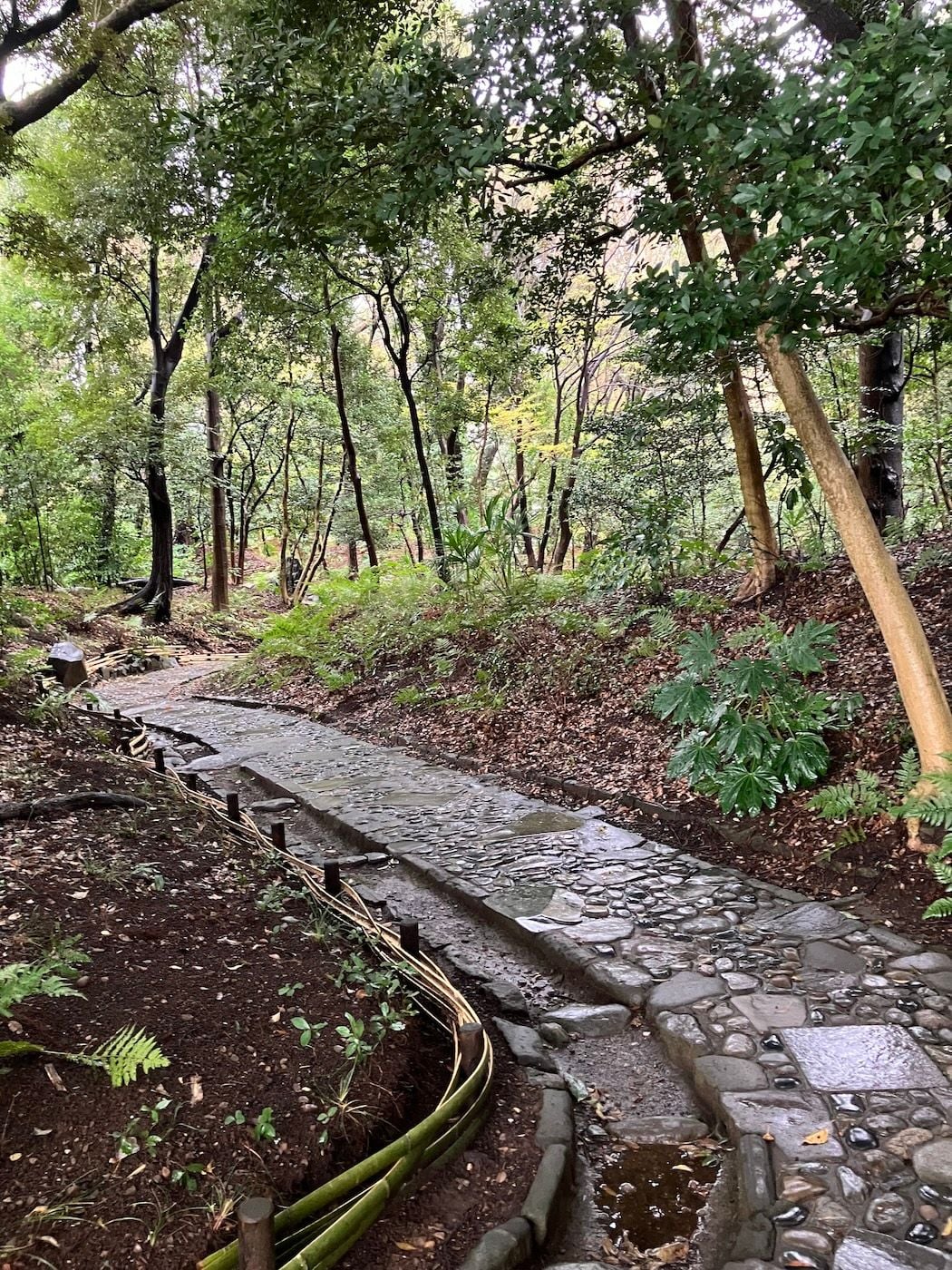
Meandering path through the woodland
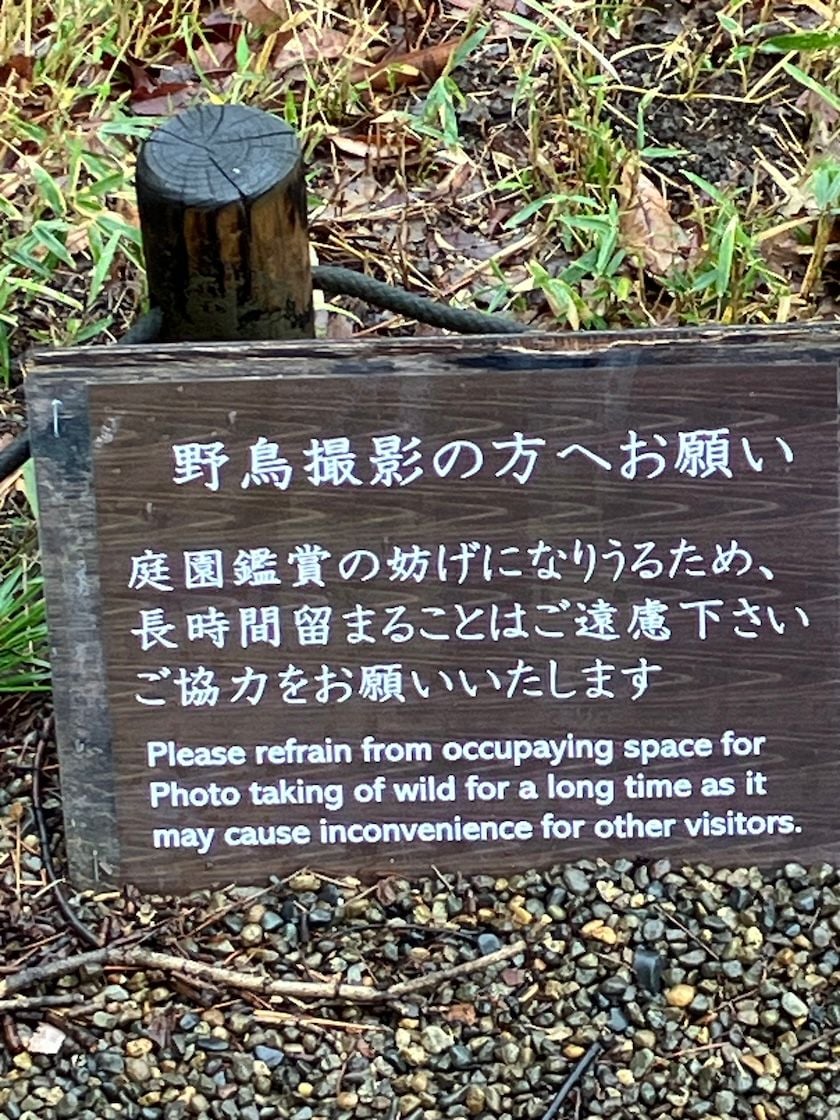
Very polite!

I think a good tour leader is like a storyteller. No matter how historic the city, they have to lead their group along some streets that aren’t particular significant or attractive in order to get us from place to place. A leader can use those times as an opportunity to fill in history or tell amusing anecdotes about the period in order to make it come alive and therefore string together these disparate spots into a storyline & this guide didn’t.
We knew lunch would be at our own cost which was fine so we were brought to a train station food court for lunch; the advantage is that there were various types of cuisine and we could pick wherever we wanted. Everybody separated and I ended up having spaghetti with meat sauce, which was surprisingly good and sounds very funny “I went to Tokyo and had spaghetti” I wanted to try ramen, but wasn’t comfortable going to a restaurant by myself not speaking Japanese and not knowing what or how to order it.
After lunch we ended the day at the Imperial Palace and had free time to wander on our own. I was waiting for the rest of the group at the Hirakawa-mon gate and talking to one of the other women on the tour who said that she and her husband and another couple were not satisfied at all with the tour; in fact, the other couple had decided not to return for Day 2 and this couple was also thinking about not coming back. So if both those couples didn’t return, that would leave one other couple and me (out of an original 7 people) and I felt bad for poor leader; this is his first year working as a tour leader and he means well. So I encouraged the other couple to at least come for the morning to try it out and see if it’s more interesting.
On the way back to the hotel, I stopped in a convenience store for dinner, including fried chicken. I also went into any drug stores I saw to buy my favorite lipstick (from Shisheido’s less expensive line) – I ended up bringing 12 home with me. A fun thing – I was sitting in my hotel room admiring the Tokyo SkyTree’s color changes and I heard Japanese drumming from the street below, so I looked down 13 floors and there was some kind of a procession going on with people dressed in lion costumes and dancers with the drummer. Pretty cool. Not cool enough to get dressed and go down to the street but cool enough to get up out of my chair.🤣. Side note: no English TV channels so I’m watching a Japanese baseball game – baseball is baseball regardless of the language. A common theme – all channels showed a lot of coverage of the Japanese baseball players on US major league baseball teams, particularly the phenoms Ohtani and Yamamoto on the LA Dodgers.
Anyway, tomorrow’s another day, supposed to be sunny and warm, and let’s hope our fearless tour leader has better material for tomorrow.
If today’s summary was a weather report, it would be dark clouds. Literally, because it rained hard until noon and figuratively because the walking tour was not very good. This was a two-day tour that is “Tokyo in depth, 9-4pm each day for about $230 USD total. The last time I was in Tokyo, I was overwhelmed by it; I think it’s a very hard city to get your arms around because it’s so huge area-wise and doesn’t have separate distinct areas, they all sort of overlap due to development. I like big cities and am comfortable in New York, London, Paris, and many more but Tokyo might be beyond me. (Plus, it’s not a very attractive city to my eye). But I thought that taking an in-depth, intensive Tokyo walking tour that discusses Edo history, commoners lives and the development of modern industrial Japan would bring it together for me. The tour company is well regarded for their multi-day walking tours of Japanese countryside so I was excited to get an expert’s view of Tokyo. Alas, that didn’t happen today. Even after the sun came out at noon, it was still a no go.
The tour began at the Nihonbashi Tourism Information Building, next to Nihonbashi Bridge at 9:00 am. There were 3 couples, me, the guide and a trainee guide. Per the tour’s info packet Day 1 would cover “The city of the shogun: an introduction to the establishment of Edo; its administration; the life of the shoguns, daimyo, and samurai; and Edo castle’s immediate neighbourhood, Nihonbashi.” The guide was a nice man, but the tour felt very disjointed - a mishmash of walking through unattractive areas and back alleys with very little information about where we were, where we were going, and why it was important in history. The best part of the morning was going to the Fukagawa Edo museum which is a recreation of a town from the mid-19th century, from the commoners’ perspective. It was small and reminded me of the Deijma restored trading village that I went to in Nagasaki (although Deijma was much more comprehensive than this). The best part was a museum volunteer who saw me sitting down and explained that I was sitting in what would’ve been a tea shop, and she brought me a fake cup of tea so that I could see how it would be presented; she showed me that if I smoked, live coals in a metal case inside a wood box set in a sand box would be brought to me so I could fill my pipe with tobacco and light it; she also showed old prints of attractive tea ladies in kimonos who worked in the tea shops and young men of the area came to these tea spots to meet the women. One of the prints was a local dandy having his smoke in the shop; I thought that was very interesting and I asked her why there were so many young men in the area and she explained it was because they came for jobs, particularly in timber; until early 20th century, Tokyo was made out of wood. For me, the volunteer was a lot more informative than our guide.
The other highlight was going to a heritage garden, Koishikawa Korakuen Gardens. Built by a Shogun family in 1629, it was designed as a strolling garden for him, his family and his guests. There’s a lake with three little islets, meandering stream in a shady woodland with a stone path wandering through the woods, a waterfall, more paving stones, and various scenic overlook spots from the lakeside to one of the islands with a mini shrine. The good news is that the rain kept the crowds away so I was able to picture a shogun and his family in full kimonos, sandals, etc. strolling around the lake. I have to say, reading Shogun concurrently with this trip is great since I can relate a lot of what I see to the book.

Lake and islet

Meandering path through the woodland

Very polite!

I think a good tour leader is like a storyteller. No matter how historic the city, they have to lead their group along some streets that aren’t particular significant or attractive in order to get us from place to place. A leader can use those times as an opportunity to fill in history or tell amusing anecdotes about the period in order to make it come alive and therefore string together these disparate spots into a storyline & this guide didn’t.
We knew lunch would be at our own cost which was fine so we were brought to a train station food court for lunch; the advantage is that there were various types of cuisine and we could pick wherever we wanted. Everybody separated and I ended up having spaghetti with meat sauce, which was surprisingly good and sounds very funny “I went to Tokyo and had spaghetti” I wanted to try ramen, but wasn’t comfortable going to a restaurant by myself not speaking Japanese and not knowing what or how to order it.
After lunch we ended the day at the Imperial Palace and had free time to wander on our own. I was waiting for the rest of the group at the Hirakawa-mon gate and talking to one of the other women on the tour who said that she and her husband and another couple were not satisfied at all with the tour; in fact, the other couple had decided not to return for Day 2 and this couple was also thinking about not coming back. So if both those couples didn’t return, that would leave one other couple and me (out of an original 7 people) and I felt bad for poor leader; this is his first year working as a tour leader and he means well. So I encouraged the other couple to at least come for the morning to try it out and see if it’s more interesting.
On the way back to the hotel, I stopped in a convenience store for dinner, including fried chicken. I also went into any drug stores I saw to buy my favorite lipstick (from Shisheido’s less expensive line) – I ended up bringing 12 home with me. A fun thing – I was sitting in my hotel room admiring the Tokyo SkyTree’s color changes and I heard Japanese drumming from the street below, so I looked down 13 floors and there was some kind of a procession going on with people dressed in lion costumes and dancers with the drummer. Pretty cool. Not cool enough to get dressed and go down to the street but cool enough to get up out of my chair.🤣. Side note: no English TV channels so I’m watching a Japanese baseball game – baseball is baseball regardless of the language. A common theme – all channels showed a lot of coverage of the Japanese baseball players on US major league baseball teams, particularly the phenoms Ohtani and Yamamoto on the LA Dodgers.
Anyway, tomorrow’s another day, supposed to be sunny and warm, and let’s hope our fearless tour leader has better material for tomorrow.
#3
Original Poster
Join Date: Sep 2005
Posts: 499
Likes: 0
Received 0 Likes
on
0 Posts
Day 3 – Tokyo (March 30)
It’s blue sky, sunny, and mid 70s. This is day two of the tour and our meeting point was the same place as yesterday, Nihonbashi. Because I got delayed at the front desk arranging my luggage storage and forwarding, I was afraid I wouldn’t have time to take the subway so took a cab to the meeting place. I was pleasantly surprised that at 8:30 on a Saturday morning it only cost me $17! One couple from yesterday decided not to come back so five of us plus the two guides ventured off. Today’s tour should cover “The city of the Edo townspeople: today, we gain a feel for the city of the Edokko, the townspeople, and their lives from the Edo Period, through the city’s tumultuous transition into the nation’s capital in the late nineteenth century, and up to the present day.”
We walked to the old red brick Tokyo station from 1914; on the way there, we passed several street bars and discussed the drinking culture for company workers. In the past, employees felt like they had to go out drinking each night with their colleagues and, more importantly, their bosses. Our guide explained that has changed drastically and is no longer widely followed; he said that most workers under 35 want to go home at night.
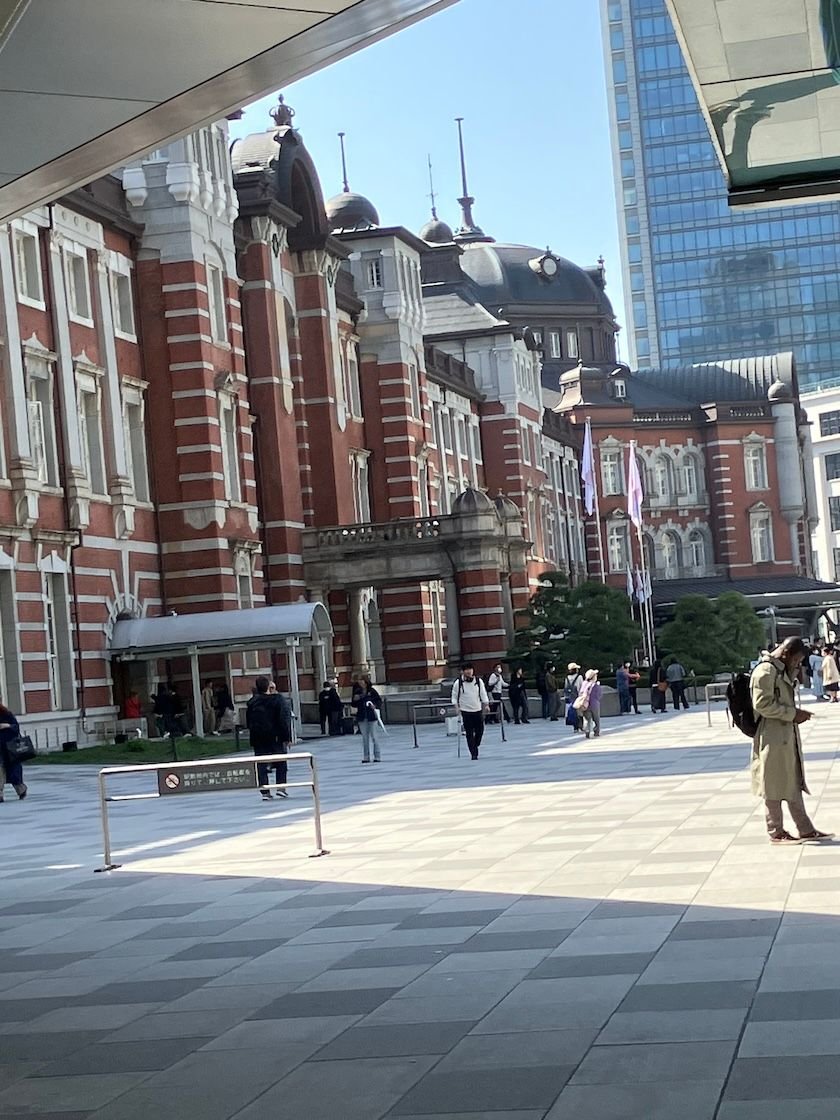
Tokyo Train Station, circa 1914

Interior of old part of the train station
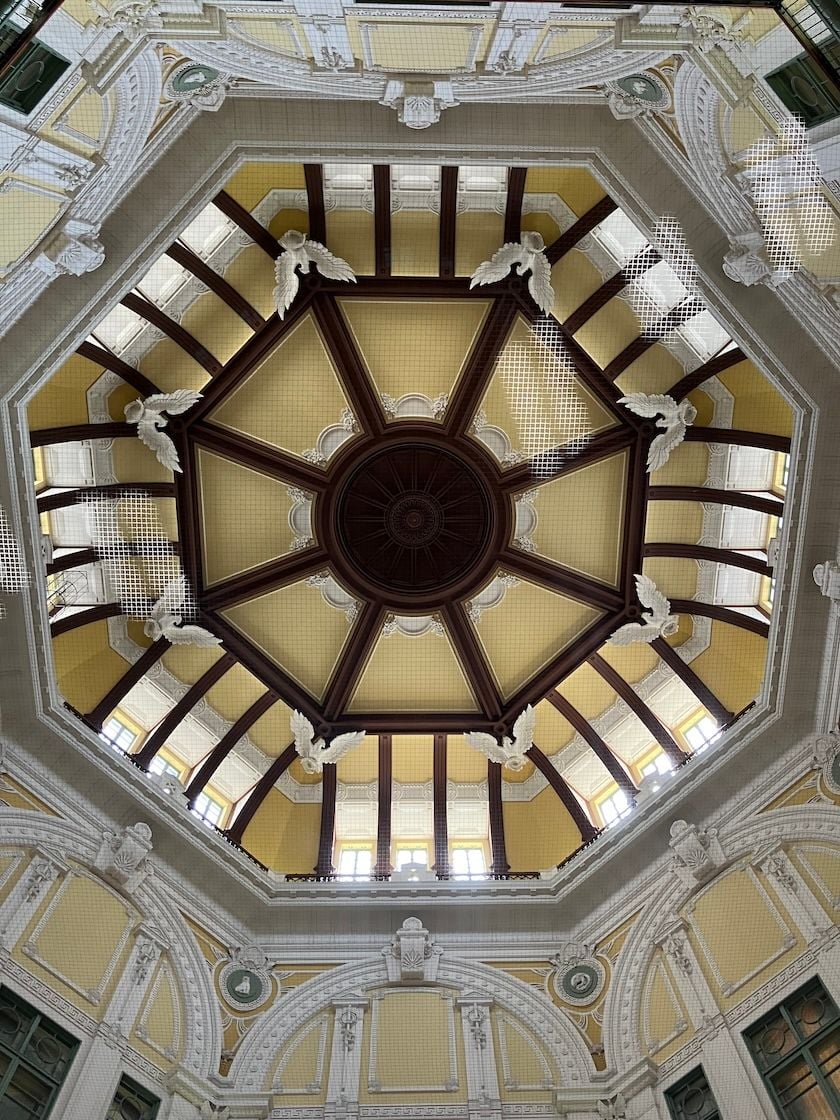
Dome in old part of the train station
We took the JR line to Nippori, which is in a north western residential section of Tokyo called Yanaka. This is an old area that was on my list to see, so I’m happy we’re doing it with the tour. As soon as we walked out of the train station, I thought this is my kind of place – low buildings, a combination of homes and small shops and trees. This is an area that local people live in, although it’s gotten expensive and is becoming touristy but it’s not there yet.
Our first stop was a public cemetery (most cemeteries are owned by the temples). Very interesting since the styles are so different from western ones; this is a very active cemetery, and if plots are not maintained, and/or the annual subscription payments are not made for 2 to 3 years, the city takes back the plot and sells it to someone else. Most monuments are polished gray marble, but there are some that are rocks; we saw a grave area for a famous sumo personage who was the first wrestler to come to the US - he met President Grant at the White House. When he died, other sumo wrestlers contributed funds for a fancy graveyard site and inscribed stone wall pillars to commemorate him and his feats. Families can hire a someone to keep their ancestors’ graves tidy; we saw a lady there with her apron, kerchief and gloves sweeping the graves and surrounding area with a twig brush, throwing away dead flowers, removing twigs, leaves, etc. and checking it off in her little notebook before she wheeled her bike to the next one. I was interested that right next to the cemetery was a batting cage and a father throwing pitches to his young son; talk about an obvious juxtaposition of youth and the dead. 🙄
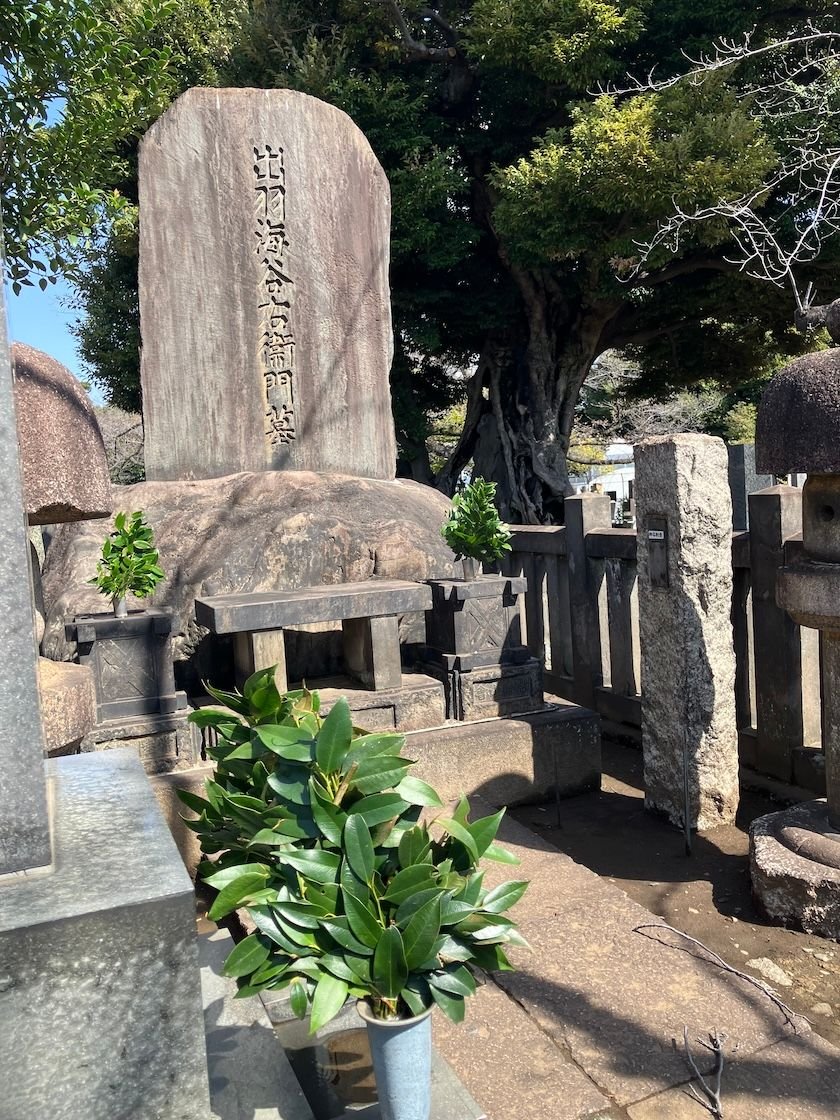
Famous sumo wrestler's grave

Beer alley in Yanaka
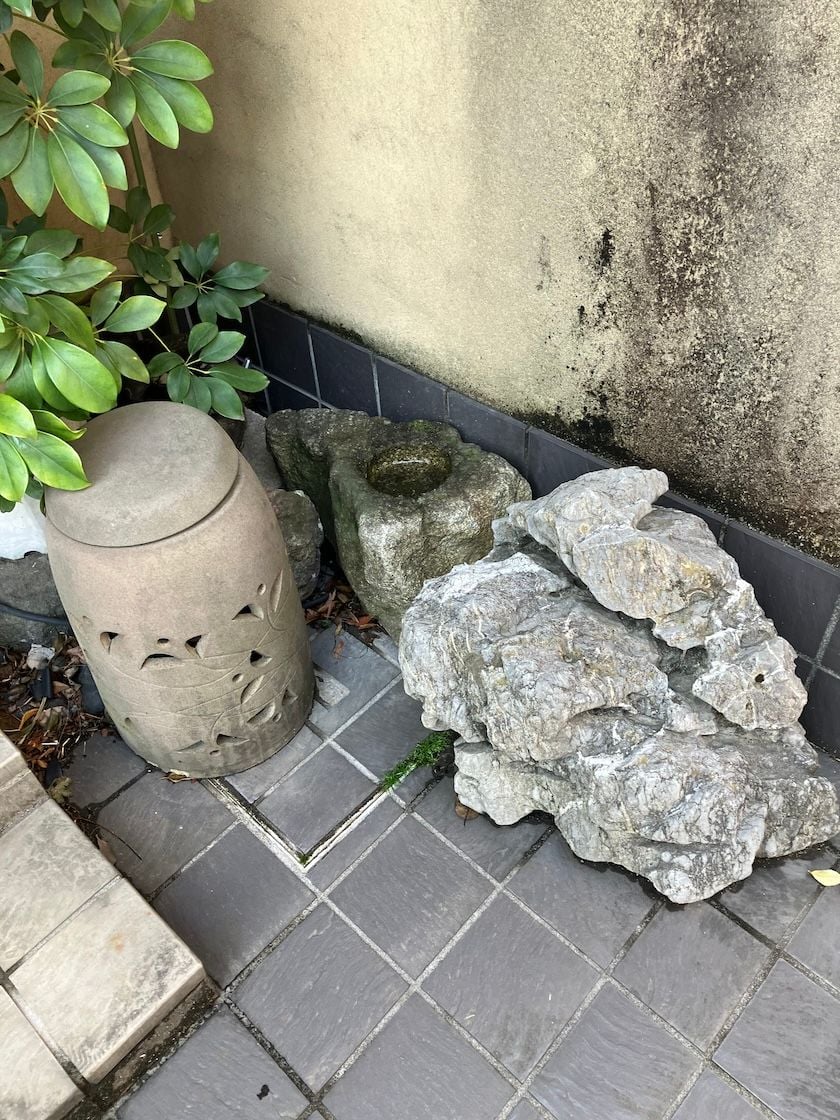
Yanaka front door sight
Then we walked down side roads, passing galleries, and lots of interesting little shops. We also went past a sculpture museum that I will come back to tomorrow. The Yanaka Ginza is a 200 meter stretch of the street which is a shopping area; the stores have stalls in front of their stores where they sell their products; these really seem to be local shops with local goods. I bought some cool 3-D cards from the man who actually made them, some absolutely scrumptious pastries (as an aside, there are great bakeries in Tokyo that have western style pastries that are buttery, sugary, and not too sweet). In addition to sweet items, they also sell savory – cheese stuffed bread, mini pizza slices, ham and cheese croissant, etc. so I bought a bunch of those things too (planning ahead for dinner in my room). There were a couple of stores I walked past that I would have spent time in, but we are on a schedule😉. I got to the bottom of the street before the other folks and noticed a food stand right there that seem to be selling fried chicken; I had read that fried chicken is extremely popular in Japan and it’s not breaded, instead they do some kind of a brine soak involving soy sauce and various spices, and I hadn’t had breakfast so for •250 ($1.65) I bought a cup containing five good-sized pieces of chicken with a skewer. Boy oh boy, was that good! Yowza. Not greasy, tender, flavorful, and the funny thing is that I asked the guy behind the counter (and this is a shoestring outfit – no fancy equipment or finishings here) if it was chicken, and he said yes. As I was buying it, he asked where I was from so I said the US and he said what state so I said Connecticut, and he actually knew where it was and said he’d been there. So now I had to have a conversation because I was intrigued. He explained that he had been to Maine, New Hampshire, and Boston and lots of other states (I guess Connecticut didn’t have anything noteworthy for him to remember😀 . He told me that he had slept in an airport waiting for a flight because he didn’t have any money for a hotel and the airport police told him to move along so we laughed a bit about that. A nice and unexpected interaction. (Funnily, the tour group seemed impressed - or shocked - that I had gotten chicken at 11 o’clock in the morning and I think they wish they had gotten some too.)
. He told me that he had slept in an airport waiting for a flight because he didn’t have any money for a hotel and the airport police told him to move along so we laughed a bit about that. A nice and unexpected interaction. (Funnily, the tour group seemed impressed - or shocked - that I had gotten chicken at 11 o’clock in the morning and I think they wish they had gotten some too.)
We kept walking down narrow alleys, behind homes, down beer alleys, and around snaking roads. He kept a fairly steady pace, so I couldn’t dawdle like I normally would, but my eyes were ricocheting from tops of buildings, doorways, mini-shrines next to front doors, flowers, and on and on. A mid 20s woman had taken her Burmese turtle out for a walk and of course we stopped to look at it and talk to her; the funniest thing was the reaction of other people walking by or riding their bikes, who literally did a double take – I’ve never seen that. Also saw some funny little cars, like smart cars, but not. The driver stopped and got out of his car so we could look at them and then other folks walking by did the same. Saw a Yuzu tree in someone’s front yard; I’ve never seen a Yuzu in real life, but they use it all the time in the cooking shows. We also stopped near a shrine that is closed to the public but two doors away was a temple that is open. We were heading off to the next site and I had already decided that I was coming back to this area tomorrow morning and will go to the sculpture museum, the temple, and, of course buy more chicken!
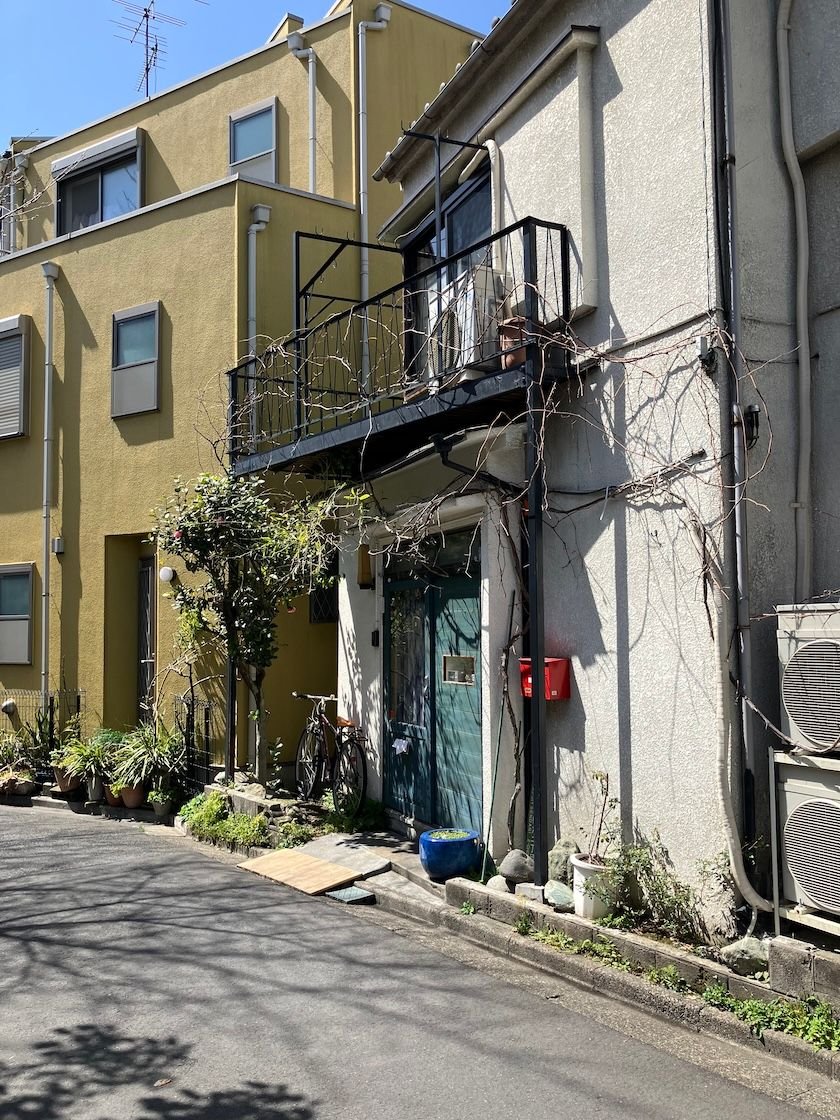
Yanaka street scene

Burmese turtle out for a walk in Yanaka

More Yanaka sights
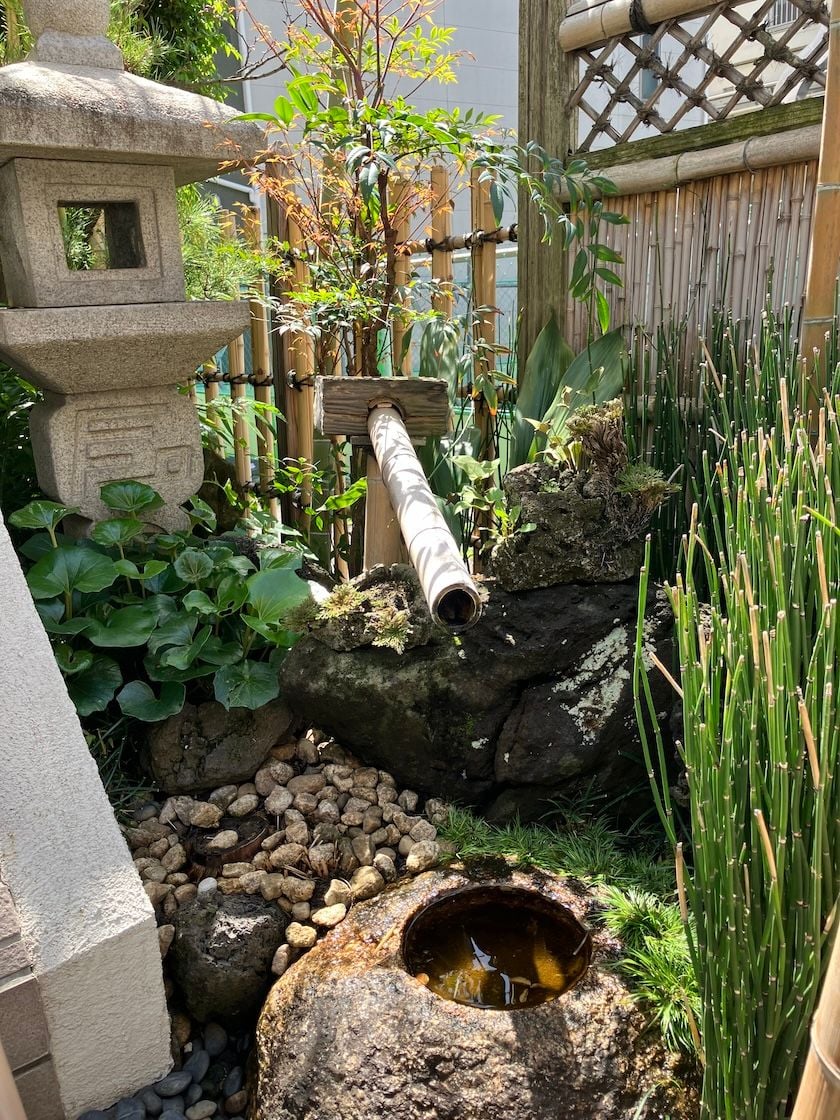
Yanaka - residential garden
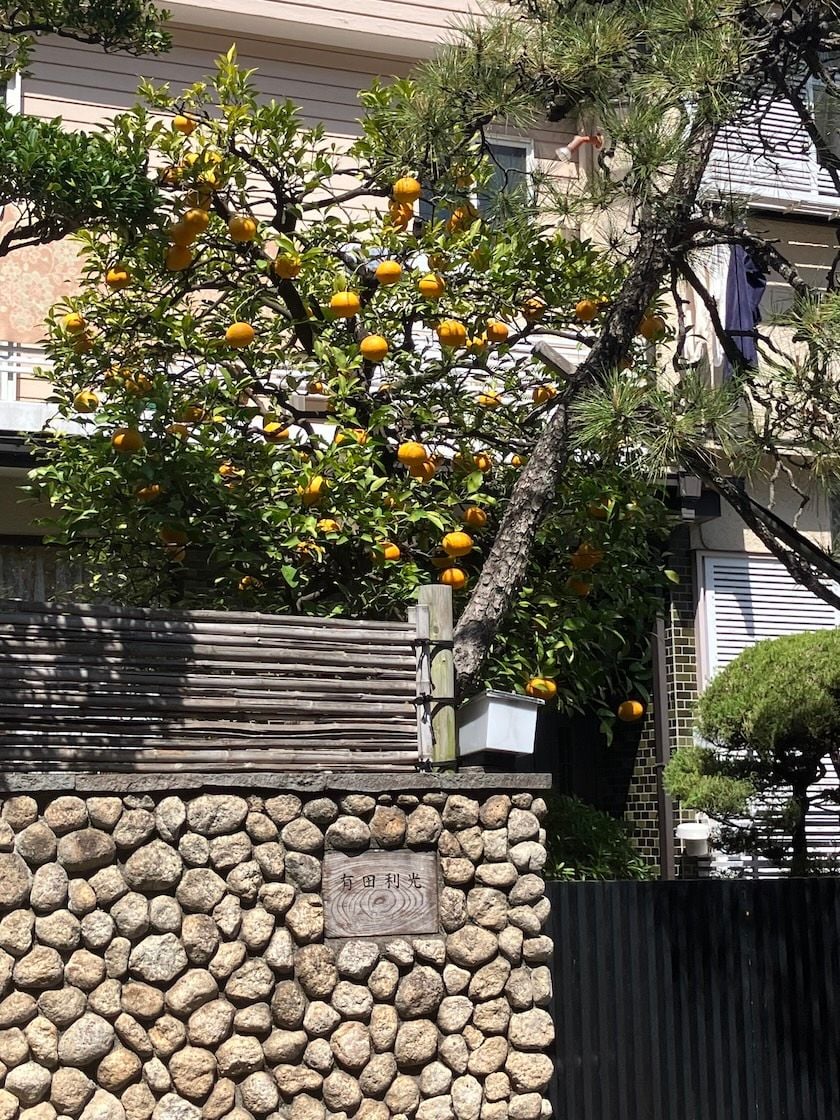
Yuzu tree in Yanaka yard
We went to the Nezu shrine which like all shrines is ornately decorated with gilt, colorful carved flowers and leaves, guarded by huge statues of the shrine’s deities and has an entrance gate before you get to the actual shrine. Our guide asked us to do the ritual bowing before we went through the gate and he explained the washing, praying, clapping, bowing protocol at the shrine. Mostly locals here. They have a huge azalea festival in May so the area around the shrine is planted with lots of rounded azaleas, but no blooms or buds in sight now.
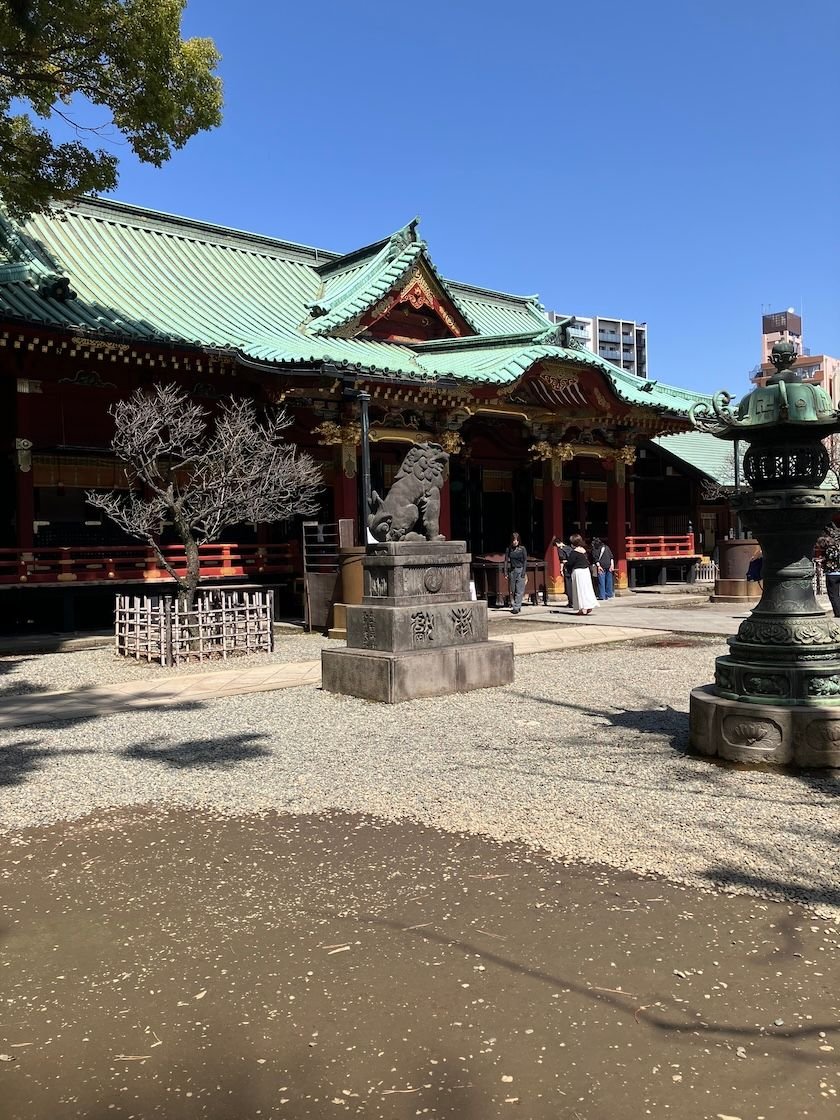
Nezu shrine

Nezu shrine

Nezu shrine
We were heading to Ueno Park but first came lunchtime; went to a huge department store with about six restaurants on the upper floors and we all went our own way for lunch. I decided to have Wagyu beef. They had an English menu on a tablet at each table, so I ordered shredded Wagyu beef with glass noodles, sticky rice, four cubes of soft tofu on top, and a very tasty soy and seasoning sauce. It also came with a very small green salad, and onion, chutney, and a clear soup, but I didn’t eat any of that since I knew the main course would be filling enough. The whole thing cost about $8 USD and it was good, but I should’ve thought twice about having such a filling meal when we still had more exploring ahead of us. I got to our meeting point in the department store early and took advantage of a fire extinguisher niche to sit down and rest.

Resting any place I could find (guide thought this was hilarious)
We took a public bus to Ueno Park which was a scene and a half. This is cherry tree season (although the cherry trees are late this year so there’s maybe one small tree in bloom for every eight trees that are not in bloom), and it’s a weekend, and it’s a beautiful day. So the swarm of humanity is mind-boggling to me. I have to admit that I was physically overwhelmed. Maybe it was the big lunch, maybe the heat and the sun, maybe the crowds – I don’t know, but I had to ask the tour leader to let me stand in the shade for five minutes, which of course he did with no problem. One of the other couples had bailed before lunch so at this point it was an Australian couple and me plus the two guides. Anyway, I caught my breath and we went into the park. There were crowds of people who had staked out their spots in the park, some as early as 5 AM. There’s no drunkenness here and everyone is just excited to see the cherry blossoms (which are basically non-existent) and have a picnic with their friends/family. Love the Japanese devotion to nature.
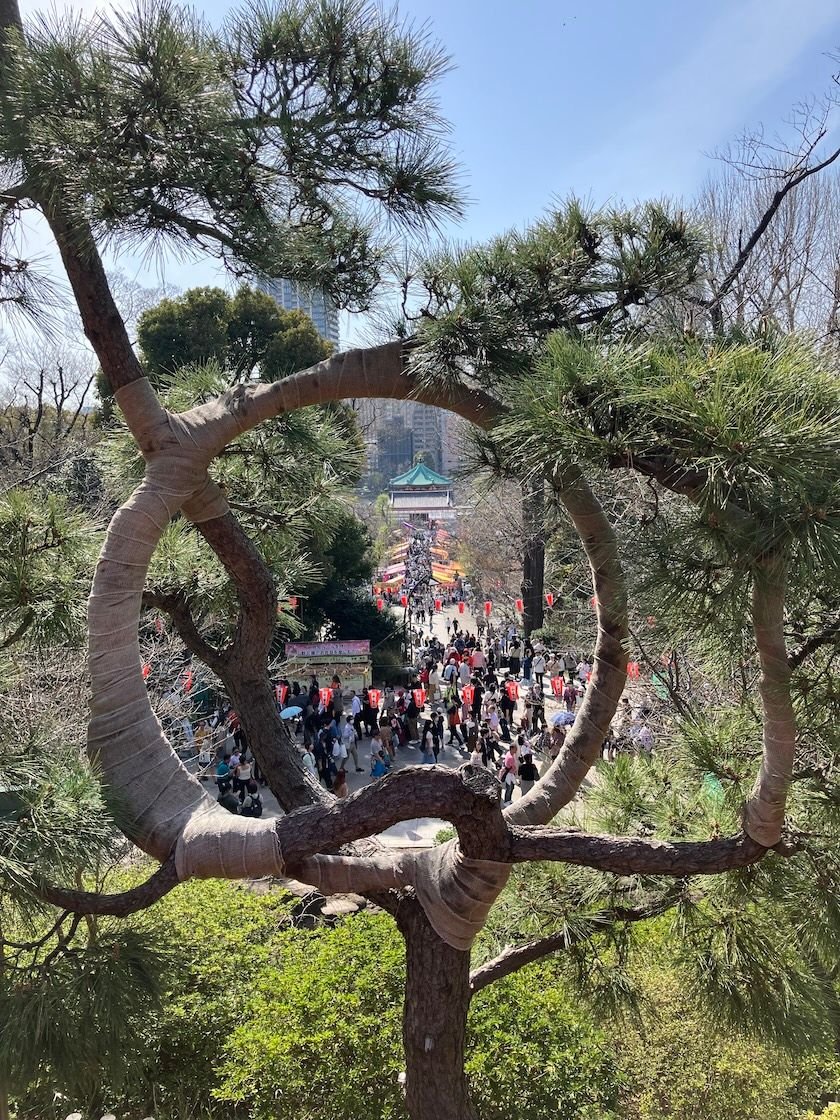
Ueno park

Variegated cherry tree - Ueno park
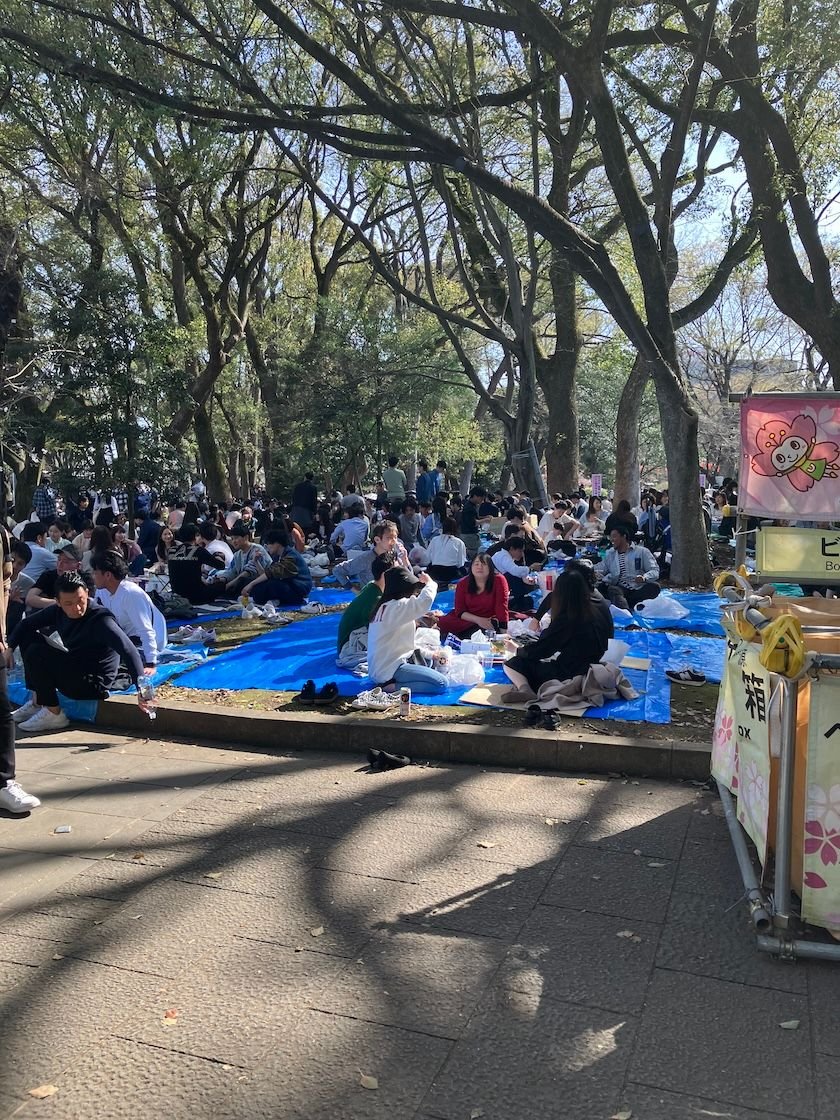
Crowds (but no cherry blooms...)

Crowds (but no cherry blooms...)
We all voted to leave the park & head to our final stop, Asakusa. This is an older area of town, one of the few left in Tokyo and it’s also very busy but manageable. We went to Senso-ji shrine which is a classic in terms of color, decor, protocols etc. and was quite busy with tourists.
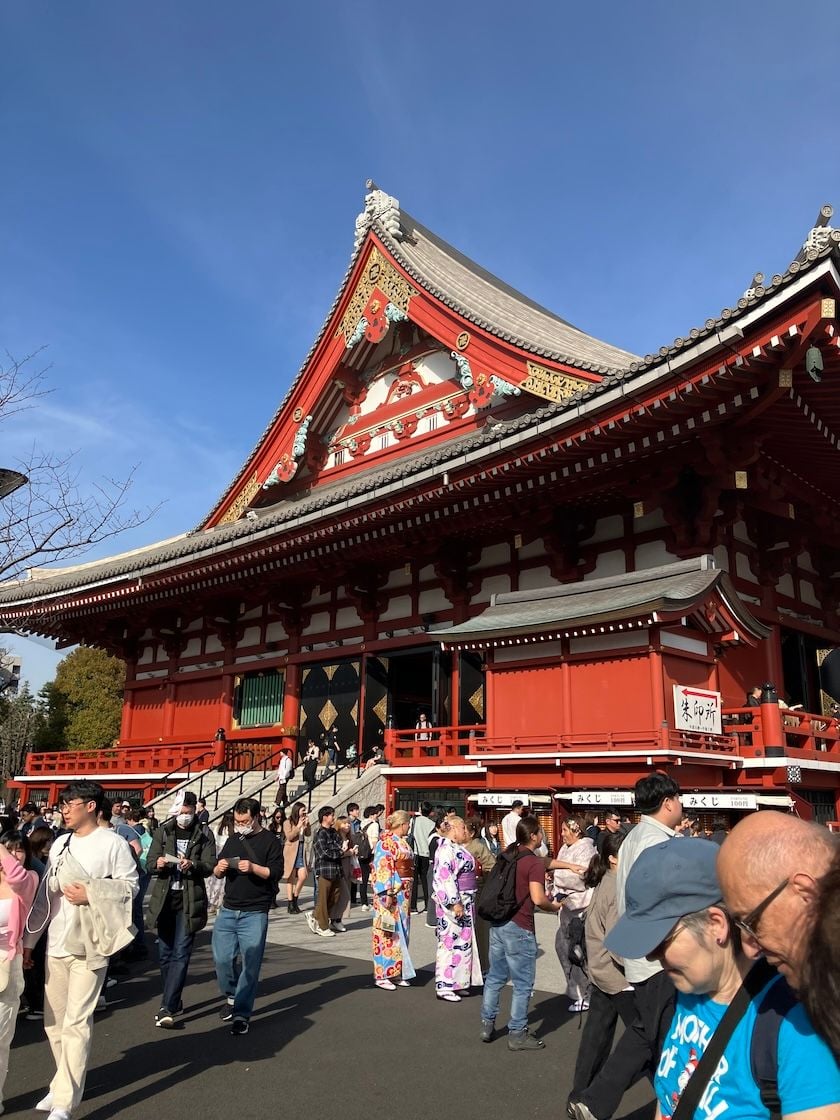
Senso-ji in Asakusa

Senso-ji in Asakusa
Then our guide took us on a winding path to what he said was his favorite spot: a store that sells supplies for tea ceremonies, but also can be booked for a ceremony. We hadn’t booked anything, but he wanted us to see the shop and maybe walk inside; the owner was very gracious and invited us in and allowed us to go into the tea ceremony room, where we sat on tatami mats, and the guide explained the culture to us. It was a pleasant surprise to have the owner bring in tea for each of us. I’m not really a tea drinker but this was cool tea in very small, thin, white China cups, and it was refreshing; it wasn’t like American tea and in fact, had a slightly smoky aftertaste; very interesting and I drank the whole cup because it’s polite but also because it was good. We asked our guide about when families have tea ceremonies & he said basically never; it’s a dying art and has become something like kabuki, Japanese drumming, etc. – a traditional hobby that some people have a specific interest in. Plenty of them do, enough to support sub industries around these hobbies (and certainly plenty of tourists want to go to a tea ceremony – sort of like having afternoon tea has become a big deal in the US for tween girls and their mothers). It was very nice of our leader to introduce us to this world and obviously he conveyed our interest in such a way that the shop owner welcomed us also; it was a very pleasant end to a wonderful day, and my overall perspective on the walking tour is much improved. Today, in addition to the sights being more appealing and comprehensible, our guide seemed much more confident and full of information and anecdotes.
It had been a full day so I was quite happy to spend the evening in my room enjoying my Yanaka bakery treats for dinner. In addition to catching up on emails and reading, I flipped around between Japanese channels; there were many reality shows so you don’t have to speak the language to get the drift of those; also have cooking shows which are also easy enough to follow.
Next….Yanaka again and Rikugien gardens.
It’s blue sky, sunny, and mid 70s. This is day two of the tour and our meeting point was the same place as yesterday, Nihonbashi. Because I got delayed at the front desk arranging my luggage storage and forwarding, I was afraid I wouldn’t have time to take the subway so took a cab to the meeting place. I was pleasantly surprised that at 8:30 on a Saturday morning it only cost me $17! One couple from yesterday decided not to come back so five of us plus the two guides ventured off. Today’s tour should cover “The city of the Edo townspeople: today, we gain a feel for the city of the Edokko, the townspeople, and their lives from the Edo Period, through the city’s tumultuous transition into the nation’s capital in the late nineteenth century, and up to the present day.”
We walked to the old red brick Tokyo station from 1914; on the way there, we passed several street bars and discussed the drinking culture for company workers. In the past, employees felt like they had to go out drinking each night with their colleagues and, more importantly, their bosses. Our guide explained that has changed drastically and is no longer widely followed; he said that most workers under 35 want to go home at night.

Tokyo Train Station, circa 1914

Interior of old part of the train station

Dome in old part of the train station
We took the JR line to Nippori, which is in a north western residential section of Tokyo called Yanaka. This is an old area that was on my list to see, so I’m happy we’re doing it with the tour. As soon as we walked out of the train station, I thought this is my kind of place – low buildings, a combination of homes and small shops and trees. This is an area that local people live in, although it’s gotten expensive and is becoming touristy but it’s not there yet.
Our first stop was a public cemetery (most cemeteries are owned by the temples). Very interesting since the styles are so different from western ones; this is a very active cemetery, and if plots are not maintained, and/or the annual subscription payments are not made for 2 to 3 years, the city takes back the plot and sells it to someone else. Most monuments are polished gray marble, but there are some that are rocks; we saw a grave area for a famous sumo personage who was the first wrestler to come to the US - he met President Grant at the White House. When he died, other sumo wrestlers contributed funds for a fancy graveyard site and inscribed stone wall pillars to commemorate him and his feats. Families can hire a someone to keep their ancestors’ graves tidy; we saw a lady there with her apron, kerchief and gloves sweeping the graves and surrounding area with a twig brush, throwing away dead flowers, removing twigs, leaves, etc. and checking it off in her little notebook before she wheeled her bike to the next one. I was interested that right next to the cemetery was a batting cage and a father throwing pitches to his young son; talk about an obvious juxtaposition of youth and the dead. 🙄

Famous sumo wrestler's grave

Beer alley in Yanaka

Yanaka front door sight
Then we walked down side roads, passing galleries, and lots of interesting little shops. We also went past a sculpture museum that I will come back to tomorrow. The Yanaka Ginza is a 200 meter stretch of the street which is a shopping area; the stores have stalls in front of their stores where they sell their products; these really seem to be local shops with local goods. I bought some cool 3-D cards from the man who actually made them, some absolutely scrumptious pastries (as an aside, there are great bakeries in Tokyo that have western style pastries that are buttery, sugary, and not too sweet). In addition to sweet items, they also sell savory – cheese stuffed bread, mini pizza slices, ham and cheese croissant, etc. so I bought a bunch of those things too (planning ahead for dinner in my room). There were a couple of stores I walked past that I would have spent time in, but we are on a schedule😉. I got to the bottom of the street before the other folks and noticed a food stand right there that seem to be selling fried chicken; I had read that fried chicken is extremely popular in Japan and it’s not breaded, instead they do some kind of a brine soak involving soy sauce and various spices, and I hadn’t had breakfast so for •250 ($1.65) I bought a cup containing five good-sized pieces of chicken with a skewer. Boy oh boy, was that good! Yowza. Not greasy, tender, flavorful, and the funny thing is that I asked the guy behind the counter (and this is a shoestring outfit – no fancy equipment or finishings here) if it was chicken, and he said yes. As I was buying it, he asked where I was from so I said the US and he said what state so I said Connecticut, and he actually knew where it was and said he’d been there. So now I had to have a conversation because I was intrigued. He explained that he had been to Maine, New Hampshire, and Boston and lots of other states (I guess Connecticut didn’t have anything noteworthy for him to remember😀
 . He told me that he had slept in an airport waiting for a flight because he didn’t have any money for a hotel and the airport police told him to move along so we laughed a bit about that. A nice and unexpected interaction. (Funnily, the tour group seemed impressed - or shocked - that I had gotten chicken at 11 o’clock in the morning and I think they wish they had gotten some too.)
. He told me that he had slept in an airport waiting for a flight because he didn’t have any money for a hotel and the airport police told him to move along so we laughed a bit about that. A nice and unexpected interaction. (Funnily, the tour group seemed impressed - or shocked - that I had gotten chicken at 11 o’clock in the morning and I think they wish they had gotten some too.)We kept walking down narrow alleys, behind homes, down beer alleys, and around snaking roads. He kept a fairly steady pace, so I couldn’t dawdle like I normally would, but my eyes were ricocheting from tops of buildings, doorways, mini-shrines next to front doors, flowers, and on and on. A mid 20s woman had taken her Burmese turtle out for a walk and of course we stopped to look at it and talk to her; the funniest thing was the reaction of other people walking by or riding their bikes, who literally did a double take – I’ve never seen that. Also saw some funny little cars, like smart cars, but not. The driver stopped and got out of his car so we could look at them and then other folks walking by did the same. Saw a Yuzu tree in someone’s front yard; I’ve never seen a Yuzu in real life, but they use it all the time in the cooking shows. We also stopped near a shrine that is closed to the public but two doors away was a temple that is open. We were heading off to the next site and I had already decided that I was coming back to this area tomorrow morning and will go to the sculpture museum, the temple, and, of course buy more chicken!

Yanaka street scene

Burmese turtle out for a walk in Yanaka

More Yanaka sights

Yanaka - residential garden

Yuzu tree in Yanaka yard
We went to the Nezu shrine which like all shrines is ornately decorated with gilt, colorful carved flowers and leaves, guarded by huge statues of the shrine’s deities and has an entrance gate before you get to the actual shrine. Our guide asked us to do the ritual bowing before we went through the gate and he explained the washing, praying, clapping, bowing protocol at the shrine. Mostly locals here. They have a huge azalea festival in May so the area around the shrine is planted with lots of rounded azaleas, but no blooms or buds in sight now.

Nezu shrine

Nezu shrine

Nezu shrine
We were heading to Ueno Park but first came lunchtime; went to a huge department store with about six restaurants on the upper floors and we all went our own way for lunch. I decided to have Wagyu beef. They had an English menu on a tablet at each table, so I ordered shredded Wagyu beef with glass noodles, sticky rice, four cubes of soft tofu on top, and a very tasty soy and seasoning sauce. It also came with a very small green salad, and onion, chutney, and a clear soup, but I didn’t eat any of that since I knew the main course would be filling enough. The whole thing cost about $8 USD and it was good, but I should’ve thought twice about having such a filling meal when we still had more exploring ahead of us. I got to our meeting point in the department store early and took advantage of a fire extinguisher niche to sit down and rest.

Resting any place I could find (guide thought this was hilarious)
We took a public bus to Ueno Park which was a scene and a half. This is cherry tree season (although the cherry trees are late this year so there’s maybe one small tree in bloom for every eight trees that are not in bloom), and it’s a weekend, and it’s a beautiful day. So the swarm of humanity is mind-boggling to me. I have to admit that I was physically overwhelmed. Maybe it was the big lunch, maybe the heat and the sun, maybe the crowds – I don’t know, but I had to ask the tour leader to let me stand in the shade for five minutes, which of course he did with no problem. One of the other couples had bailed before lunch so at this point it was an Australian couple and me plus the two guides. Anyway, I caught my breath and we went into the park. There were crowds of people who had staked out their spots in the park, some as early as 5 AM. There’s no drunkenness here and everyone is just excited to see the cherry blossoms (which are basically non-existent) and have a picnic with their friends/family. Love the Japanese devotion to nature.

Ueno park

Variegated cherry tree - Ueno park

Crowds (but no cherry blooms...)

Crowds (but no cherry blooms...)
We all voted to leave the park & head to our final stop, Asakusa. This is an older area of town, one of the few left in Tokyo and it’s also very busy but manageable. We went to Senso-ji shrine which is a classic in terms of color, decor, protocols etc. and was quite busy with tourists.

Senso-ji in Asakusa

Senso-ji in Asakusa
Then our guide took us on a winding path to what he said was his favorite spot: a store that sells supplies for tea ceremonies, but also can be booked for a ceremony. We hadn’t booked anything, but he wanted us to see the shop and maybe walk inside; the owner was very gracious and invited us in and allowed us to go into the tea ceremony room, where we sat on tatami mats, and the guide explained the culture to us. It was a pleasant surprise to have the owner bring in tea for each of us. I’m not really a tea drinker but this was cool tea in very small, thin, white China cups, and it was refreshing; it wasn’t like American tea and in fact, had a slightly smoky aftertaste; very interesting and I drank the whole cup because it’s polite but also because it was good. We asked our guide about when families have tea ceremonies & he said basically never; it’s a dying art and has become something like kabuki, Japanese drumming, etc. – a traditional hobby that some people have a specific interest in. Plenty of them do, enough to support sub industries around these hobbies (and certainly plenty of tourists want to go to a tea ceremony – sort of like having afternoon tea has become a big deal in the US for tween girls and their mothers). It was very nice of our leader to introduce us to this world and obviously he conveyed our interest in such a way that the shop owner welcomed us also; it was a very pleasant end to a wonderful day, and my overall perspective on the walking tour is much improved. Today, in addition to the sights being more appealing and comprehensible, our guide seemed much more confident and full of information and anecdotes.
It had been a full day so I was quite happy to spend the evening in my room enjoying my Yanaka bakery treats for dinner. In addition to catching up on emails and reading, I flipped around between Japanese channels; there were many reality shows so you don’t have to speak the language to get the drift of those; also have cooking shows which are also easy enough to follow.
Next….Yanaka again and Rikugien gardens.
#4
Looking forward to reading this - we’re in Greece right now so I’ll read when I have some time. But it’s fun to read about the places I’ve been and I’m glad you were happy with my recommendations!
Paule
Paule
#5
Join Date: Jul 2023
Posts: 47
Likes: 0
Received 0 Likes
on
0 Posts
I'm glad the tour got better on the second day and you seemed to really connect with the guide. Yanaka sounds charming - I love those tiny neighborhoods tucked within big cities. And what a treat to try fried chicken and chat with the owner. It's really special when you get those unexpected personal interactions on travels. Thanks for sharing all the photos too. Can't wait to read about your next destinations...
#7
Original Poster
Join Date: Sep 2005
Posts: 499
Likes: 0
Received 0 Likes
on
0 Posts
Day 4 Ė Tokyo (March 31)
Another sunny and hot (81) day🥵 This is my last day in Tokyo before heading via train to Matsumoto and I had a long list of places to see, but given the heat and my creaky knee, I cut it down to a reasonable few. I went back to Yanaka, which we visited yesterday because I wanted to go to the sculpture museum and buy some more street fried chicken!
I spent two hours at the Asakura Museum of Sculpture and what was interesting aside from the artwork was the architecture; the sculptor built this as his studio and classroom, since he taught younger artists, and it was his family residence. For his studio, he combined silk threads with a wheat colored paint to give the walls texture and give it a warm feeling. He had a library full of art books from floor to ceiling (many in English); when his mentor passed away, his entire collection of art books was sold to a secondhand shop, when the sculptor heard about this he was appalled and mortgaged his house in order to buy all of the books and they are now in his museum. He designed a beautiful courtyard garden which was mostly water and large rocks with a few graceful trees; would be soothing and hypnotic to watch and listen to. The residential area is primarily one floor of cedar beams and lattice, sliding windows to the courtyard with sliding doors between the rooms so they could be opened as one large space. Various niches for a decorative scroll or object and tatami mats on the floor. Some of the Japanese visitors to the museum were sitting on the floor, enjoying the courtyard view, but my problem is that getting down to the floor and sitting comfortably is an issue, not to mention getting up again Ė definitely not graceful - so I stayed upright. The museum docents were very helpful and those who spoke English were happy to share insights about the rooms, dťcor and history (there were detailed English descriptions in each room).

Garden courtyard Asukura Sculpture Museum
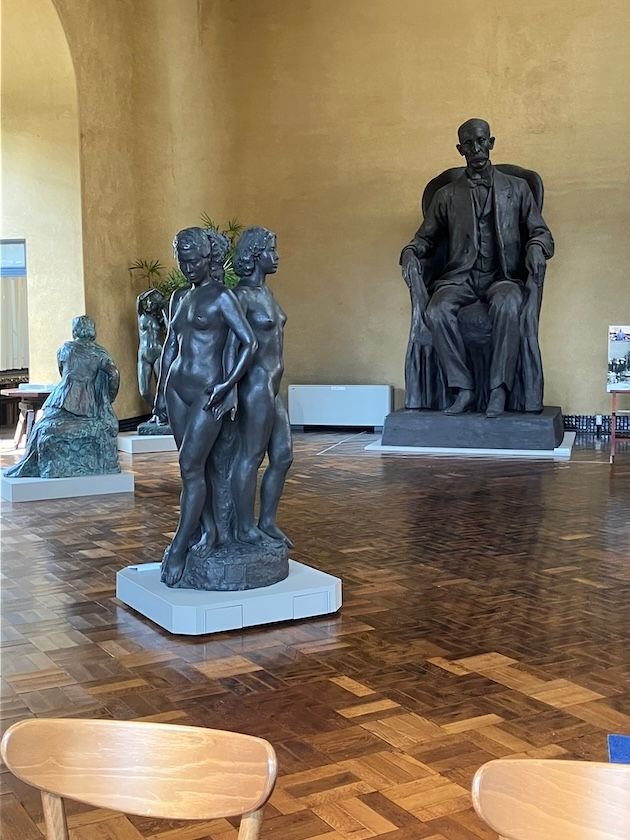
Asukura Sculpture Museum
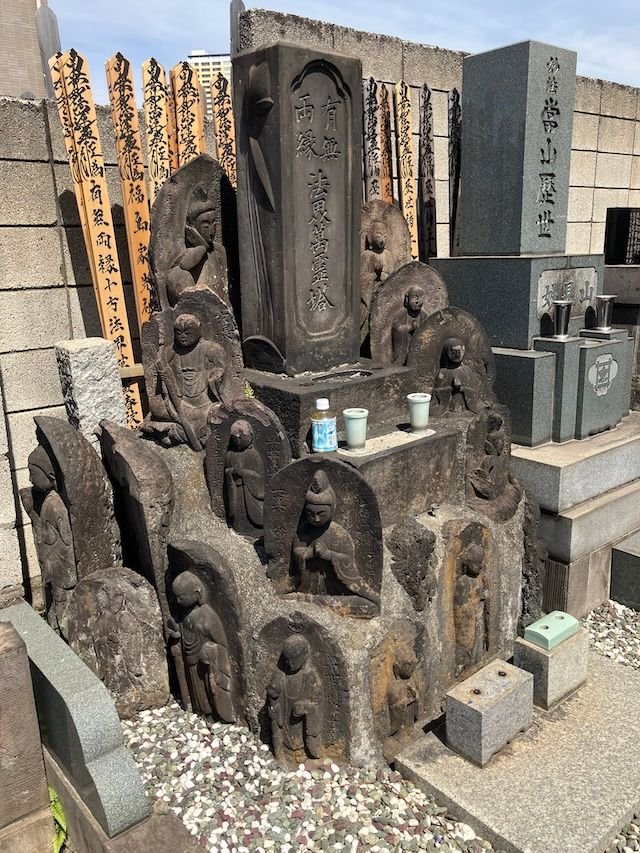
Yanaka cemetery
The whole area was much busier than yesterday, so Iím glad we came the day before; I went back to the bakery and later bought my chicken (the guy remembered me which was fun); I walked around two more cemeteries and popped into two temple grounds.

Yanaka street scene
I wanted to go to Rikugien gardens, which is a bit out of the way but famous; I knew it would be crowded because of it was a Sunday, warm and possible cherry blossoms, but I persevered. I got to the entrance and the line was so long I decided to give up but I loitered for a while trying to figure out where I would go instead and after 20 minutes, the line had gone down significantly so since I was there, I went in. Itís another garden originally created by a feudal Shogun and designed as a strolling park, so thereís a man-made lake surrounded by paths with some islands in the middle, which are planted with Japanese pines, a few stone bridges, some man-made hills, some streams, etc.. Luckily, there are enough paths that people spread out so it wasnít wall-to-wall the way I thought it would be, although around the TWO cherry trees in bloom, you mightíve thought Taylor Swift was there because there were so many people gathered around looking at the tree and taking photos. Very little would induce me to stand in a crowd to take pictures of a treeÖ Just saying. However, lest you think Iím immune to nature, when I was in Japan in April 2019 it was prime cherry tree season and I reveled in seeing the trees in gardens and parks all over Japan. I took so many pictures of blossoms Ė up close, far away, through the branches, etc. I spent time picnicking on the grounds enjoying the trees and people watching. So the fact that this yearís Sakura season was delayed didnít bother me since I have wonderful memories.

Line at Rikugien garden
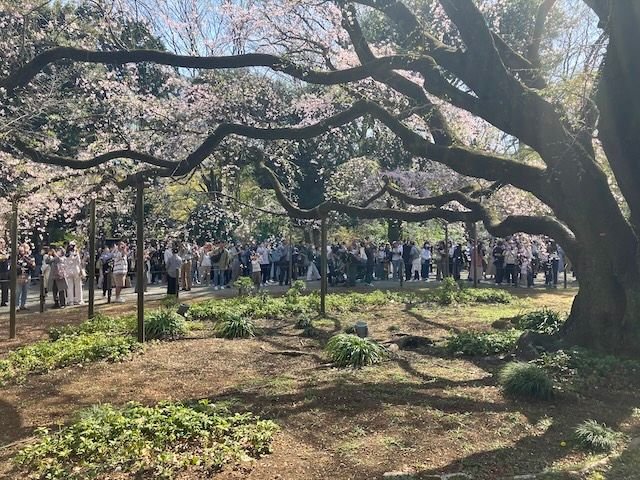
Photo opp at Rikugien garden
After about an hour there I headed back to my hotel. Bought two T-shirts & a crushable hat at the super gigantic Uniqlo clothes store on the corner. So many items looked appealing, but I donít need anything and the suitcase is already quite full.
Speaking of the suitcase, I had planned to have my large suitcase stored and then forwarded to Haneda airport so it would be waiting for me 10 days later. I packed the limited clothing & toiletries I would need, along with Shogun and another book in a daypack. I had emailed the hotel before my trip asking if they could arrange storage and forwarding of my luggage which they confirmed. I used the takubin service last time I was in Japan to forward my suitcase to the hotels but that was same/next day service. I had researched the main luggage transfer companies (Yamato and Black Cat) and discovered that you cannot forward your luggage to the airport more than 7 days prior to your flight so the hotel agreed to hold my luggage and then forward it. The cost was $19 USD which was a small price to pay for the convenience! They gave me a receipt/claim check, tagged my suitcase and took it away. Job accomplished easily and a load of my mind thanks to this wonderful system and the very knowledgeable and helpful hotel staff.
I decided to have a real dinner tonight so went to Yoshinoya, rice bowl chain restaurant thatís across the street and had shredded beef over sticky rice with sautťed onions and various soy flavorings. It was tasty, about $5 USD. Note that in restaurants, Iíve learned to ask ďEnglish menu?Ē since many places do have one and by pointing, itís not difficult to order basic, set menu items.
Next...Train to Matsumoto, castle and more!
Another sunny and hot (81) day🥵 This is my last day in Tokyo before heading via train to Matsumoto and I had a long list of places to see, but given the heat and my creaky knee, I cut it down to a reasonable few. I went back to Yanaka, which we visited yesterday because I wanted to go to the sculpture museum and buy some more street fried chicken!
I spent two hours at the Asakura Museum of Sculpture and what was interesting aside from the artwork was the architecture; the sculptor built this as his studio and classroom, since he taught younger artists, and it was his family residence. For his studio, he combined silk threads with a wheat colored paint to give the walls texture and give it a warm feeling. He had a library full of art books from floor to ceiling (many in English); when his mentor passed away, his entire collection of art books was sold to a secondhand shop, when the sculptor heard about this he was appalled and mortgaged his house in order to buy all of the books and they are now in his museum. He designed a beautiful courtyard garden which was mostly water and large rocks with a few graceful trees; would be soothing and hypnotic to watch and listen to. The residential area is primarily one floor of cedar beams and lattice, sliding windows to the courtyard with sliding doors between the rooms so they could be opened as one large space. Various niches for a decorative scroll or object and tatami mats on the floor. Some of the Japanese visitors to the museum were sitting on the floor, enjoying the courtyard view, but my problem is that getting down to the floor and sitting comfortably is an issue, not to mention getting up again Ė definitely not graceful - so I stayed upright. The museum docents were very helpful and those who spoke English were happy to share insights about the rooms, dťcor and history (there were detailed English descriptions in each room).

Garden courtyard Asukura Sculpture Museum

Asukura Sculpture Museum

Yanaka cemetery
The whole area was much busier than yesterday, so Iím glad we came the day before; I went back to the bakery and later bought my chicken (the guy remembered me which was fun); I walked around two more cemeteries and popped into two temple grounds.

Yanaka street scene
I wanted to go to Rikugien gardens, which is a bit out of the way but famous; I knew it would be crowded because of it was a Sunday, warm and possible cherry blossoms, but I persevered. I got to the entrance and the line was so long I decided to give up but I loitered for a while trying to figure out where I would go instead and after 20 minutes, the line had gone down significantly so since I was there, I went in. Itís another garden originally created by a feudal Shogun and designed as a strolling park, so thereís a man-made lake surrounded by paths with some islands in the middle, which are planted with Japanese pines, a few stone bridges, some man-made hills, some streams, etc.. Luckily, there are enough paths that people spread out so it wasnít wall-to-wall the way I thought it would be, although around the TWO cherry trees in bloom, you mightíve thought Taylor Swift was there because there were so many people gathered around looking at the tree and taking photos. Very little would induce me to stand in a crowd to take pictures of a treeÖ Just saying. However, lest you think Iím immune to nature, when I was in Japan in April 2019 it was prime cherry tree season and I reveled in seeing the trees in gardens and parks all over Japan. I took so many pictures of blossoms Ė up close, far away, through the branches, etc. I spent time picnicking on the grounds enjoying the trees and people watching. So the fact that this yearís Sakura season was delayed didnít bother me since I have wonderful memories.

Line at Rikugien garden

Photo opp at Rikugien garden
After about an hour there I headed back to my hotel. Bought two T-shirts & a crushable hat at the super gigantic Uniqlo clothes store on the corner. So many items looked appealing, but I donít need anything and the suitcase is already quite full.
Speaking of the suitcase, I had planned to have my large suitcase stored and then forwarded to Haneda airport so it would be waiting for me 10 days later. I packed the limited clothing & toiletries I would need, along with Shogun and another book in a daypack. I had emailed the hotel before my trip asking if they could arrange storage and forwarding of my luggage which they confirmed. I used the takubin service last time I was in Japan to forward my suitcase to the hotels but that was same/next day service. I had researched the main luggage transfer companies (Yamato and Black Cat) and discovered that you cannot forward your luggage to the airport more than 7 days prior to your flight so the hotel agreed to hold my luggage and then forward it. The cost was $19 USD which was a small price to pay for the convenience! They gave me a receipt/claim check, tagged my suitcase and took it away. Job accomplished easily and a load of my mind thanks to this wonderful system and the very knowledgeable and helpful hotel staff.
I decided to have a real dinner tonight so went to Yoshinoya, rice bowl chain restaurant thatís across the street and had shredded beef over sticky rice with sautťed onions and various soy flavorings. It was tasty, about $5 USD. Note that in restaurants, Iíve learned to ask ďEnglish menu?Ē since many places do have one and by pointing, itís not difficult to order basic, set menu items.
Next...Train to Matsumoto, castle and more!
Last edited by vickiebypass; Apr 30th, 2024 at 08:19 PM. Reason: add sentence
#8
Join Date: Feb 2003
Posts: 3,226
Likes: 0
Received 0 Likes
on
0 Posts
Beef bowl lol. On my wife’s first trip with me to Tokyo I took her to eat gyudon for lunch. It was in the old Tsukiji fish market, walked through a warehouse down a dark back alleyway to the restaurant filled with workers in aprons and rubber boots. As we ate she looked around and said how on earth do you know about this place, but it was delicious and she ate every bit.
Enjoying your trip report and looking forward to hearing more adventures.
Enjoying your trip report and looking forward to hearing more adventures.
#9
Original Poster
Join Date: Sep 2005
Posts: 499
Likes: 0
Received 0 Likes
on
0 Posts
Day 5 – Tokyo to Matsumoto (April 1)
Since I’m leaving Tokyo, just a few personal observations…
I was impressed with how quiet trains, subways and streets are and the tour guide explained that a central credo is “do not inconvenience other people”, so they tend not to have conversations on public transportation either with each other or on their phone; they NEVER put their phone on speakerphone or FaceTime in public; there are no trash cans anywhere, not on streets, in stores, in train stations, in parks - NOWHERE! so you have to bring any litter home with you, which means all the public areas are clean; they are orderly about lining up, whether to board a train, waiting for a restaurant to open, standing in line to take a photo of a scenic site; the line for restrooms moves quite quickly, because as I was told “people don’t take a lot of time in there since there are others waiting”. On the streets and in public places, you tend not to get raucous, rowdy groups of people talking & laughing. The few times I did hear it, they were foreigners or Japanese tweens.
As I’ve found anywhere I travel, everyone was very helpful. When I asked a question, even if they weren’t fluent in English, they knew enough words to answer or they found someone else to help me or just pointed and smiled. Not only helpful but patient – it could get tiring constantly dealing w tourists but no-one showed any irritation and seemed focused on helping me enjoy my travels.
Japanese business workers are sharp dressers - full suits and very polished leather shoes. Women wear tailored dresses (to the neck) or skirts w tailored jacket and leather heels (not stilettos, but definitely heels). Men all wear dark suits - no tan, linen or seersucker😲. I’ve noticed something with the young men, under 30 I’d say: I can’t tell you how many I’ve seen using their phones as mirrors and finessing their long black bangs into points; this is in the evenings and they are dressed in their after hours clothes; their hair is short on sides and back but the front is angled and long. I wonder if they gel the points back during the day for a buttoned down work look and go wild at night?
Young girls, probably under 20s, are very fashion focused, and more avant-garde than the older business women; they wear lots of different outfits that have clearly been carefully put together, but one of the common features are very tall, clunky platform shoes – say 3 to 4 inch platforms. Often with kneesocks. They also have funky hairstyles. I really enjoyed observing their style and pride in achieving their look.
The walking tour leader showed us a love hotel where rooms are rented in two hour blocks. He explained that since homes are small, walls are thin, and a lot of people live in a home some people go to love hotels. I said oh so it’s married couples who want time alone and he hesitated (clearly I had the wrong end on this one) and said no. So I guess it’s people having affairs, young unmarrieds or maybe gay. After he mentioned this, I kept my eyes open and saw the logo in several other locations.
It’s not the norm to eat or drink in public places like streets, public transportation or tourist sights. The exception is if you buy something from a street front store or restaurant, you can stand outside the front door, eat your item and then leave.
Toilets are a marvel - not only are there many, many public toilets all over Japan, they are well-maintained, clean, and don’t smell. And the best thing is their washlet system - basically a built-in bidet. Toilets in hotels always have them, but so do toilets in train stations, museums, roadside street corners - practically everywhere. And the seats are heated so when you sit down, it’s nice and toasty😁
There are two PBS shows that piqued my interest in Japan and made me want to come: Journeys in Japan and Oishi Tokyo - both produced by NHK and available on the NHK website or PBS (or you could Google the show names and watch on your computer). These will really whet your appetite for Japan. In particular, they are what made me want to visit the countryside...
Off to Matsumoto
I took the Asakusa TX subway to Akhibara, transferred to JR line to Shinjuku station which was initially confusing with a mass of signs and people. But I stepped to the side, read the signs and followed the arrows and ended up across from the correct platform. This is the train to Matsumoto and I had bought a reserved seat back in Nagasaki for the 2.5 hour trip. Japanese trains are a wonder for lots of reasons: they’re on time, clean, toilets in every other car, decent size seats, and huge windows. They have a lighting system above each seat with lights indicating whether the seat is reserved, and if the light is red, it’s vacant, so anybody can sit in it; however, if someone has reserved that seat at some point during the trip, because there were a lot of stops, then the light turns yellow, and you have to vacate it. There are signs on the back of each seat asking you to be considerate of other passengers, and they specify keyboard noise; how funny is that? On most other trains in the world keyboard noise would be the least of the problems. As a visitor, I appreciate the Japanese focus on courtesy and not infringing upon others. I had brought Shogun but never opened it since I watched the scenery unfold. As the urban sprawl declined, there were more and more farming patches (not huge farms but either family or village owned); seeing the people working in the garden/farms; looking at the architectural styles of the houses was so interesting; and then the mountains started appearing and then they were snow-capped! I do like train travel.
Arrived in sunny but cooler Matsumoto around noon and went to the Tourist Info office in the train station (2nd floor, across from the train exit area). They were extremely helpful and I stopped in to see them each day for advice, train schedules and directions. Although I had researched draft itineraries for each day, I needed a map, suggestions for special events etc. and they were a fountain of information.
As soon as I walked out of the train station, I liked this place. Smaller scale (lower) than Tokyo, snow capped mountains next door, and uncrowded streets. The info ladies had marked a simple route to the Richmond Hotel Matsumoto which took about 10 minutes; there was so much to look at on the way there that my head was swiveling from side to side and up and down! My room wasn’t ready but I left my bag with them and headed out. A little excitement on my way out though - the escalator from the street up to first floor reception only runs in one direction, so I took the stairs down. I was about halfway down when I heard thump, kerplunk, a man shouting, and noise. I looked over the stair railing and saw legs going over a head backwards and luggage tumbling on the escalator. Of course, I have no clue what help is in Japanese, so I just shouted help twice, ran up the stairs, and waved at the front desk; to their credit they had already reacted when they heard me shouting and ran to the escalator and halted it; they helped an older man to his feet, resettled his glasses and picked up all his luggage. I smiled inside because he did what almost all of us do with something like that happens - we automatically say no, no I’m fine… It’s OK. But he was walking, so I guess he was fine.
On my way to Matsumoto Castle, I stopped for lunch in the Hangout Coffee cafť. Generally, there aren’t many restaurants that are open non-stop throughout the afternoon; most close at around 2:30/3:00 so I learned to pay attention (hence, the reason why I often bought takeaway sandwiches from bakeries for eating later). The Hangout Coffee cafť is on the 2nd floor and had a small sign on the street with an arrow; upstairs was spacious, staff was welcoming and I sat in a comfy sofa in front of the window. I had a sandwich – I don’t remember what kind but it was tasty and I enjoyed relaxing in the moment.

Manhole cover


Matsumoto Castle is very famous as it’s one of only six original castles of this age in Japan. It’s known as the black castle due to the black wood and is six stories in a graduating shape. I had read about free guide services, generally retired folks who like to practice their English and share their knowledge of history with visitors, and found their booth at the entrance to the castle grounds. I was assigned a trainee named Katsuman (man of peace). He was very nice and told me several times that his English is not so good and would I please speak slowly and clearly and not use big words. Which I was happy to do although his English was better than he gave himself credit for. He explained the design of the castle which was very interesting; because it was created as a fortress, that was its primary purpose. So there are all kinds of building techniques used to help prevent the castle from being overrun. First a big moat. Then a huge, heavy wooden gate; then a courtyard and an interior wall whose door is set off center from the main gate so that intruders couldn’t burst through the main gate and run straight to the castle door; they’d have to zigzag across the courtyard and archers from within the wall could pick them off.
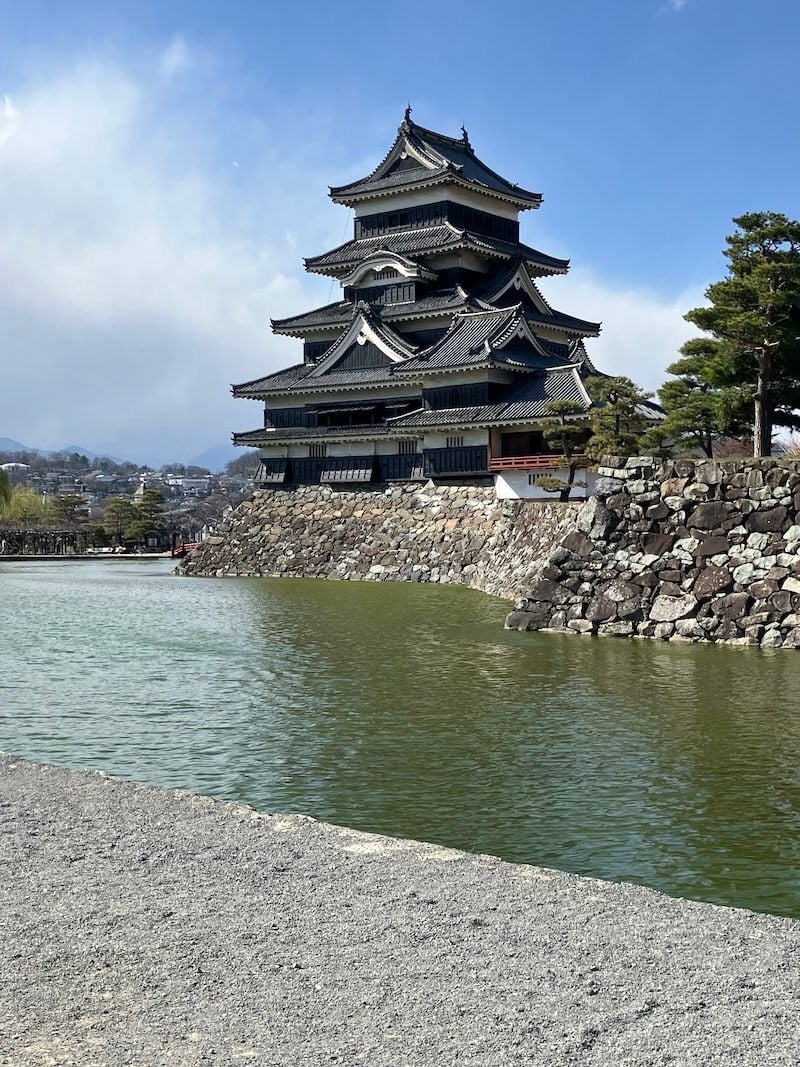
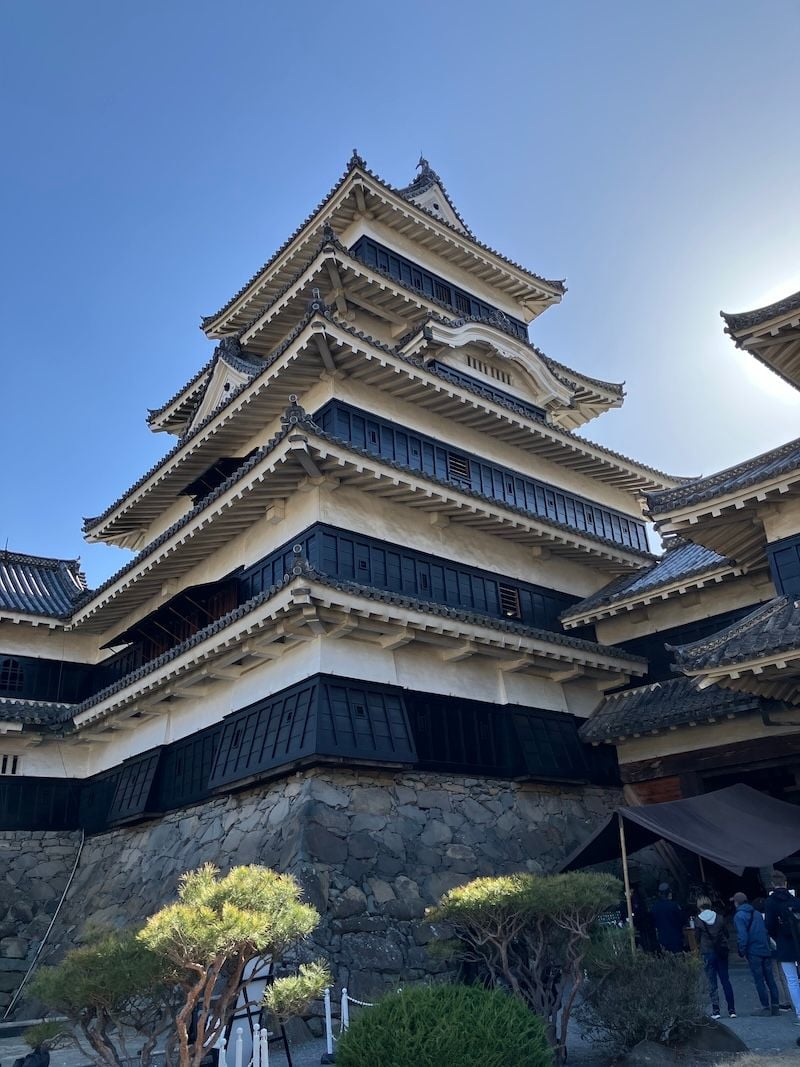 The actual 6 story castle was set away back from the interior wall. In the old days, this space was filled with buildings, but now only the outlines exist in a grassy area, along with unblooming cherry trees. Katsuman gave me lots of information but told me that guides are not allowed into the actual castle so he had to leave once we reached the castle entrance. It was a nice way to get more information about the castle than I might have from a book and I enjoyed talking with him; he’s a mountain climber in his spare time and has climbed most of the mountains surrounding Matsumoto. The castle entrance queue was very long, but this is one of six in the country, a world heritage site, UNESCO rated, and a bunch of other designations, so I waited and was extremely glad I did. You have to take your shoes off to enter and they give you a plastic bag to carry your shoes in. I remembered this from before, so luckily I had socks on. There is no furniture in the building since it’s a fortress and what you’re looking at is the structure. The floor is wide wood planks that are dark and shiny; the walls are huge stones supported with thick beams and are layered in such a way to create great strength. The ceilings are vaulted and you can see the crisscross of beaming.
The actual 6 story castle was set away back from the interior wall. In the old days, this space was filled with buildings, but now only the outlines exist in a grassy area, along with unblooming cherry trees. Katsuman gave me lots of information but told me that guides are not allowed into the actual castle so he had to leave once we reached the castle entrance. It was a nice way to get more information about the castle than I might have from a book and I enjoyed talking with him; he’s a mountain climber in his spare time and has climbed most of the mountains surrounding Matsumoto. The castle entrance queue was very long, but this is one of six in the country, a world heritage site, UNESCO rated, and a bunch of other designations, so I waited and was extremely glad I did. You have to take your shoes off to enter and they give you a plastic bag to carry your shoes in. I remembered this from before, so luckily I had socks on. There is no furniture in the building since it’s a fortress and what you’re looking at is the structure. The floor is wide wood planks that are dark and shiny; the walls are huge stones supported with thick beams and are layered in such a way to create great strength. The ceilings are vaulted and you can see the crisscross of beaming.
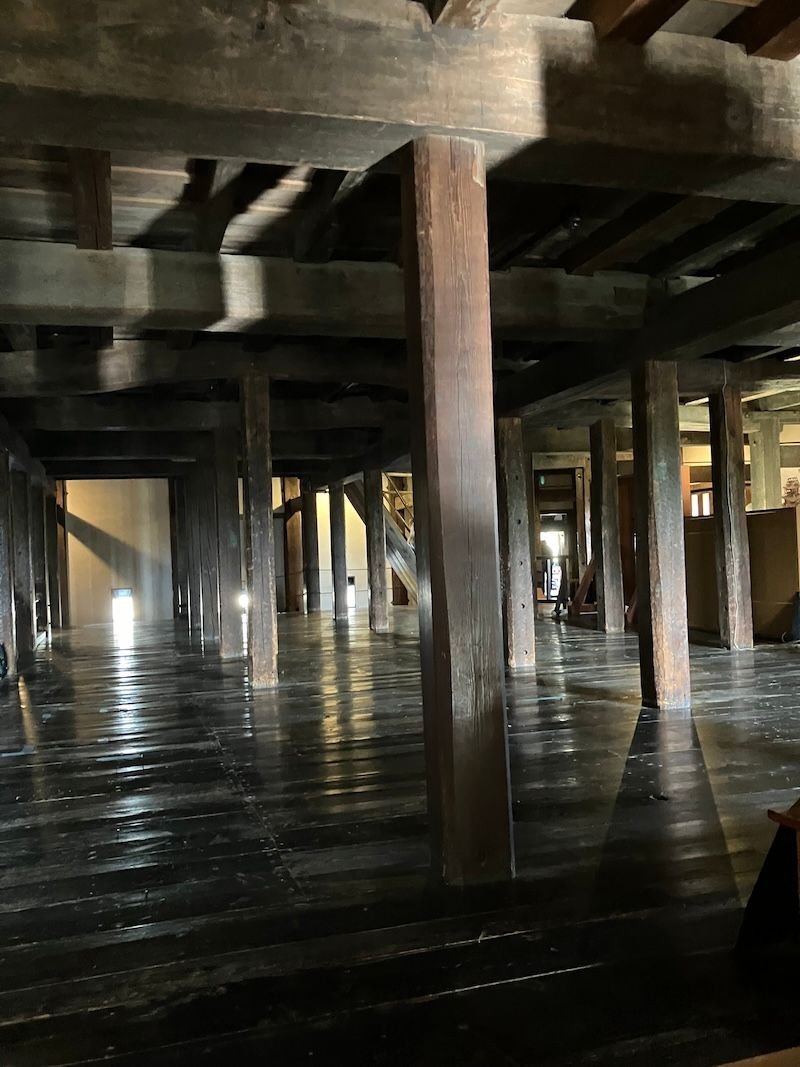
Interior, Matsumoto Castle
One of the signs explained that the outer hallway on each floor is called “warriors running passage” and is wider than other passages to allow samurai wearing full armor to run through the castle during attacks. Very practical and I could picture that perfectly! The castle has different shaped windows for archers and riflemen to attack intruders and sections where they could drop huge rocks on intruders trying to climb the castle walls. Another way to protect the Shogun, who would be on the very top floor of the castle, was to have staircases between floors offset in order to again make it difficult for intruders to go upstairs and give the samurai time to repel them. Those staircases were super steep, each step was very far apart, and each step was narrow but I climbed four or five sets of them between floors, holding onto the bamboo railings very tightly. However, the last staircase was even steeper, and it looked to me like you would go up, admire the view, and come right back down & my knees said no. Climbing down those staircases, I took the old lady approach of going sideways, step-by-step and grasping the railings, so made it down without slipping or falling…
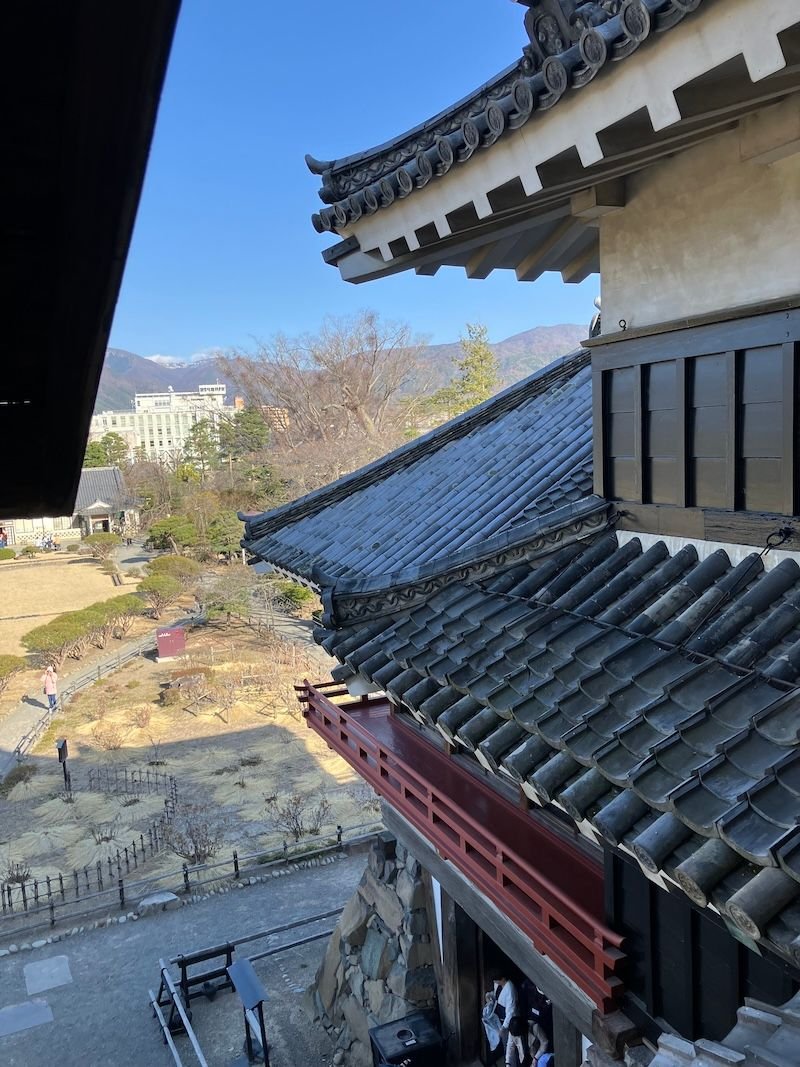
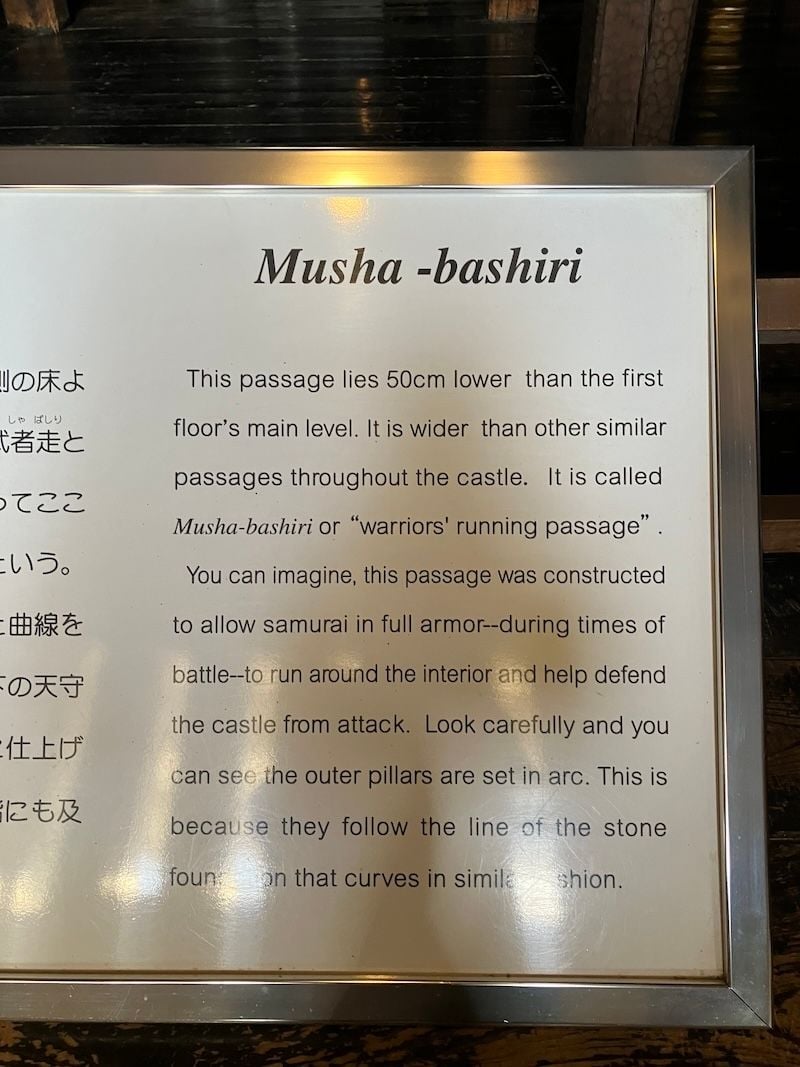

I went to the moon viewing room on the way down. This room with a vermilion red balcony was specially situated in order to observe fortuitous views of the moon. Katsuman had told me a saying “in the moon viewing room you can see three moons: the moon in the sky, the reflection of the moon in the moat, and the reflection of the moon in your cup of sake.”
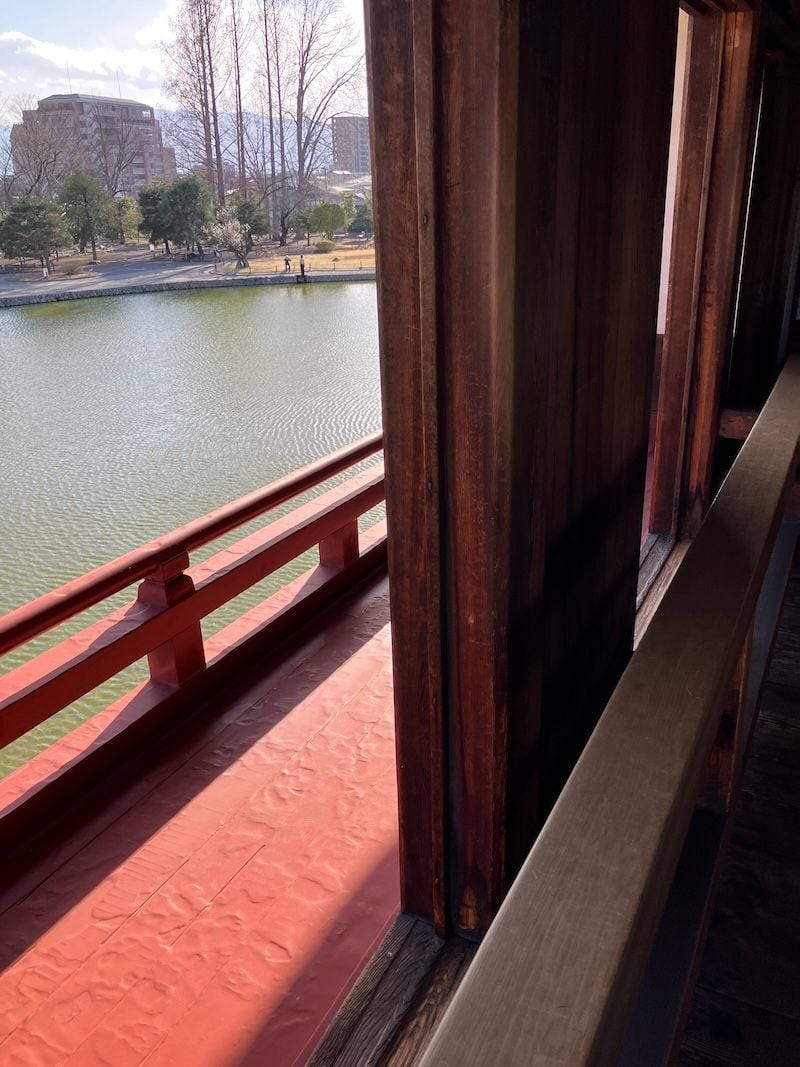
Balcony of moon viewing room; a propitious color.
Next .... more Matusumoto
Since I’m leaving Tokyo, just a few personal observations…
I was impressed with how quiet trains, subways and streets are and the tour guide explained that a central credo is “do not inconvenience other people”, so they tend not to have conversations on public transportation either with each other or on their phone; they NEVER put their phone on speakerphone or FaceTime in public; there are no trash cans anywhere, not on streets, in stores, in train stations, in parks - NOWHERE! so you have to bring any litter home with you, which means all the public areas are clean; they are orderly about lining up, whether to board a train, waiting for a restaurant to open, standing in line to take a photo of a scenic site; the line for restrooms moves quite quickly, because as I was told “people don’t take a lot of time in there since there are others waiting”. On the streets and in public places, you tend not to get raucous, rowdy groups of people talking & laughing. The few times I did hear it, they were foreigners or Japanese tweens.
As I’ve found anywhere I travel, everyone was very helpful. When I asked a question, even if they weren’t fluent in English, they knew enough words to answer or they found someone else to help me or just pointed and smiled. Not only helpful but patient – it could get tiring constantly dealing w tourists but no-one showed any irritation and seemed focused on helping me enjoy my travels.
Japanese business workers are sharp dressers - full suits and very polished leather shoes. Women wear tailored dresses (to the neck) or skirts w tailored jacket and leather heels (not stilettos, but definitely heels). Men all wear dark suits - no tan, linen or seersucker😲. I’ve noticed something with the young men, under 30 I’d say: I can’t tell you how many I’ve seen using their phones as mirrors and finessing their long black bangs into points; this is in the evenings and they are dressed in their after hours clothes; their hair is short on sides and back but the front is angled and long. I wonder if they gel the points back during the day for a buttoned down work look and go wild at night?
Young girls, probably under 20s, are very fashion focused, and more avant-garde than the older business women; they wear lots of different outfits that have clearly been carefully put together, but one of the common features are very tall, clunky platform shoes – say 3 to 4 inch platforms. Often with kneesocks. They also have funky hairstyles. I really enjoyed observing their style and pride in achieving their look.
The walking tour leader showed us a love hotel where rooms are rented in two hour blocks. He explained that since homes are small, walls are thin, and a lot of people live in a home some people go to love hotels. I said oh so it’s married couples who want time alone and he hesitated (clearly I had the wrong end on this one) and said no. So I guess it’s people having affairs, young unmarrieds or maybe gay. After he mentioned this, I kept my eyes open and saw the logo in several other locations.
It’s not the norm to eat or drink in public places like streets, public transportation or tourist sights. The exception is if you buy something from a street front store or restaurant, you can stand outside the front door, eat your item and then leave.
Toilets are a marvel - not only are there many, many public toilets all over Japan, they are well-maintained, clean, and don’t smell. And the best thing is their washlet system - basically a built-in bidet. Toilets in hotels always have them, but so do toilets in train stations, museums, roadside street corners - practically everywhere. And the seats are heated so when you sit down, it’s nice and toasty😁
There are two PBS shows that piqued my interest in Japan and made me want to come: Journeys in Japan and Oishi Tokyo - both produced by NHK and available on the NHK website or PBS (or you could Google the show names and watch on your computer). These will really whet your appetite for Japan. In particular, they are what made me want to visit the countryside...
Off to Matsumoto
I took the Asakusa TX subway to Akhibara, transferred to JR line to Shinjuku station which was initially confusing with a mass of signs and people. But I stepped to the side, read the signs and followed the arrows and ended up across from the correct platform. This is the train to Matsumoto and I had bought a reserved seat back in Nagasaki for the 2.5 hour trip. Japanese trains are a wonder for lots of reasons: they’re on time, clean, toilets in every other car, decent size seats, and huge windows. They have a lighting system above each seat with lights indicating whether the seat is reserved, and if the light is red, it’s vacant, so anybody can sit in it; however, if someone has reserved that seat at some point during the trip, because there were a lot of stops, then the light turns yellow, and you have to vacate it. There are signs on the back of each seat asking you to be considerate of other passengers, and they specify keyboard noise; how funny is that? On most other trains in the world keyboard noise would be the least of the problems. As a visitor, I appreciate the Japanese focus on courtesy and not infringing upon others. I had brought Shogun but never opened it since I watched the scenery unfold. As the urban sprawl declined, there were more and more farming patches (not huge farms but either family or village owned); seeing the people working in the garden/farms; looking at the architectural styles of the houses was so interesting; and then the mountains started appearing and then they were snow-capped! I do like train travel.
Arrived in sunny but cooler Matsumoto around noon and went to the Tourist Info office in the train station (2nd floor, across from the train exit area). They were extremely helpful and I stopped in to see them each day for advice, train schedules and directions. Although I had researched draft itineraries for each day, I needed a map, suggestions for special events etc. and they were a fountain of information.
As soon as I walked out of the train station, I liked this place. Smaller scale (lower) than Tokyo, snow capped mountains next door, and uncrowded streets. The info ladies had marked a simple route to the Richmond Hotel Matsumoto which took about 10 minutes; there was so much to look at on the way there that my head was swiveling from side to side and up and down! My room wasn’t ready but I left my bag with them and headed out. A little excitement on my way out though - the escalator from the street up to first floor reception only runs in one direction, so I took the stairs down. I was about halfway down when I heard thump, kerplunk, a man shouting, and noise. I looked over the stair railing and saw legs going over a head backwards and luggage tumbling on the escalator. Of course, I have no clue what help is in Japanese, so I just shouted help twice, ran up the stairs, and waved at the front desk; to their credit they had already reacted when they heard me shouting and ran to the escalator and halted it; they helped an older man to his feet, resettled his glasses and picked up all his luggage. I smiled inside because he did what almost all of us do with something like that happens - we automatically say no, no I’m fine… It’s OK. But he was walking, so I guess he was fine.
On my way to Matsumoto Castle, I stopped for lunch in the Hangout Coffee cafť. Generally, there aren’t many restaurants that are open non-stop throughout the afternoon; most close at around 2:30/3:00 so I learned to pay attention (hence, the reason why I often bought takeaway sandwiches from bakeries for eating later). The Hangout Coffee cafť is on the 2nd floor and had a small sign on the street with an arrow; upstairs was spacious, staff was welcoming and I sat in a comfy sofa in front of the window. I had a sandwich – I don’t remember what kind but it was tasty and I enjoyed relaxing in the moment.

Manhole cover


Matsumoto Castle is very famous as it’s one of only six original castles of this age in Japan. It’s known as the black castle due to the black wood and is six stories in a graduating shape. I had read about free guide services, generally retired folks who like to practice their English and share their knowledge of history with visitors, and found their booth at the entrance to the castle grounds. I was assigned a trainee named Katsuman (man of peace). He was very nice and told me several times that his English is not so good and would I please speak slowly and clearly and not use big words. Which I was happy to do although his English was better than he gave himself credit for. He explained the design of the castle which was very interesting; because it was created as a fortress, that was its primary purpose. So there are all kinds of building techniques used to help prevent the castle from being overrun. First a big moat. Then a huge, heavy wooden gate; then a courtyard and an interior wall whose door is set off center from the main gate so that intruders couldn’t burst through the main gate and run straight to the castle door; they’d have to zigzag across the courtyard and archers from within the wall could pick them off.

 The actual 6 story castle was set away back from the interior wall. In the old days, this space was filled with buildings, but now only the outlines exist in a grassy area, along with unblooming cherry trees. Katsuman gave me lots of information but told me that guides are not allowed into the actual castle so he had to leave once we reached the castle entrance. It was a nice way to get more information about the castle than I might have from a book and I enjoyed talking with him; he’s a mountain climber in his spare time and has climbed most of the mountains surrounding Matsumoto. The castle entrance queue was very long, but this is one of six in the country, a world heritage site, UNESCO rated, and a bunch of other designations, so I waited and was extremely glad I did. You have to take your shoes off to enter and they give you a plastic bag to carry your shoes in. I remembered this from before, so luckily I had socks on. There is no furniture in the building since it’s a fortress and what you’re looking at is the structure. The floor is wide wood planks that are dark and shiny; the walls are huge stones supported with thick beams and are layered in such a way to create great strength. The ceilings are vaulted and you can see the crisscross of beaming.
The actual 6 story castle was set away back from the interior wall. In the old days, this space was filled with buildings, but now only the outlines exist in a grassy area, along with unblooming cherry trees. Katsuman gave me lots of information but told me that guides are not allowed into the actual castle so he had to leave once we reached the castle entrance. It was a nice way to get more information about the castle than I might have from a book and I enjoyed talking with him; he’s a mountain climber in his spare time and has climbed most of the mountains surrounding Matsumoto. The castle entrance queue was very long, but this is one of six in the country, a world heritage site, UNESCO rated, and a bunch of other designations, so I waited and was extremely glad I did. You have to take your shoes off to enter and they give you a plastic bag to carry your shoes in. I remembered this from before, so luckily I had socks on. There is no furniture in the building since it’s a fortress and what you’re looking at is the structure. The floor is wide wood planks that are dark and shiny; the walls are huge stones supported with thick beams and are layered in such a way to create great strength. The ceilings are vaulted and you can see the crisscross of beaming. 
Interior, Matsumoto Castle
One of the signs explained that the outer hallway on each floor is called “warriors running passage” and is wider than other passages to allow samurai wearing full armor to run through the castle during attacks. Very practical and I could picture that perfectly! The castle has different shaped windows for archers and riflemen to attack intruders and sections where they could drop huge rocks on intruders trying to climb the castle walls. Another way to protect the Shogun, who would be on the very top floor of the castle, was to have staircases between floors offset in order to again make it difficult for intruders to go upstairs and give the samurai time to repel them. Those staircases were super steep, each step was very far apart, and each step was narrow but I climbed four or five sets of them between floors, holding onto the bamboo railings very tightly. However, the last staircase was even steeper, and it looked to me like you would go up, admire the view, and come right back down & my knees said no. Climbing down those staircases, I took the old lady approach of going sideways, step-by-step and grasping the railings, so made it down without slipping or falling…



I went to the moon viewing room on the way down. This room with a vermilion red balcony was specially situated in order to observe fortuitous views of the moon. Katsuman had told me a saying “in the moon viewing room you can see three moons: the moon in the sky, the reflection of the moon in the moat, and the reflection of the moon in your cup of sake.”

Balcony of moon viewing room; a propitious color.
Next .... more Matusumoto
#10
Original Poster
Join Date: Sep 2005
Posts: 499
Likes: 0
Received 0 Likes
on
0 Posts
I’m really enjoying Matsumoto! As a history geek, the castle struck with a chord with me and I could easily envision it’s usage throughout history. The town is great for wandering around and seeing lots of neat things like springs (e.g. the town is known its’ many springs and there’s a Spring Water Excursion map you can get from the tourist office), sculptures here & there, manhole covers and the winding water paths along the sidewalk (not sure what these are for, but they’re artistic, calming, and since there are a lot of benches, a lovely place to sit for a moment).
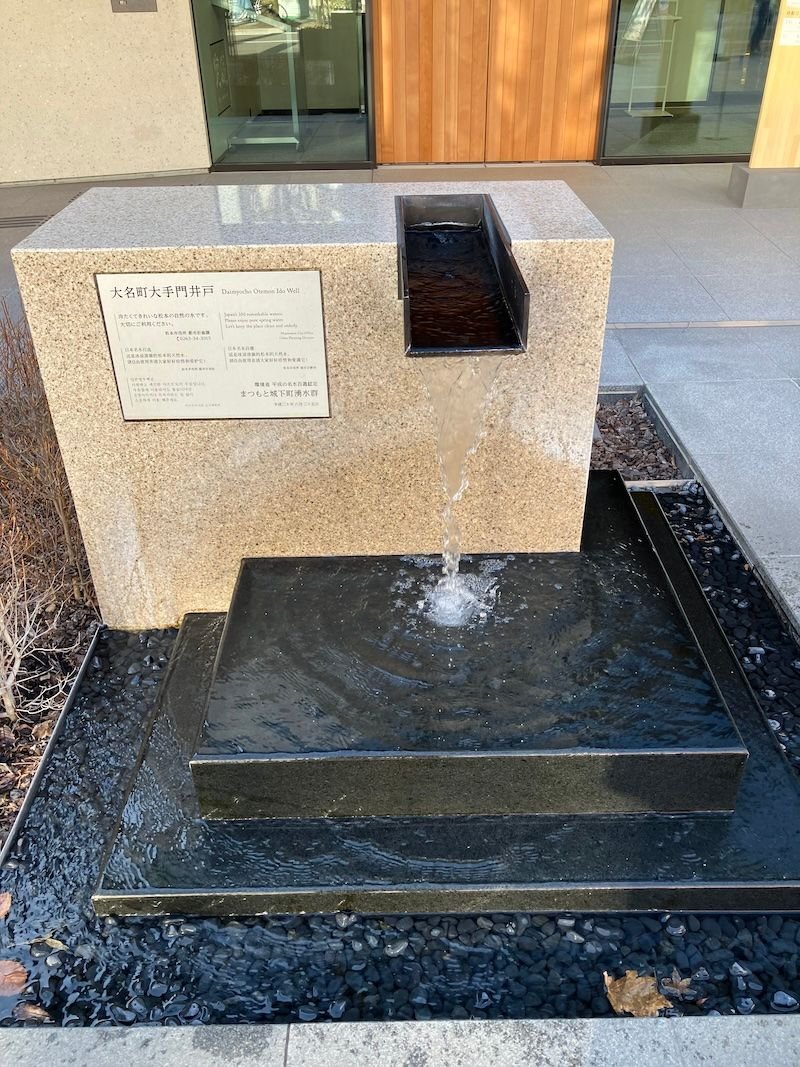
Spring in Matsumoto City
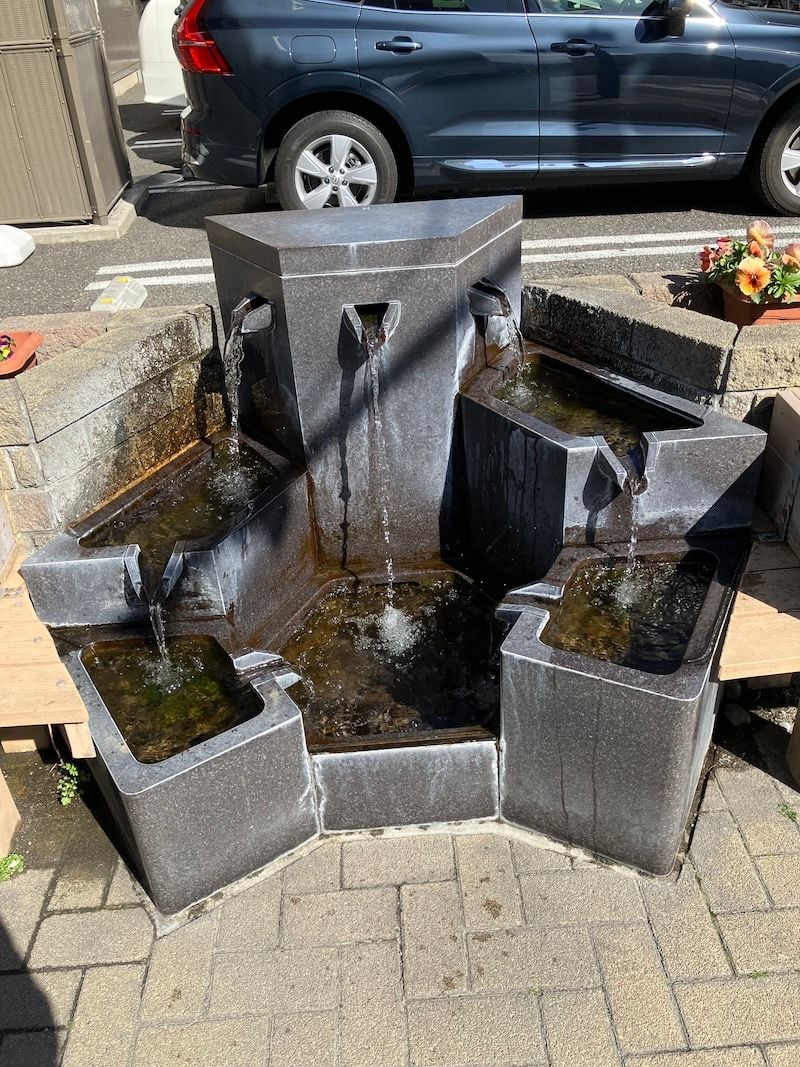
Spring in Matsumoto City

Waterway in Matusumoto City

I enjoyed Yohashira Shrine, near the castle, just before Nawate. This is a small but very active shrine used throughout the day by locals. Built during the Meiji period and dedicated to four Shinto deities, it’s thought to have special wish-granting properties and is a very beautiful yet peaceful spot.

Yohashira Shrine
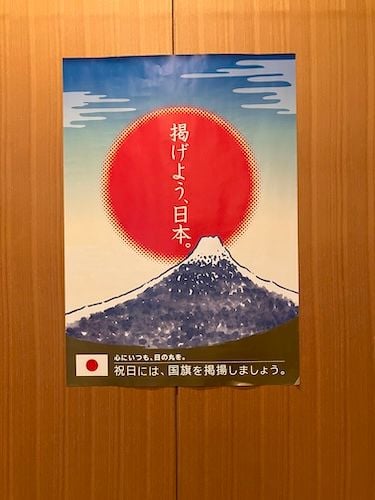
I liked this poster
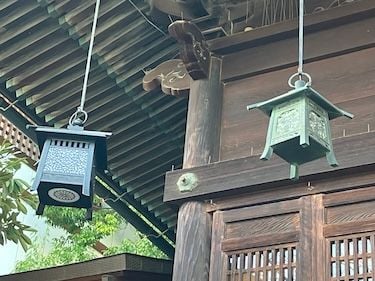
Yoshinara Temple

Yoshinara Temple
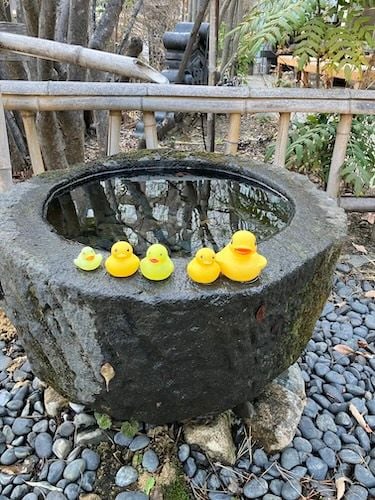
Yoshinara Temple
I had read about a local speciality, sanzoku-yaki which is a special type of fried chicken that’s become known as Matsumoto’s soul food. Made with chicken thighs or breasts, it is unusual since it’s marinated in a garlic and soy sauce mixture before being coated generously in potato starch and then deep fried. There were a couple of restaurants outside the train station that specialize in this dish so I sat at the counter and enjoyed every bit of the chicken.
Day 6 –Matsumoto (April 2)
It’s sunny and low 50s. I had a walking and culinary adventure today when I took a train to a nearby town, Azumino! My primary reason was to visit a wasabi farm and see more of the countryside along with several temples and shrines. Once again, the staff at the Masumoto Tourist Info center in the train station were super – they gave me the train schedule (one per hour, each way) and suggestions. It was a 30 minute train ride, and as soon as we were outside of Matsumoto, it started getting more agricultural and the mountains were closer. We passed through a number of small towns but I was entranced by those snowcapped mountains.
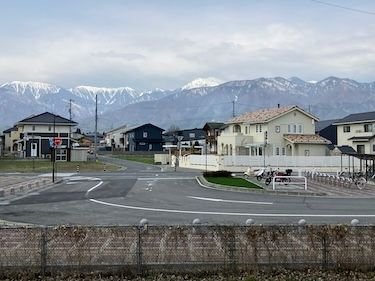
Azumino - mountain view from the Hokata train station
Once I arrived, I went to the local tourist info office (across the street from the train station) and got a map. They suggested I take a cab to the wasabi farm, but I wanted to visit a shrine and the temple that were on the way to the farm so I decided to walk since it was only a mile or so (bad idea!). This is a very small town so I enjoyed walking through the center since it was so different than Matsumoto. Very quickly I came to the Hataka Shinto shrine, set in a grove of very tall cedar trees. The grounds include a welcome center, a pavilion used for special ceremonies, the hall of worship where people make their offerings and follow prayer rituals outside and can go inside for special rituals or meetings with the monks and 3 small buildings which are where the deities are enshrined. All the buildings are made from cedar. The three small buildings are rebuilt every 20 years to the exact same specifications and since the reconstruction times are staggered, you can tell which of the three is the newest by the degree of weathering. The reason they do this is to ensure the ancient rituals and traditional shrine related architecture and techniques are passed down to each new generation.
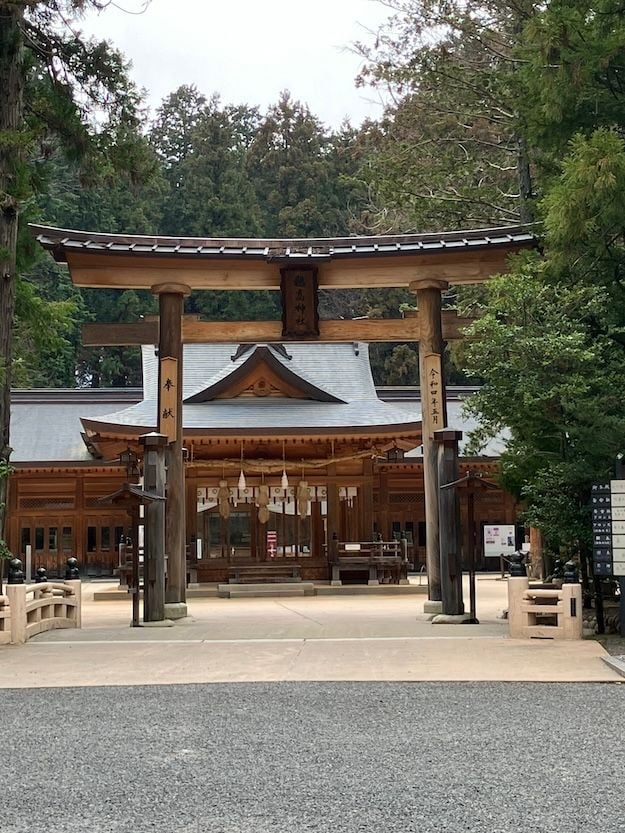
Hataka Shrine, Azumino
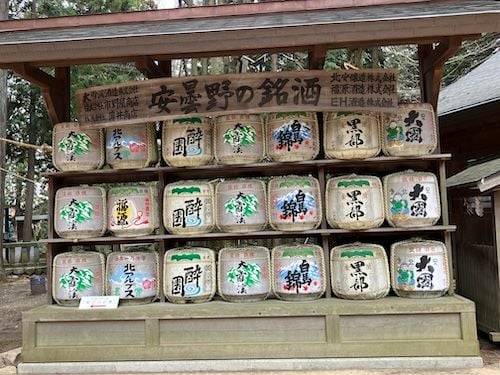
Sake barrels
This is a very active shrine but because the grounds are large, it felt very private (there were maybe 15 people there) and while I was there I stood outside, off to the side and peeked into the worship hall where I saw bits of a ceremony: a robed monk chanting on a raised platform and two sub monks (girls) assisting, and another monk using a big drum. Within the compound grounds, there were lots of carved stones, mini shrines, statuary, and a big wall of what I thought were lanterns, but then found out were sake barrels which aren’t wooden barrels like we envision, they are short and squat with a cloth covering. They were very decorative with mountain scenes on the fronts.
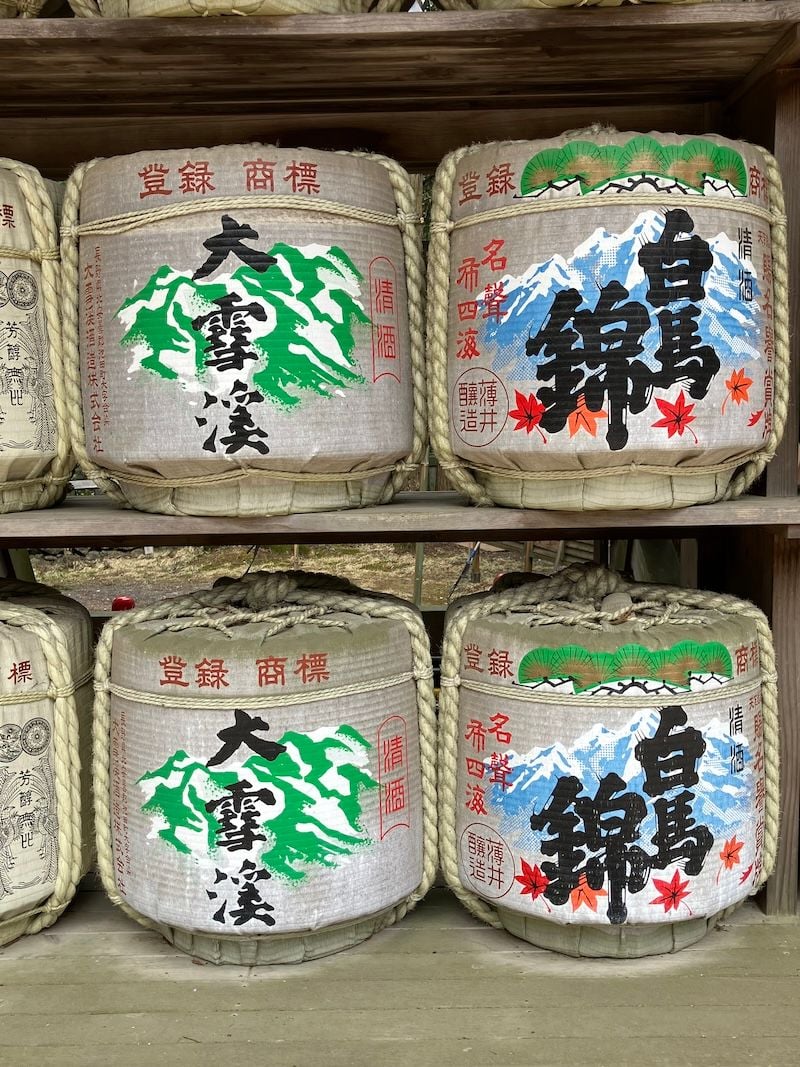
Sake barrels
The welcome center contained two large exhibit rooms, which initially perplexed me because they looked like large scale, crude dioramas of scenes from the past. Then I realized that these are floats used in annual processions to celebrate the deities. Each float was gigantic and told a different part of the story. Part of the display showed how the figures in the floats are carved from cedar trees and decorated. No information in English so I used Google translate which provides the basic gist.
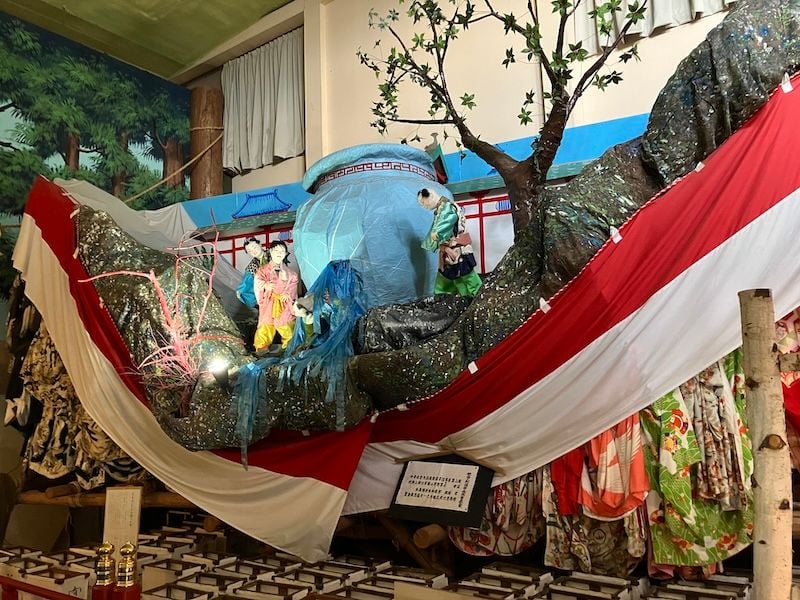
Float in shrine welcome center
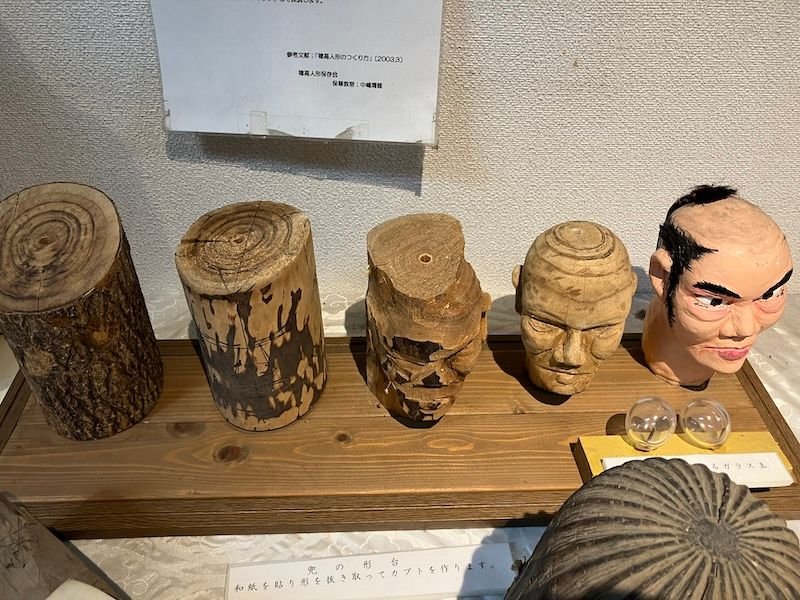
Exhibit of how float figures are carve
Throughout the village were irrigation channels, complete with gates/locks so that the water can be diverted as needed. So there’s a sound constant of rushing water as you walk along. I also saw a lot of dosojin which are Shinto deities who live in stone carvings placed at village boundaries, forks in the road and other key points. They’re about 4 ft tall, either a simple inscription, or a carving of human figures, usually a man and a woman. The dosojin are cared for by locals and each is unique, so an interesting quest to spot them.
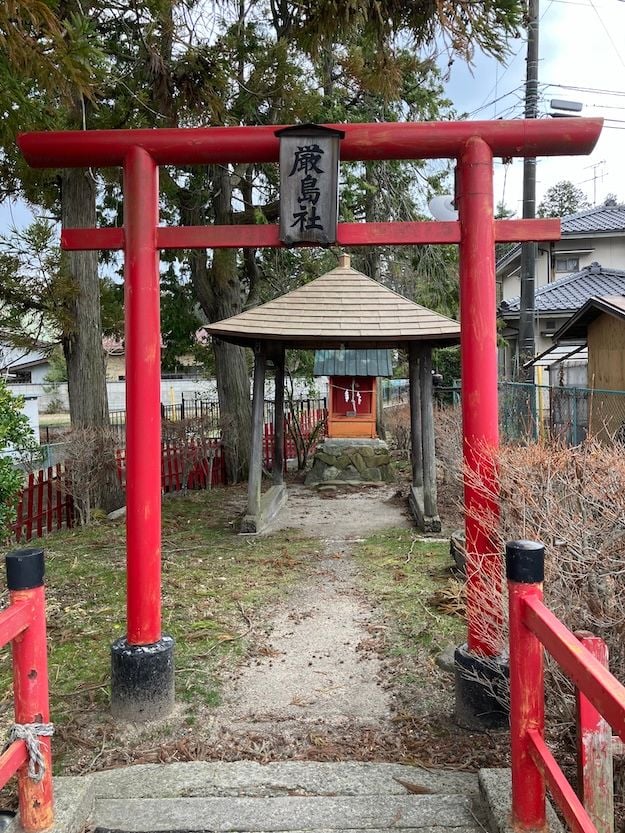
Mini shrine along the street

Dosijin
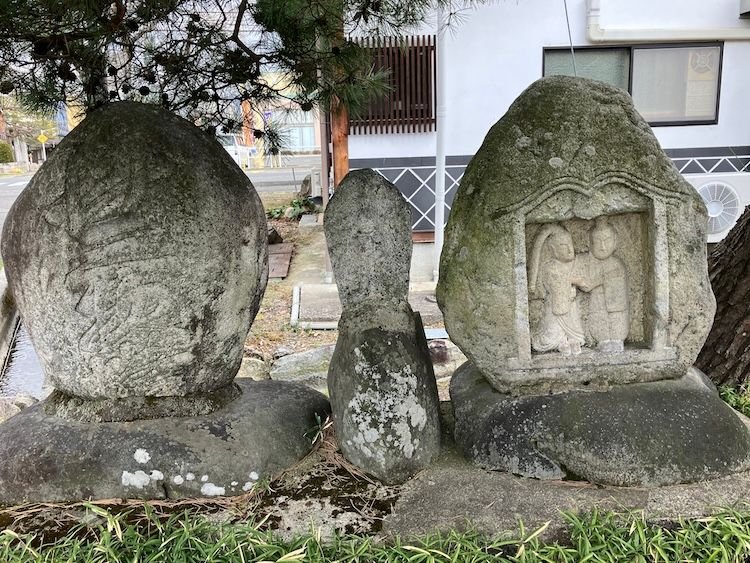
Dosojin
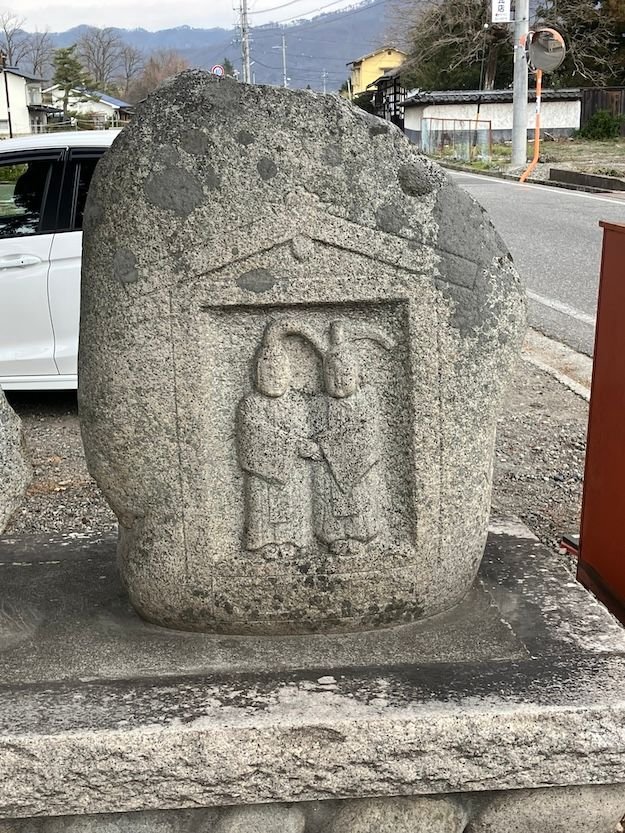
Dosojin
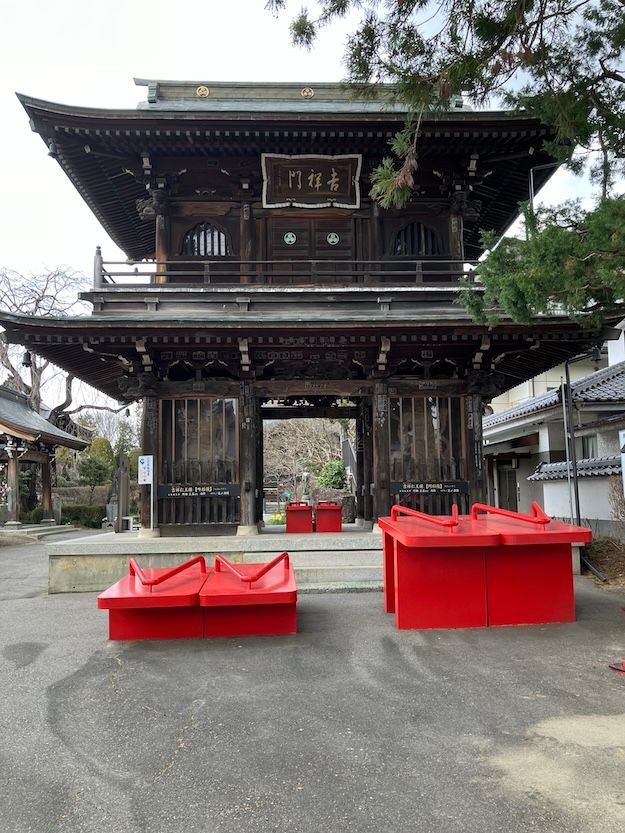
Tokoji temple with sandals

Tokoji temple was near the town center and is often visited for photos since there’s an installation of giant orange geta sandals in front; there are also various life size characters which you can put your face in for photographs. I was the only person here and appreciated the small but well maintained Japanese garden around the courtyard and the adjacent.
Walking to the Dai Wasabi Farm, the entire area is agricultural and I walked past very small wasabi patches, bigger ones and then fields stretching far away. The irrigation ditches were ever present and I studied some with their gates opened or closed. There were tractors in the larger fields and people burning the dead plantings to nutrify the soil. There were various roads through the fields and every now & then a car would pass me, but it was a very peaceful walk. I saw buildings in the distance that I figured was the farm and Google maps said I was heading in the right direction but eventually I realized I’d been been walking for 3 miles and each time I checked Google it said 12 more minutes, 14 more minutes, 19 more minutes. So I clearly missed a turn somewhere! At this point, I was getting tired (and hungry) and happened to be walking past a small commercial intersection with a Lawson’s convenience store on one side and a soba restaurant on the other side, so I decided to give up on the wasabi farm and have lunch instead. This ended up being a great idea and it was a culinary adventure for me!
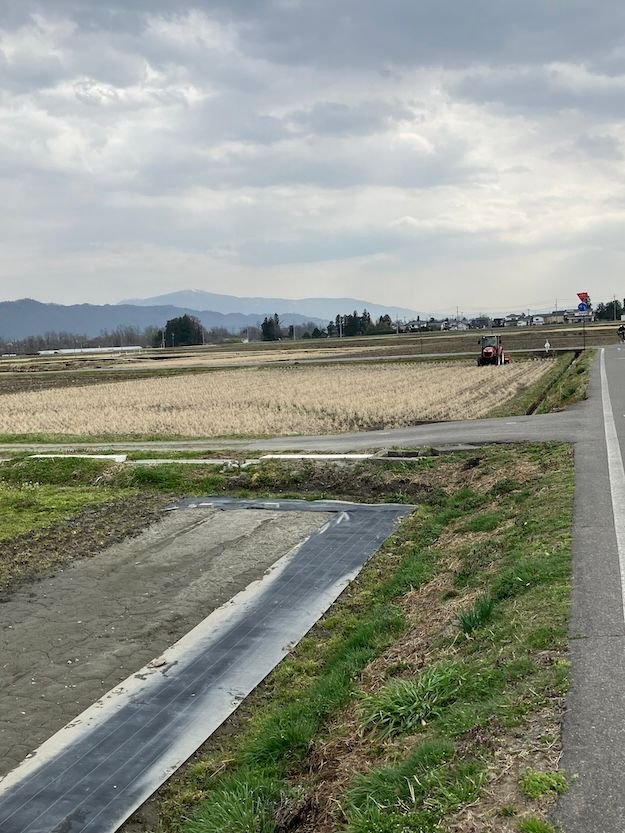
Wasabi fields

Wasabi fields

Wasabi fields
The restaurant is Sekiya Azumino; there’s no English menu so I used Google translate function to try to figure out the menu and a young man who spoke bits of English helped me out too. I ordered a meal of soba noodles and fried chicken which came with pickled radish, soba broth and tea. While waiting, I noticed the food at nearby tables and realized I would be getting a lot of food in a fancy presentation. What fun – I was very glad I gave up on the wasabi farm and was having an unexpected adventure! The soba noodles arrived in a wicker boat (cold and undressed so I could really taste the nutty wheat flavor), the chicken breast was fried but not breaded so it was light, crisp and nice soy/spice flavorings and the pickled radishes were delicious; there were two cups of liquid on the tray, one of which was soba broth (I think) but I couldn’t figure out how I meant to use it; the young man tried to explain and mime, but I didn’t get it…so I dipped the soba noodles into the broth.
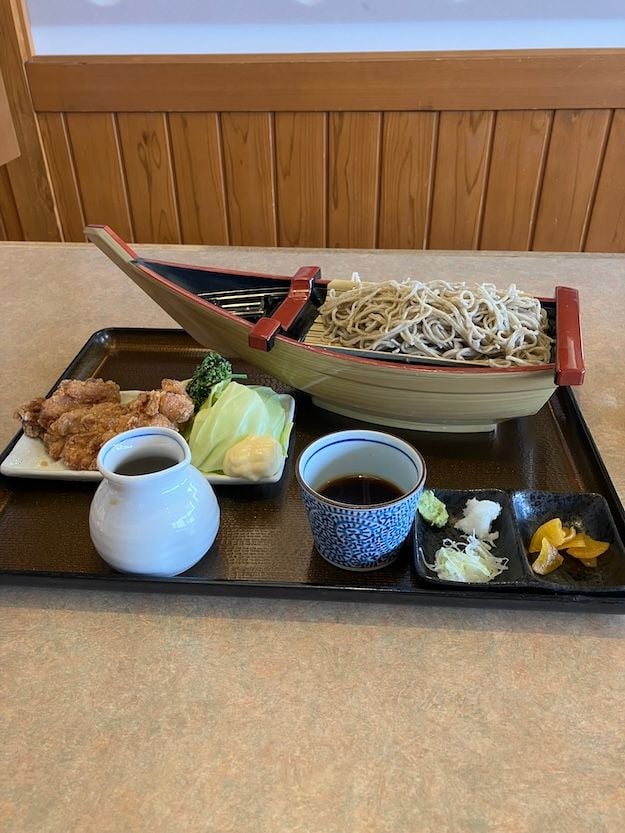
Soba noodles with fried chicken
This was a tasty, filling and inexpensive ($12 USD) meal – so glad I chanced upon this place! Now I won’t bow my head in shame when people ask me what I ate in Japan and I have to say spaghetti or a sandwich. I looked it up and it gets rave reviews and the soba chef has been given the stamp of approval by Joel Robuchon. I used Google Translate to ask them to call me a cab and I made it to the train station with five minutes to spare and went back to Matsumoto.

Azumino manhole cover
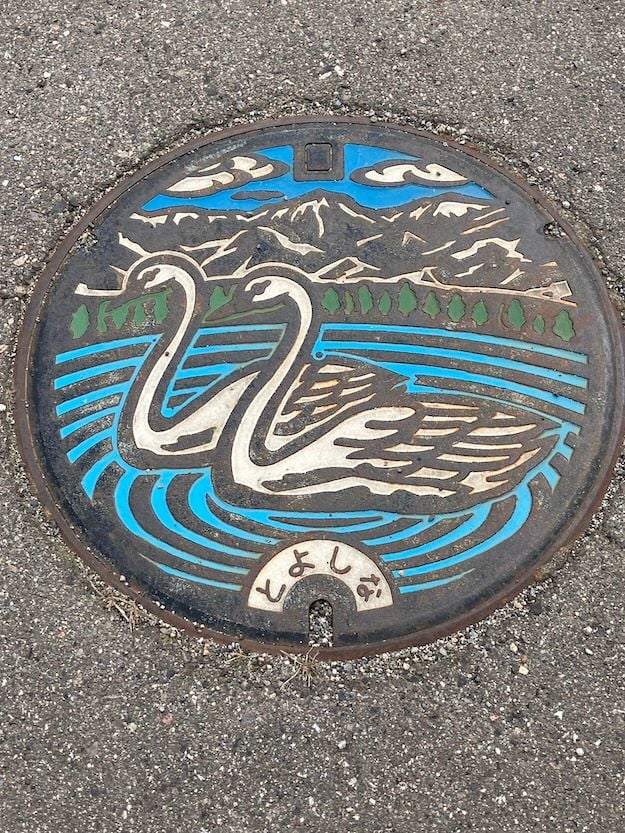
Azumino manhole cover
Back in Matsumoto, I walked around a bit and discovered a temple sort of behind the hotel and enjoyed the grounds which had plenty of mini shrines, prayer areas, inscribed stones, gardens, etc. to see.

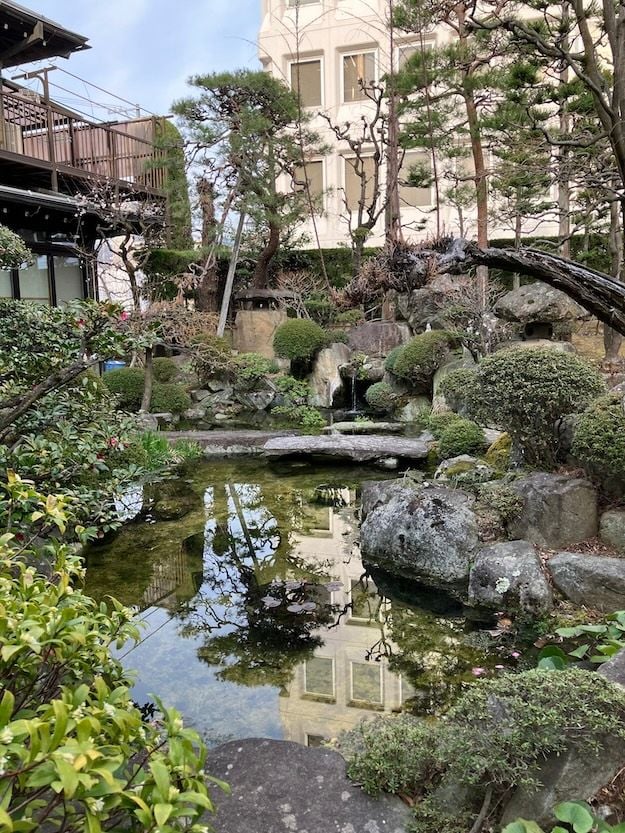
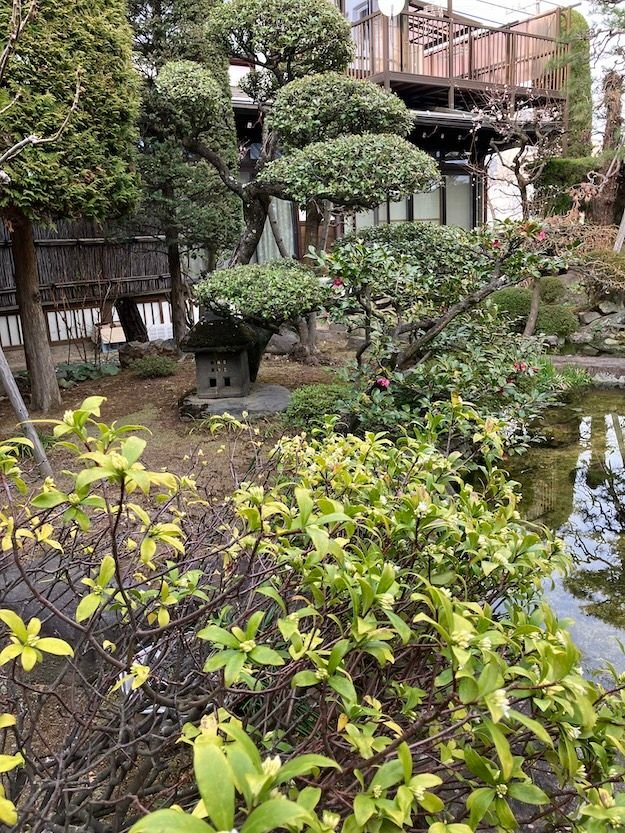
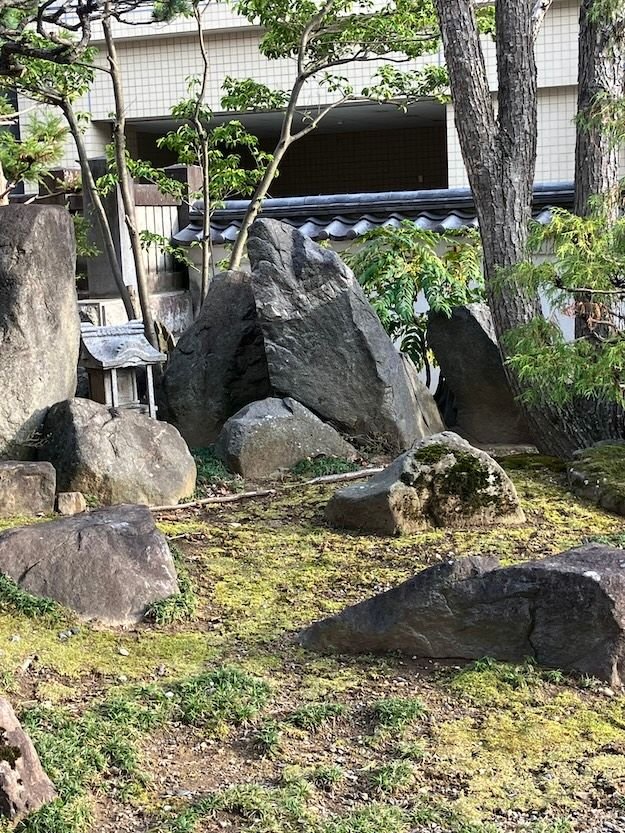
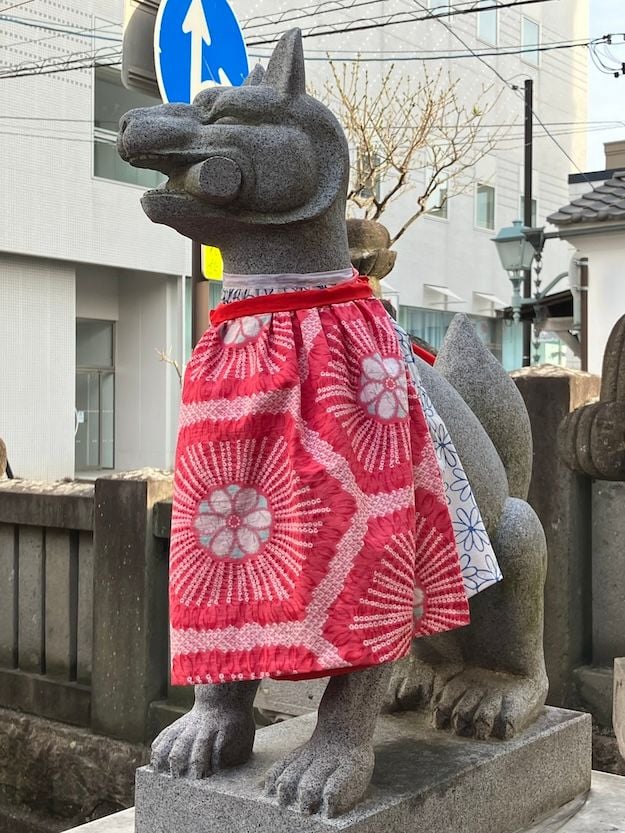

Love this McDonald's delivery car!
I stopped at the bus terminal to buy a ticket for the 2+ hour bus on Thursday morning @ 7:40 to the next town on my travels, Takayama. Interestingly, the bus company’s website states “This is a non-reserved bus; you cannot reserve a seat in advance. Boarding is on a first-come, first-served basis, and purchasing a ticket does not guarantee that you will be able to board your preferred service. Please purchase your ticket on the day of boarding, and then join the boarding queue.” However, when I told my buddies at the Tourist Info office that I would be taking the early morning bus to Takayama, they suggested I buy a ticket in advance. At the bus terminal the man behind a counter used a calendar to confirm which day I wanted to travel and a schedule of times, so I could confirm the time. So, although neither of us spoke each other’s language, we communicated just fine!
Next...Narai and final Matsumoto

Spring in Matsumoto City

Spring in Matsumoto City

Waterway in Matusumoto City

I enjoyed Yohashira Shrine, near the castle, just before Nawate. This is a small but very active shrine used throughout the day by locals. Built during the Meiji period and dedicated to four Shinto deities, it’s thought to have special wish-granting properties and is a very beautiful yet peaceful spot.

Yohashira Shrine

I liked this poster

Yoshinara Temple

Yoshinara Temple

Yoshinara Temple
I had read about a local speciality, sanzoku-yaki which is a special type of fried chicken that’s become known as Matsumoto’s soul food. Made with chicken thighs or breasts, it is unusual since it’s marinated in a garlic and soy sauce mixture before being coated generously in potato starch and then deep fried. There were a couple of restaurants outside the train station that specialize in this dish so I sat at the counter and enjoyed every bit of the chicken.
Day 6 –Matsumoto (April 2)
It’s sunny and low 50s. I had a walking and culinary adventure today when I took a train to a nearby town, Azumino! My primary reason was to visit a wasabi farm and see more of the countryside along with several temples and shrines. Once again, the staff at the Masumoto Tourist Info center in the train station were super – they gave me the train schedule (one per hour, each way) and suggestions. It was a 30 minute train ride, and as soon as we were outside of Matsumoto, it started getting more agricultural and the mountains were closer. We passed through a number of small towns but I was entranced by those snowcapped mountains.

Azumino - mountain view from the Hokata train station
Once I arrived, I went to the local tourist info office (across the street from the train station) and got a map. They suggested I take a cab to the wasabi farm, but I wanted to visit a shrine and the temple that were on the way to the farm so I decided to walk since it was only a mile or so (bad idea!). This is a very small town so I enjoyed walking through the center since it was so different than Matsumoto. Very quickly I came to the Hataka Shinto shrine, set in a grove of very tall cedar trees. The grounds include a welcome center, a pavilion used for special ceremonies, the hall of worship where people make their offerings and follow prayer rituals outside and can go inside for special rituals or meetings with the monks and 3 small buildings which are where the deities are enshrined. All the buildings are made from cedar. The three small buildings are rebuilt every 20 years to the exact same specifications and since the reconstruction times are staggered, you can tell which of the three is the newest by the degree of weathering. The reason they do this is to ensure the ancient rituals and traditional shrine related architecture and techniques are passed down to each new generation.

Hataka Shrine, Azumino

Sake barrels
This is a very active shrine but because the grounds are large, it felt very private (there were maybe 15 people there) and while I was there I stood outside, off to the side and peeked into the worship hall where I saw bits of a ceremony: a robed monk chanting on a raised platform and two sub monks (girls) assisting, and another monk using a big drum. Within the compound grounds, there were lots of carved stones, mini shrines, statuary, and a big wall of what I thought were lanterns, but then found out were sake barrels which aren’t wooden barrels like we envision, they are short and squat with a cloth covering. They were very decorative with mountain scenes on the fronts.

Sake barrels
The welcome center contained two large exhibit rooms, which initially perplexed me because they looked like large scale, crude dioramas of scenes from the past. Then I realized that these are floats used in annual processions to celebrate the deities. Each float was gigantic and told a different part of the story. Part of the display showed how the figures in the floats are carved from cedar trees and decorated. No information in English so I used Google translate which provides the basic gist.

Float in shrine welcome center

Exhibit of how float figures are carve
Throughout the village were irrigation channels, complete with gates/locks so that the water can be diverted as needed. So there’s a sound constant of rushing water as you walk along. I also saw a lot of dosojin which are Shinto deities who live in stone carvings placed at village boundaries, forks in the road and other key points. They’re about 4 ft tall, either a simple inscription, or a carving of human figures, usually a man and a woman. The dosojin are cared for by locals and each is unique, so an interesting quest to spot them.

Mini shrine along the street

Dosijin

Dosojin

Dosojin

Tokoji temple with sandals

Tokoji temple was near the town center and is often visited for photos since there’s an installation of giant orange geta sandals in front; there are also various life size characters which you can put your face in for photographs. I was the only person here and appreciated the small but well maintained Japanese garden around the courtyard and the adjacent.
Walking to the Dai Wasabi Farm, the entire area is agricultural and I walked past very small wasabi patches, bigger ones and then fields stretching far away. The irrigation ditches were ever present and I studied some with their gates opened or closed. There were tractors in the larger fields and people burning the dead plantings to nutrify the soil. There were various roads through the fields and every now & then a car would pass me, but it was a very peaceful walk. I saw buildings in the distance that I figured was the farm and Google maps said I was heading in the right direction but eventually I realized I’d been been walking for 3 miles and each time I checked Google it said 12 more minutes, 14 more minutes, 19 more minutes. So I clearly missed a turn somewhere! At this point, I was getting tired (and hungry) and happened to be walking past a small commercial intersection with a Lawson’s convenience store on one side and a soba restaurant on the other side, so I decided to give up on the wasabi farm and have lunch instead. This ended up being a great idea and it was a culinary adventure for me!

Wasabi fields

Wasabi fields

Wasabi fields
The restaurant is Sekiya Azumino; there’s no English menu so I used Google translate function to try to figure out the menu and a young man who spoke bits of English helped me out too. I ordered a meal of soba noodles and fried chicken which came with pickled radish, soba broth and tea. While waiting, I noticed the food at nearby tables and realized I would be getting a lot of food in a fancy presentation. What fun – I was very glad I gave up on the wasabi farm and was having an unexpected adventure! The soba noodles arrived in a wicker boat (cold and undressed so I could really taste the nutty wheat flavor), the chicken breast was fried but not breaded so it was light, crisp and nice soy/spice flavorings and the pickled radishes were delicious; there were two cups of liquid on the tray, one of which was soba broth (I think) but I couldn’t figure out how I meant to use it; the young man tried to explain and mime, but I didn’t get it…so I dipped the soba noodles into the broth.

Soba noodles with fried chicken
This was a tasty, filling and inexpensive ($12 USD) meal – so glad I chanced upon this place! Now I won’t bow my head in shame when people ask me what I ate in Japan and I have to say spaghetti or a sandwich. I looked it up and it gets rave reviews and the soba chef has been given the stamp of approval by Joel Robuchon. I used Google Translate to ask them to call me a cab and I made it to the train station with five minutes to spare and went back to Matsumoto.

Azumino manhole cover

Azumino manhole cover
Back in Matsumoto, I walked around a bit and discovered a temple sort of behind the hotel and enjoyed the grounds which had plenty of mini shrines, prayer areas, inscribed stones, gardens, etc. to see.






Love this McDonald's delivery car!
I stopped at the bus terminal to buy a ticket for the 2+ hour bus on Thursday morning @ 7:40 to the next town on my travels, Takayama. Interestingly, the bus company’s website states “This is a non-reserved bus; you cannot reserve a seat in advance. Boarding is on a first-come, first-served basis, and purchasing a ticket does not guarantee that you will be able to board your preferred service. Please purchase your ticket on the day of boarding, and then join the boarding queue.” However, when I told my buddies at the Tourist Info office that I would be taking the early morning bus to Takayama, they suggested I buy a ticket in advance. At the bus terminal the man behind a counter used a calendar to confirm which day I wanted to travel and a schedule of times, so I could confirm the time. So, although neither of us spoke each other’s language, we communicated just fine!
Next...Narai and final Matsumoto
#11
Original Poster
Join Date: Sep 2005
Posts: 499
Likes: 0
Received 0 Likes
on
0 Posts
Day 7 –Matsumoto (April 3)
Today was rainy…. Today’s mission was a train ride to Narai (1 hr south of Matsumoto). Narai is one of the 11 villages on the Nakasendo Road, one of the main routes between Tokyo and Kyoto in the 17-19 centuries. This particular town made a concentrated effort in the 1970’s to preserve the old streetscape and have won various national awards. People still live in this village and they have to get approval to change any exterior elements. So it sounded interesting which it was - I think the rain was a benefit since it probably reduced the number of visitors and added to the atmosphere.

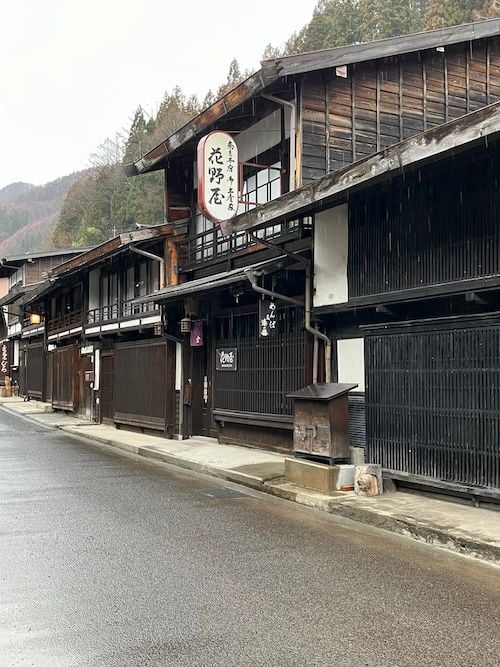
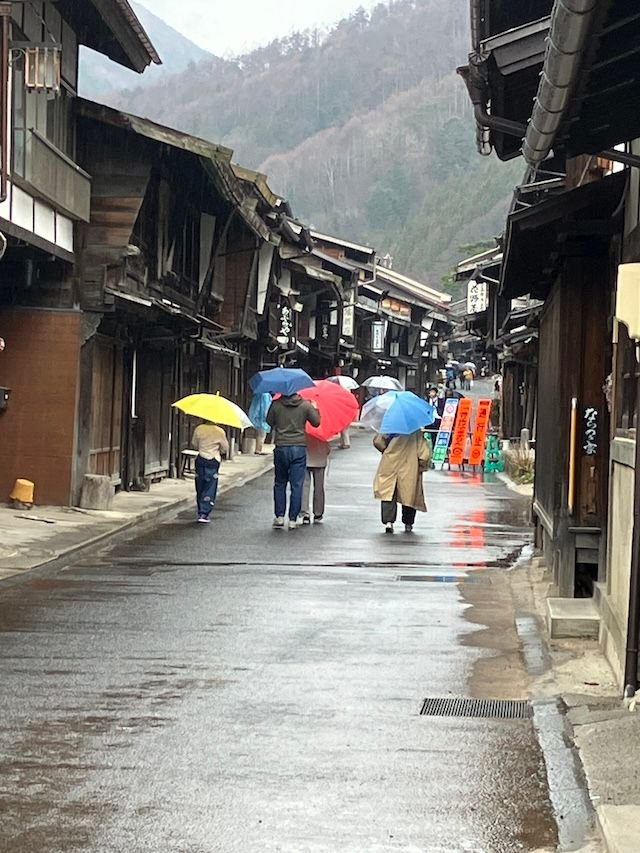
Just beyond the train station, the wooden buildings line the Nakasendo Way for about a kilometer. The buildings are all black wood and lattice work with white elements from rice paper and some paint. It’s basically one street that’s fairly narrow and the buildings range in height, depending on the era they were built. There were some modern homes behind the street and up the hill but they are required to stick with the color scheme.
I gather that normally this street is a mob of people and there are number of shops for tourists and restaurants but today very few were open. There are two craft claims to fame here – wooden combs and lacquerware items. I don’t need anything but enjoyed looking. One tiny shop sold only wood block prints that the shopkeeper’s husband designed and created. She was very proud of him, and had several photos of him displayed in the shop; some of his designs were used on Japanese stamps and currency notes. I bought a small wood block print of the mountains. She was friendly and we talked with smiles, gestures and a few words like “husband”.
Although most of the buildings on the street are either private residences or shops/restaurants, there are a few old residences you can visit. I particularly enjoyed the Nakamura residence: quite large because it combined offices for their lacquerware business and family residence; it extended very far back from the because taxes were assessed based on the width of the house, not the depth; and had a garden courtyard in the back. As a more recent building, it had a very narrow 2nd floor veranda.
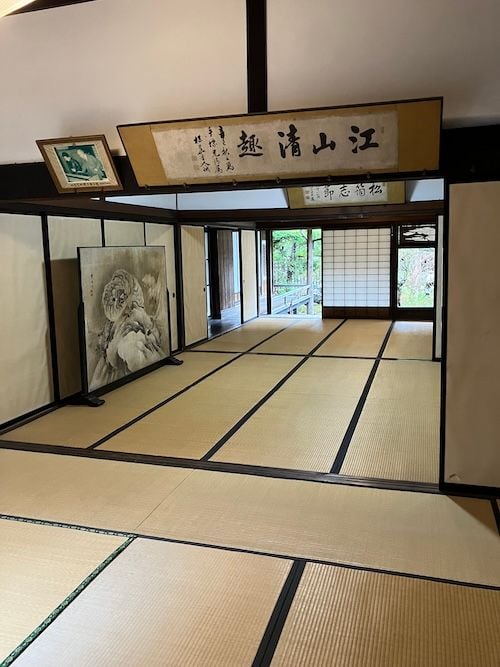

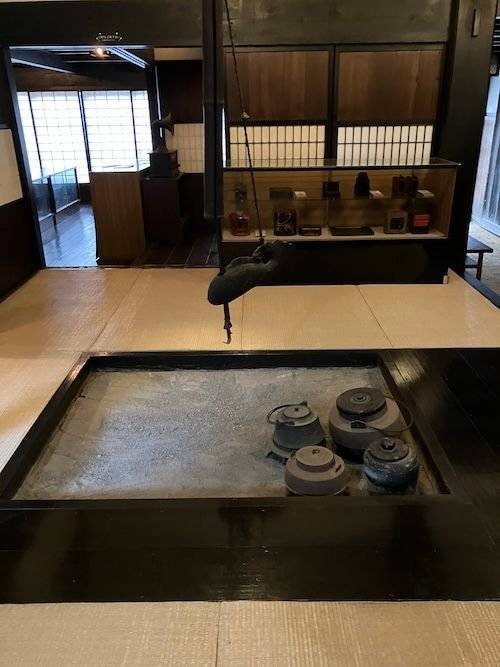
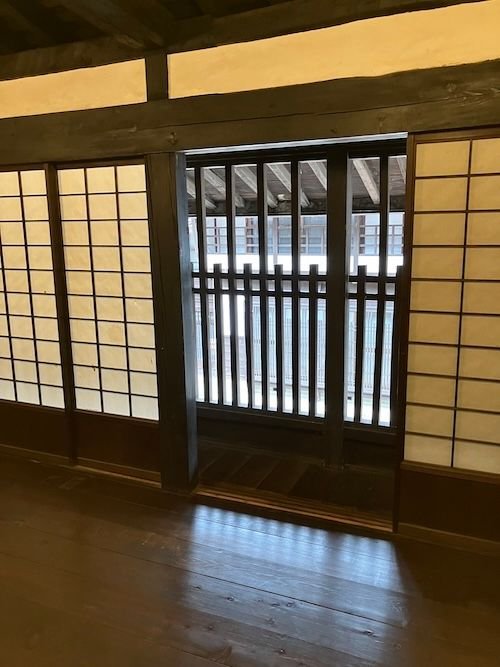
2nd floor veranda - only in newer buildings
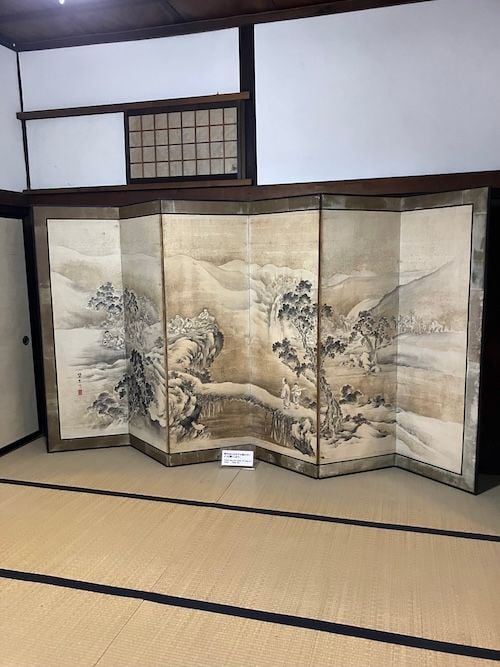

Love the graceful frond design in the rice paper door
Narai was very atmospheric in the rain, with mist swirling around the hilltop and I felt like a character in Shogun. But after two hours I felt like I had absorbed all I was going to and my feet were soggy; due to the train schedule it was either leave now or wait 2 1/2 hours… So I left now. I very much enjoyed Narai; I liked the train ride into the country, the mountains, the history that was so evident and the empty town in the grey drizzle. And the buildings architecture was so varied. I was captivated.
Once back in Matsumoto, I decided to do more sightseeing even though it was still raining. They have a Town Sneaker bus that does three different routes to popular spots so I rode that just to see what was out there. I explored the two well-known streets that are on all of the tourist lists, Nakamachi and Frog Streets. There were shops, cafťs, and restaurants, but neither seemed particularly attractive or historic. Frog Street had some shops that sold good which weren’t quite antiques, but weren’t shiny and glitzy and I had fun poking around them.
I stumbled across an interesting building, which was an old sake brewery, Nakamachi Kurassic-Kan. The town of Matsumoto prospered as the backbone support for the castle throughout the ages and of course sake was big business due to all the residents, lords, merchants, and the spring water. The building has been refurbished in the old style and the beams in the double height ceiling are pretty amazing. I was the only person there so absorbed the history in silence.

Former sake brewery, Matsumoto
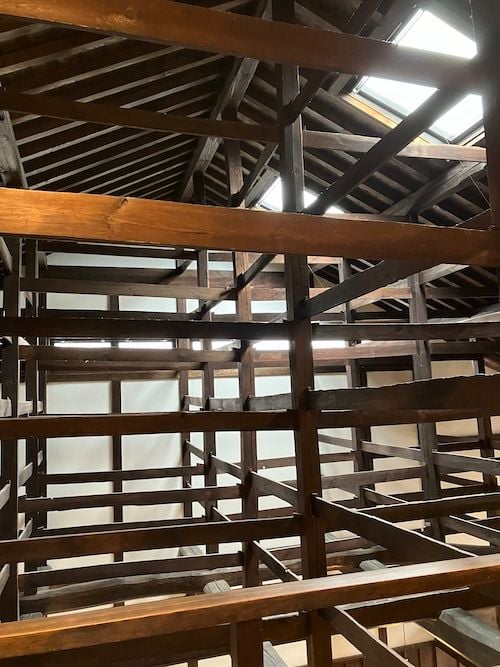
Beam structure in Former sake brewery, Matsumoto
I stopped in one of the Parco malls and bought yakitori and dumplings from the supermarket for dinner in my room.
Next...Takayama!
Today was rainy…. Today’s mission was a train ride to Narai (1 hr south of Matsumoto). Narai is one of the 11 villages on the Nakasendo Road, one of the main routes between Tokyo and Kyoto in the 17-19 centuries. This particular town made a concentrated effort in the 1970’s to preserve the old streetscape and have won various national awards. People still live in this village and they have to get approval to change any exterior elements. So it sounded interesting which it was - I think the rain was a benefit since it probably reduced the number of visitors and added to the atmosphere.



Just beyond the train station, the wooden buildings line the Nakasendo Way for about a kilometer. The buildings are all black wood and lattice work with white elements from rice paper and some paint. It’s basically one street that’s fairly narrow and the buildings range in height, depending on the era they were built. There were some modern homes behind the street and up the hill but they are required to stick with the color scheme.
I gather that normally this street is a mob of people and there are number of shops for tourists and restaurants but today very few were open. There are two craft claims to fame here – wooden combs and lacquerware items. I don’t need anything but enjoyed looking. One tiny shop sold only wood block prints that the shopkeeper’s husband designed and created. She was very proud of him, and had several photos of him displayed in the shop; some of his designs were used on Japanese stamps and currency notes. I bought a small wood block print of the mountains. She was friendly and we talked with smiles, gestures and a few words like “husband”.
Although most of the buildings on the street are either private residences or shops/restaurants, there are a few old residences you can visit. I particularly enjoyed the Nakamura residence: quite large because it combined offices for their lacquerware business and family residence; it extended very far back from the because taxes were assessed based on the width of the house, not the depth; and had a garden courtyard in the back. As a more recent building, it had a very narrow 2nd floor veranda.




2nd floor veranda - only in newer buildings


Love the graceful frond design in the rice paper door
Narai was very atmospheric in the rain, with mist swirling around the hilltop and I felt like a character in Shogun. But after two hours I felt like I had absorbed all I was going to and my feet were soggy; due to the train schedule it was either leave now or wait 2 1/2 hours… So I left now. I very much enjoyed Narai; I liked the train ride into the country, the mountains, the history that was so evident and the empty town in the grey drizzle. And the buildings architecture was so varied. I was captivated.
Once back in Matsumoto, I decided to do more sightseeing even though it was still raining. They have a Town Sneaker bus that does three different routes to popular spots so I rode that just to see what was out there. I explored the two well-known streets that are on all of the tourist lists, Nakamachi and Frog Streets. There were shops, cafťs, and restaurants, but neither seemed particularly attractive or historic. Frog Street had some shops that sold good which weren’t quite antiques, but weren’t shiny and glitzy and I had fun poking around them.
I stumbled across an interesting building, which was an old sake brewery, Nakamachi Kurassic-Kan. The town of Matsumoto prospered as the backbone support for the castle throughout the ages and of course sake was big business due to all the residents, lords, merchants, and the spring water. The building has been refurbished in the old style and the beams in the double height ceiling are pretty amazing. I was the only person there so absorbed the history in silence.

Former sake brewery, Matsumoto

Beam structure in Former sake brewery, Matsumoto
I stopped in one of the Parco malls and bought yakitori and dumplings from the supermarket for dinner in my room.
Next...Takayama!
#13
Original Poster
Join Date: Sep 2005
Posts: 499
Likes: 0
Received 0 Likes
on
0 Posts
Plambers - here you go! I did so much in Takayama that I have to break this into pieces!  Day 8 –Takayama (April 4)
Day 8 –Takayama (April 4)
Got up early to catch the 7:40 AM bus to Takayama. It was a full-sized bus (not a mini-van); there were only six of us on the bus; it was a 2.5 hr ride and wow, was it fascinating! (And contrary to their website, the bus did make one 10 minute stop at a convenience store/restroom area; maybe because no-one was getting on/off at intermediate stops, so perhaps they had time to spare.) As we rode through the outskirts of Matsumoto City, it was interesting to see the residential areas. Mostly all single family homes (versus condos) and the majority of them are in an architectural style that we would call Japanese; the most obvious feature is the roof, which is rounded shiny tiles, with a big curve at either end of the roof beam and the eaves. There are also some decorative tiles along the edge of the eaves.
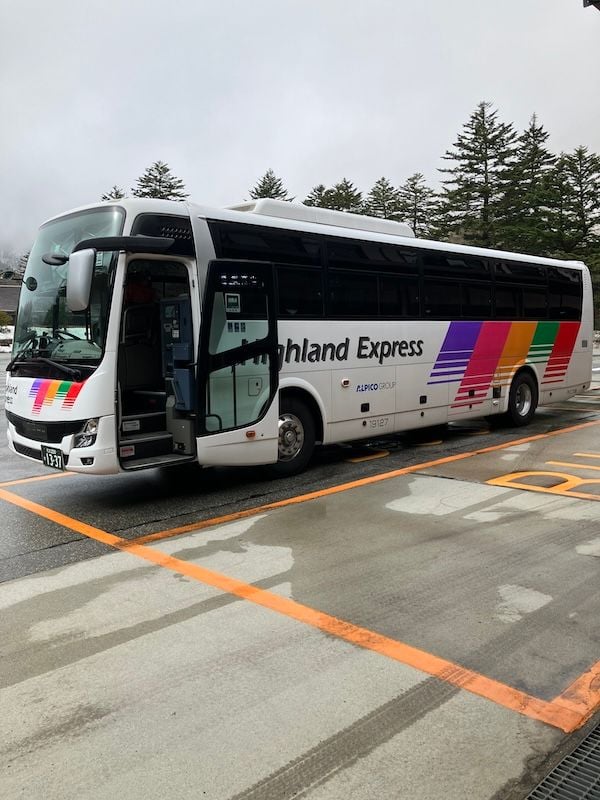
Every house has some kind of garden/landscaping in the front or the side; although landscaping makes it sound too manicured. Some of the areas look messy to a Western eye because there are gardening supplies lined up against the wall. Maybe some bricks in a pile etc. But most of them feature a kind of pine tree that I call a Dr. Seuss tree because it’s bare trunk, then a round ball of green needles, then trunk, then more green needles, etc. I don’t know if it’s pruned that way or grows that way. Then there are also some pine trees of a different variety that look stunted, they actually look like bonsai firs, but six or 8 feet high. Most yards have both types of pines and maybe a stone lantern or a big stone.
Then we started climbing into the mountains, which were mostly pines, but also deciduous trees. It turns out this is Japan’s largest timber producing area, which makes sense because I saw a lot of timber mills and also gravel pits. As we climbed, we followed a raging, rushing torrent of a river. It was wide and fast and foaming. For the entire mountain part, which was almost 2 hours, I saw multiple hydro projects: dams, reservoirs, huge pipes coming down the mountain side that I assume are gathering water from the mountains or snow runoff and all kinds of waterworks. It makes sense given the elevation of these mountains and the gorges which funnel the power of the water. Spectacular to see. The mountains were wreathed in mist for the first hour or so until the sun came out.
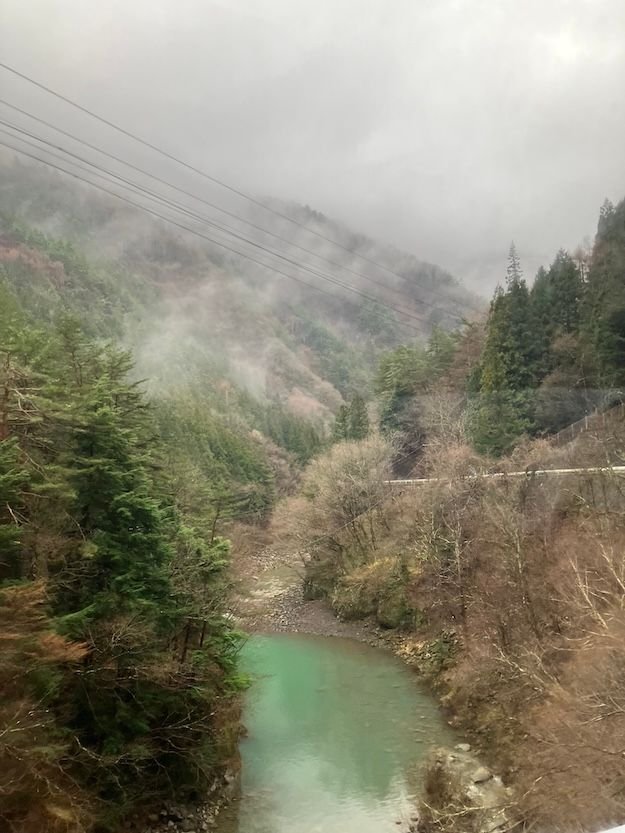

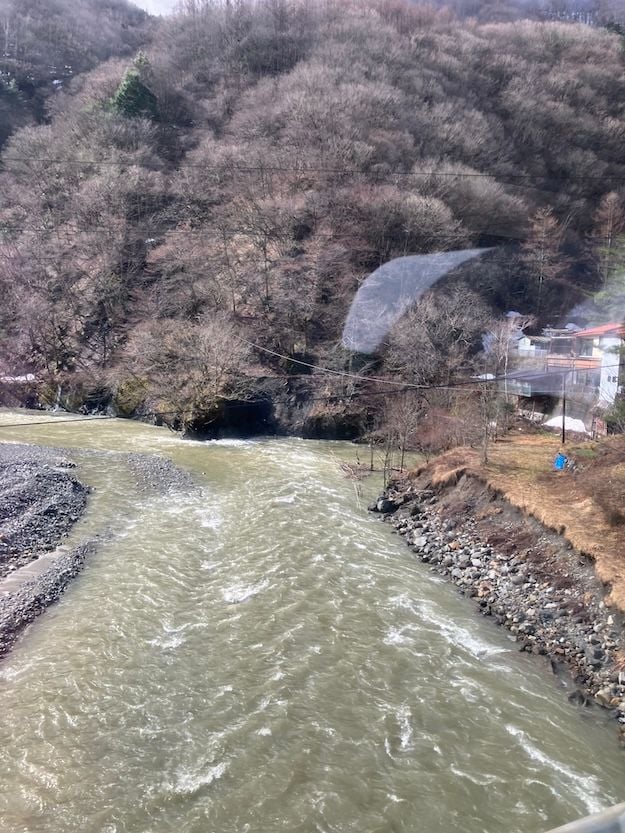

And the road was a series of S-turns and tunnels carved or blasted through the mountains. The first few tunnels were “OK, a tunnel” but then I realized they were getting longer and longer and you couldn’t see light at the end; then I used my phone to time it and we were in one of these tunnels for over three minutes – I have no idea how many miles that is, but it was a lot! Just think about the manpower and tools and cost needed to blast through these mountains to make the tunnels without having the mountains crash down. Then I started seeing snow – first little piles on the roadside, then full coverage everywhere except the road, then the depth of the snow on the ground increased from 6 inches to over a foot. My head is swivelling trying to look out both sides of the bus! There are stretches that have metal netting in case of rock slides; lots of waterfalls; and trees galore.


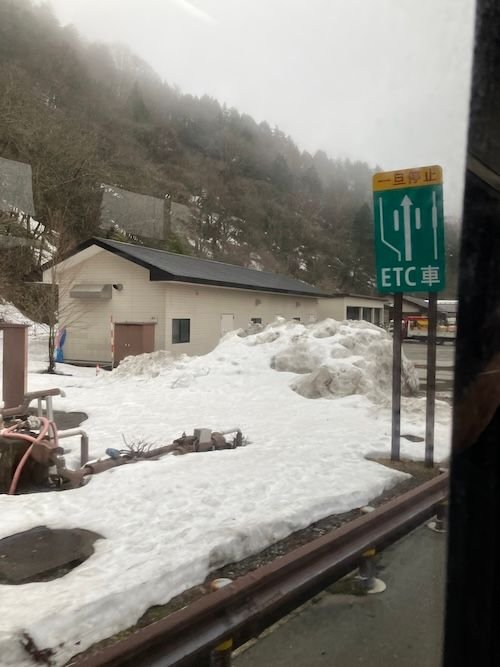
We stopped at a rest stop, primarily for a bathroom break, but got out for 10 minutes and the temp was in the 30s. While in the mountains, there were some hotels, but I didn’t see any sign of skiing, so maybe it’s for mountain climbing folks? Then we started coming down out of the mountains; first the snow disappeared, then the ground got flatter, and then I started seeing little villages with small rice fields or other agricultural areas. With the river right there, I can see how useful that would be for flooding the rice fields and general irrigation. These single-family agricultural holdings went on for a fair while.


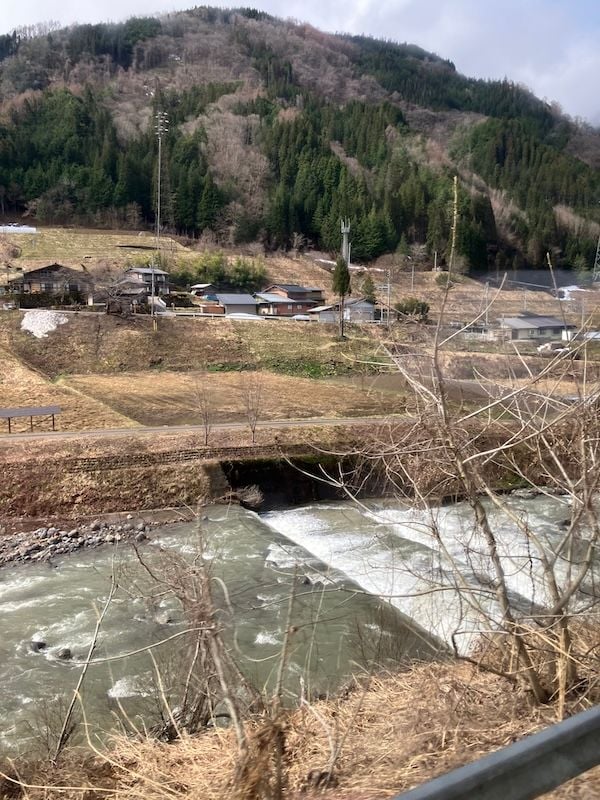
Then we arrived in Takayama which looked like any other regional industrial town in the US or anywhere. Bus and train stations are never built in the best part of town! The tourist info office is just outside the train & bus station (in the same plaza, on ground level) and picked up maps and brochures. My hotel, Spa Hotel Alpina Hida Takayama, was only about an 8 minute walk from the station, so I left my bag and went sightseeing. Note: The room was fine; bed was comfortable, lighting was good and the window opened; that was important since the AC wasn’t available yet (turned off for the entire hotel seasonally) but the evenings were cool, so by opening the window, the room was a perfect temp for sleeping.
Map in hand off I went (I know I can use Google maps, but first of all, if you’re staring at the phone, you’re missing all the sights of wherever you are; plus it’s not the easiest thing to follow directions that Google gives; and I hate looking like that much of a tourist (not that carrying a paper map around is any less touristy😁 . This town features two pretty substantial preservation districts where Edo houses still line multiple streets (Sannomachi Street and adjacent). Throughout history, Takayama was a busy trading center so there were many merchants here (and money lenders) whose offices and homes have been preserved. This place gets a lot of tour buses and they tend to go to the same areas so you can avoid them by going one or two streets off. And to be honest, even where there were tour groups, it wasn’t that crazy – not nearly as bad as Tokyo. Lots and lots of little shops selling the local crafts, wood carvings, some needlework, and pottery. Call me a skeptic, but I wondered is some of those are made in China and imported for the tourist market. The degree of finesse in the carvings was very easy to differentiate; there were some very nice birds or squirrels about the size of an egg and they were $70-90. In another shop, birds & squirrels of a similar size were much rougher and half the price.
. This town features two pretty substantial preservation districts where Edo houses still line multiple streets (Sannomachi Street and adjacent). Throughout history, Takayama was a busy trading center so there were many merchants here (and money lenders) whose offices and homes have been preserved. This place gets a lot of tour buses and they tend to go to the same areas so you can avoid them by going one or two streets off. And to be honest, even where there were tour groups, it wasn’t that crazy – not nearly as bad as Tokyo. Lots and lots of little shops selling the local crafts, wood carvings, some needlework, and pottery. Call me a skeptic, but I wondered is some of those are made in China and imported for the tourist market. The degree of finesse in the carvings was very easy to differentiate; there were some very nice birds or squirrels about the size of an egg and they were $70-90. In another shop, birds & squirrels of a similar size were much rougher and half the price.
Here’s one of those travel stories that make my day: I stopped by a knife store (Konoha) since Japanese knives are a big deal in the chef world and in addition to knives they also make good nail clippers. It was a small store and the owner actually made some of the knives himself. I was puttering around and there was another customer in there having a very intense conversation with the owner about the best knife to buy to slice sashimi. They were going back-and-forth about different knife lengths, shapes, handles and the guy was demonstrating to the owner how he holds a knife when he slices it. I was eavesdropping, because…. why not? It was interesting. He was French and his wife was there with his two kids but he was taking a while so they went outside. Finally he ended up buying two knives and they have a lengthy discussion about a whetstone to sharpen the knives which he’s never used but the owner says definitely if you’re buying a Japanese knives you shouldn’t use one of those sharpening steels that comes with a carving set-you should use a whetstone. So he showed the guy how to use a whetstone correctly and the guy bought that also. As part of their conversation, the guy says “this is where I live - have you heard of French Polynesia?” so of course, my ears perked up even more; it turns out the guy and his wife own a hotel in Rangiroa which I have heard of and want to go to. It’s not nearly as touristy as Tahiti, Bora Bora, or Moorea. What are the chances? So I tapped him on the shoulder and asked if he had a business card and explained that I knew exactly where Rangiroa was and was interested in snorkeling in the area. He gave me his card and the name of their pension is Le Coconut Lodge - how perfect is that? We chuckled a bit and I said I’ll email you if I’m coming and I’ll remind you that we met in Takayama when you bought sashimi knives. And he said I’ll make the best sashimi you have ever had. Who knows - I have been thinking about another tropical vacation and snorkeling also interests me so perhaps Le Coconut Lodge is in my future…
I went inside two heritage houses which were preserved as they were in 2nd half of 19th c. (located next to each other.). The Yoshijima House belonged to a sake brewer who was also a money lender so the building included offices plus living areas. Apparently it’s very well-known in the design and architectural world and is featured in global magazines since the design and architectural details are so prominent; no furniture or doo dads to clutter up the scene! To be honest, the interior looked almost the same as the other buildings I’ve been in EXCEPT the ceilings in each room were paneled with different woods and the grains were lined up to create an aesthetically appealing design.
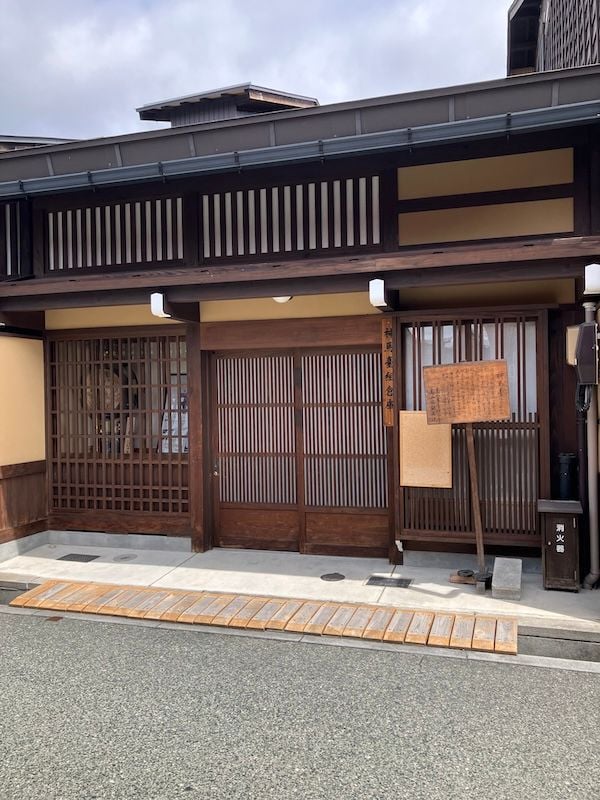

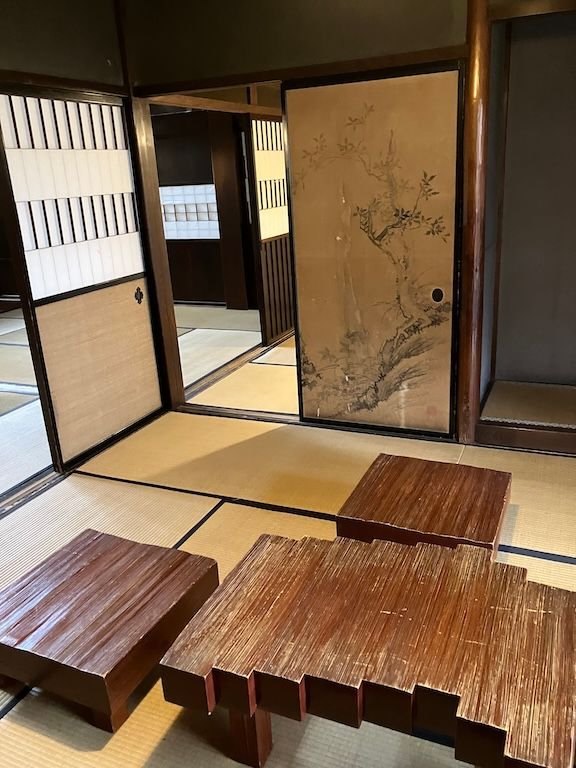

The Kusakabe Heritage House belonged to merchant who was also a money lender, so his building was similar in that it had offices and living space. But he had some decorations. One of the rooms had a display of half a dozen hibachis with a note that these were necessary in each room to warm the house during cold snowy winters. Good grief – they must’ve been freezing🥶 These are wooden houses that are not exactly airtight, a good portion of the exterior walls are sliding panels that rattle in the slightest breeze, the house has a very high ceiling, and rice paper sliding walls between the rooms probably don’t keep much heat in. And those hibachis aren’t any bigger than the one we used to have on the back porch so you would have to huddle over it.
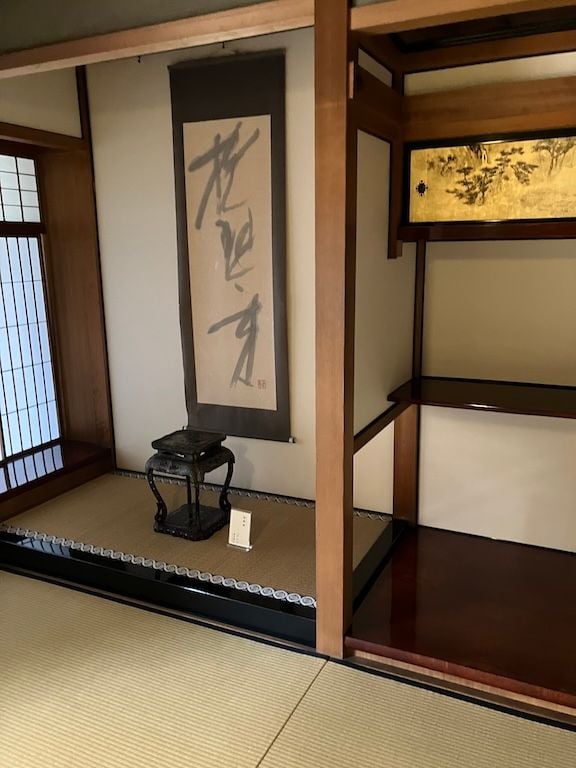
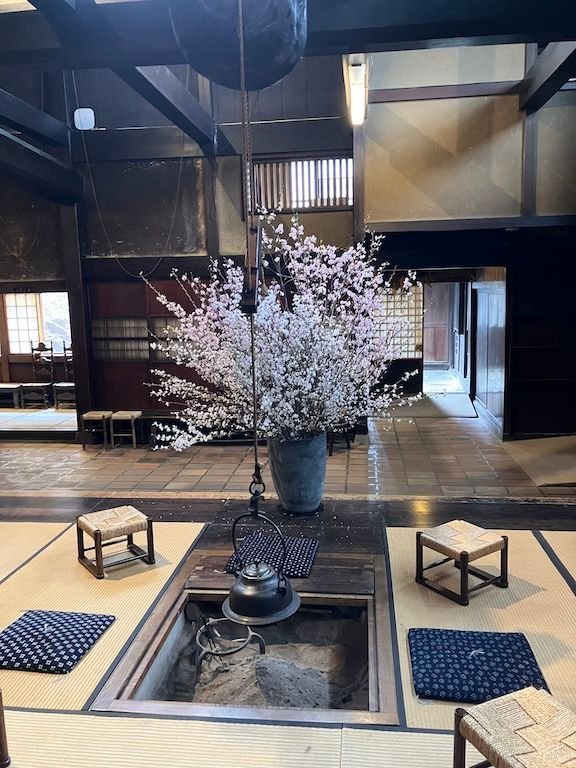
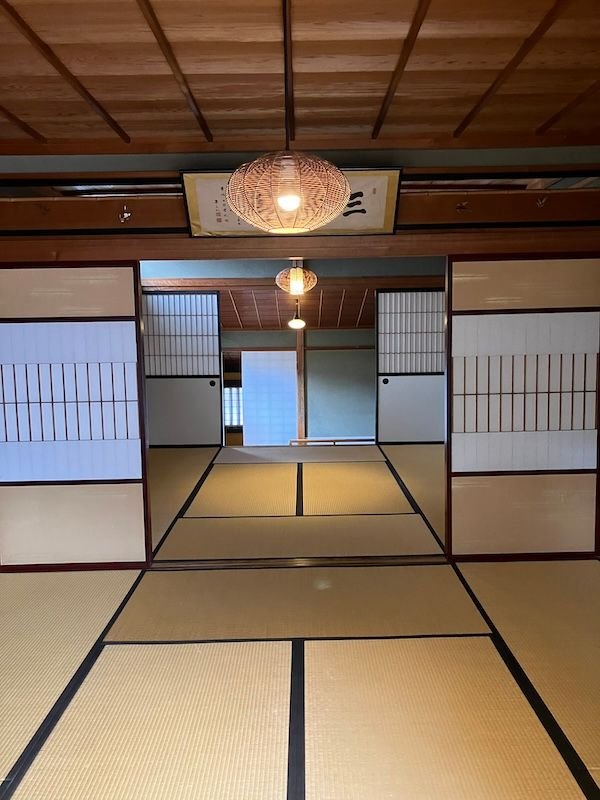
Both of the heritage houses were fascinating to me. Tour groups don’t come inside, so they weren’t crowded or noisy (maybe 6 other people in the entire house at the same time). They both had the characteristics of Edo homes: two stories, made from Japanese Cypress, strong beams and pillars, vaulted center ceiling, various latticework transoms, doors and windows and finished with a dark brown paint (made from soot). The Kusakabe house had displays and exhibits which were interesting, in addition to the building itself.
 Day 8 –Takayama (April 4)
Day 8 –Takayama (April 4)Got up early to catch the 7:40 AM bus to Takayama. It was a full-sized bus (not a mini-van); there were only six of us on the bus; it was a 2.5 hr ride and wow, was it fascinating! (And contrary to their website, the bus did make one 10 minute stop at a convenience store/restroom area; maybe because no-one was getting on/off at intermediate stops, so perhaps they had time to spare.) As we rode through the outskirts of Matsumoto City, it was interesting to see the residential areas. Mostly all single family homes (versus condos) and the majority of them are in an architectural style that we would call Japanese; the most obvious feature is the roof, which is rounded shiny tiles, with a big curve at either end of the roof beam and the eaves. There are also some decorative tiles along the edge of the eaves.

Every house has some kind of garden/landscaping in the front or the side; although landscaping makes it sound too manicured. Some of the areas look messy to a Western eye because there are gardening supplies lined up against the wall. Maybe some bricks in a pile etc. But most of them feature a kind of pine tree that I call a Dr. Seuss tree because it’s bare trunk, then a round ball of green needles, then trunk, then more green needles, etc. I don’t know if it’s pruned that way or grows that way. Then there are also some pine trees of a different variety that look stunted, they actually look like bonsai firs, but six or 8 feet high. Most yards have both types of pines and maybe a stone lantern or a big stone.
Then we started climbing into the mountains, which were mostly pines, but also deciduous trees. It turns out this is Japan’s largest timber producing area, which makes sense because I saw a lot of timber mills and also gravel pits. As we climbed, we followed a raging, rushing torrent of a river. It was wide and fast and foaming. For the entire mountain part, which was almost 2 hours, I saw multiple hydro projects: dams, reservoirs, huge pipes coming down the mountain side that I assume are gathering water from the mountains or snow runoff and all kinds of waterworks. It makes sense given the elevation of these mountains and the gorges which funnel the power of the water. Spectacular to see. The mountains were wreathed in mist for the first hour or so until the sun came out.




And the road was a series of S-turns and tunnels carved or blasted through the mountains. The first few tunnels were “OK, a tunnel” but then I realized they were getting longer and longer and you couldn’t see light at the end; then I used my phone to time it and we were in one of these tunnels for over three minutes – I have no idea how many miles that is, but it was a lot! Just think about the manpower and tools and cost needed to blast through these mountains to make the tunnels without having the mountains crash down. Then I started seeing snow – first little piles on the roadside, then full coverage everywhere except the road, then the depth of the snow on the ground increased from 6 inches to over a foot. My head is swivelling trying to look out both sides of the bus! There are stretches that have metal netting in case of rock slides; lots of waterfalls; and trees galore.



We stopped at a rest stop, primarily for a bathroom break, but got out for 10 minutes and the temp was in the 30s. While in the mountains, there were some hotels, but I didn’t see any sign of skiing, so maybe it’s for mountain climbing folks? Then we started coming down out of the mountains; first the snow disappeared, then the ground got flatter, and then I started seeing little villages with small rice fields or other agricultural areas. With the river right there, I can see how useful that would be for flooding the rice fields and general irrigation. These single-family agricultural holdings went on for a fair while.



Then we arrived in Takayama which looked like any other regional industrial town in the US or anywhere. Bus and train stations are never built in the best part of town! The tourist info office is just outside the train & bus station (in the same plaza, on ground level) and picked up maps and brochures. My hotel, Spa Hotel Alpina Hida Takayama, was only about an 8 minute walk from the station, so I left my bag and went sightseeing. Note: The room was fine; bed was comfortable, lighting was good and the window opened; that was important since the AC wasn’t available yet (turned off for the entire hotel seasonally) but the evenings were cool, so by opening the window, the room was a perfect temp for sleeping.
Map in hand off I went (I know I can use Google maps, but first of all, if you’re staring at the phone, you’re missing all the sights of wherever you are; plus it’s not the easiest thing to follow directions that Google gives; and I hate looking like that much of a tourist (not that carrying a paper map around is any less touristy😁
 . This town features two pretty substantial preservation districts where Edo houses still line multiple streets (Sannomachi Street and adjacent). Throughout history, Takayama was a busy trading center so there were many merchants here (and money lenders) whose offices and homes have been preserved. This place gets a lot of tour buses and they tend to go to the same areas so you can avoid them by going one or two streets off. And to be honest, even where there were tour groups, it wasn’t that crazy – not nearly as bad as Tokyo. Lots and lots of little shops selling the local crafts, wood carvings, some needlework, and pottery. Call me a skeptic, but I wondered is some of those are made in China and imported for the tourist market. The degree of finesse in the carvings was very easy to differentiate; there were some very nice birds or squirrels about the size of an egg and they were $70-90. In another shop, birds & squirrels of a similar size were much rougher and half the price.
. This town features two pretty substantial preservation districts where Edo houses still line multiple streets (Sannomachi Street and adjacent). Throughout history, Takayama was a busy trading center so there were many merchants here (and money lenders) whose offices and homes have been preserved. This place gets a lot of tour buses and they tend to go to the same areas so you can avoid them by going one or two streets off. And to be honest, even where there were tour groups, it wasn’t that crazy – not nearly as bad as Tokyo. Lots and lots of little shops selling the local crafts, wood carvings, some needlework, and pottery. Call me a skeptic, but I wondered is some of those are made in China and imported for the tourist market. The degree of finesse in the carvings was very easy to differentiate; there were some very nice birds or squirrels about the size of an egg and they were $70-90. In another shop, birds & squirrels of a similar size were much rougher and half the price. Here’s one of those travel stories that make my day: I stopped by a knife store (Konoha) since Japanese knives are a big deal in the chef world and in addition to knives they also make good nail clippers. It was a small store and the owner actually made some of the knives himself. I was puttering around and there was another customer in there having a very intense conversation with the owner about the best knife to buy to slice sashimi. They were going back-and-forth about different knife lengths, shapes, handles and the guy was demonstrating to the owner how he holds a knife when he slices it. I was eavesdropping, because…. why not? It was interesting. He was French and his wife was there with his two kids but he was taking a while so they went outside. Finally he ended up buying two knives and they have a lengthy discussion about a whetstone to sharpen the knives which he’s never used but the owner says definitely if you’re buying a Japanese knives you shouldn’t use one of those sharpening steels that comes with a carving set-you should use a whetstone. So he showed the guy how to use a whetstone correctly and the guy bought that also. As part of their conversation, the guy says “this is where I live - have you heard of French Polynesia?” so of course, my ears perked up even more; it turns out the guy and his wife own a hotel in Rangiroa which I have heard of and want to go to. It’s not nearly as touristy as Tahiti, Bora Bora, or Moorea. What are the chances? So I tapped him on the shoulder and asked if he had a business card and explained that I knew exactly where Rangiroa was and was interested in snorkeling in the area. He gave me his card and the name of their pension is Le Coconut Lodge - how perfect is that? We chuckled a bit and I said I’ll email you if I’m coming and I’ll remind you that we met in Takayama when you bought sashimi knives. And he said I’ll make the best sashimi you have ever had. Who knows - I have been thinking about another tropical vacation and snorkeling also interests me so perhaps Le Coconut Lodge is in my future…
I went inside two heritage houses which were preserved as they were in 2nd half of 19th c. (located next to each other.). The Yoshijima House belonged to a sake brewer who was also a money lender so the building included offices plus living areas. Apparently it’s very well-known in the design and architectural world and is featured in global magazines since the design and architectural details are so prominent; no furniture or doo dads to clutter up the scene! To be honest, the interior looked almost the same as the other buildings I’ve been in EXCEPT the ceilings in each room were paneled with different woods and the grains were lined up to create an aesthetically appealing design.




The Kusakabe Heritage House belonged to merchant who was also a money lender, so his building was similar in that it had offices and living space. But he had some decorations. One of the rooms had a display of half a dozen hibachis with a note that these were necessary in each room to warm the house during cold snowy winters. Good grief – they must’ve been freezing🥶 These are wooden houses that are not exactly airtight, a good portion of the exterior walls are sliding panels that rattle in the slightest breeze, the house has a very high ceiling, and rice paper sliding walls between the rooms probably don’t keep much heat in. And those hibachis aren’t any bigger than the one we used to have on the back porch so you would have to huddle over it.



Both of the heritage houses were fascinating to me. Tour groups don’t come inside, so they weren’t crowded or noisy (maybe 6 other people in the entire house at the same time). They both had the characteristics of Edo homes: two stories, made from Japanese Cypress, strong beams and pillars, vaulted center ceiling, various latticework transoms, doors and windows and finished with a dark brown paint (made from soot). The Kusakabe house had displays and exhibits which were interesting, in addition to the building itself.
#14
Join Date: Feb 2003
Posts: 3,226
Likes: 0
Received 0 Likes
on
0 Posts
Cool story at the Takayama knife shop. I own two Japanese knives, a chefs knife and a sashimi knife. Both extremely well made, durable and sharp enough to slice a sheet of paper (and my finger occasionally if Iím not paying attention or cutting too fast). I really love using them and take them back to the shop when visiting Tokyo to have them sharpened. I could do it myself but it doesnít come out nearly as beautifully honed.
#16
Original Poster
Join Date: Sep 2005
Posts: 499
Likes: 0
Received 0 Likes
on
0 Posts
Day 8 –Takayama (April 4) - continued
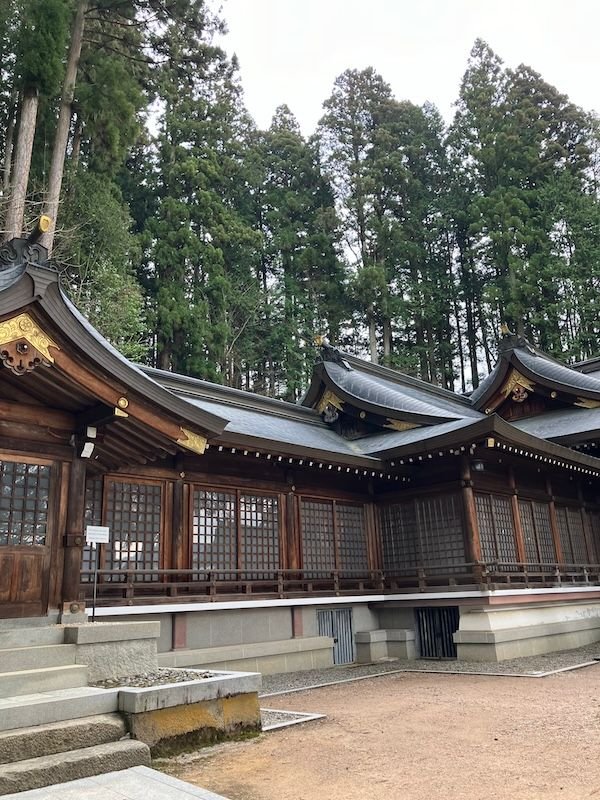

Gentle stairway up to main shinto grounds
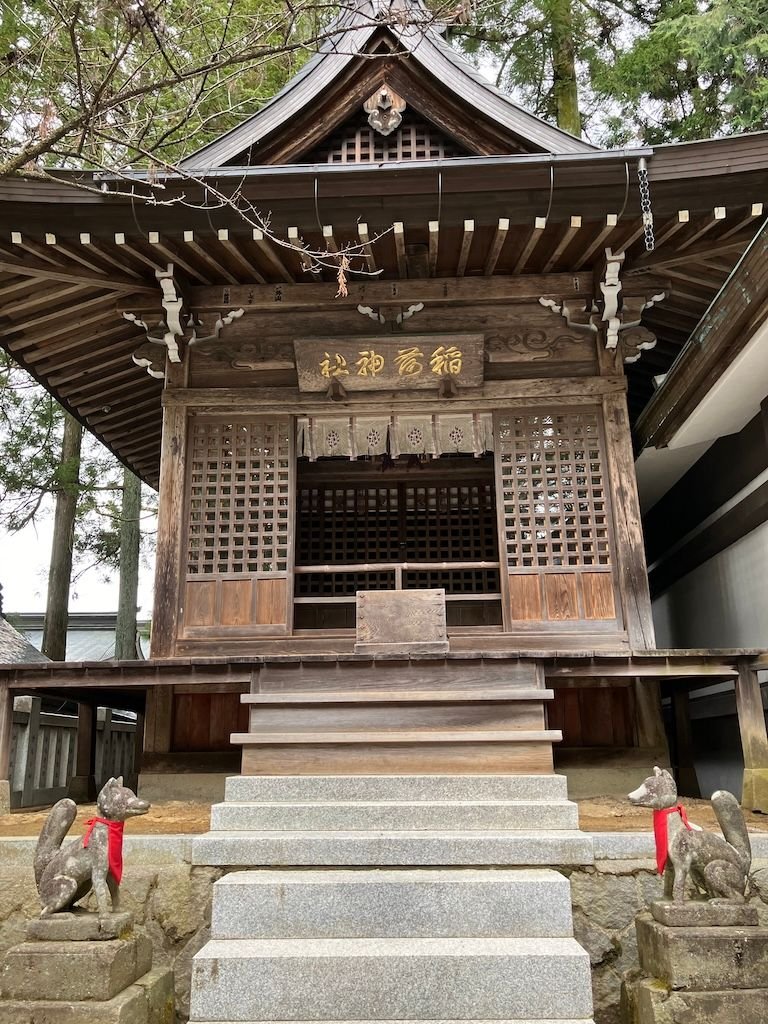
Shrine
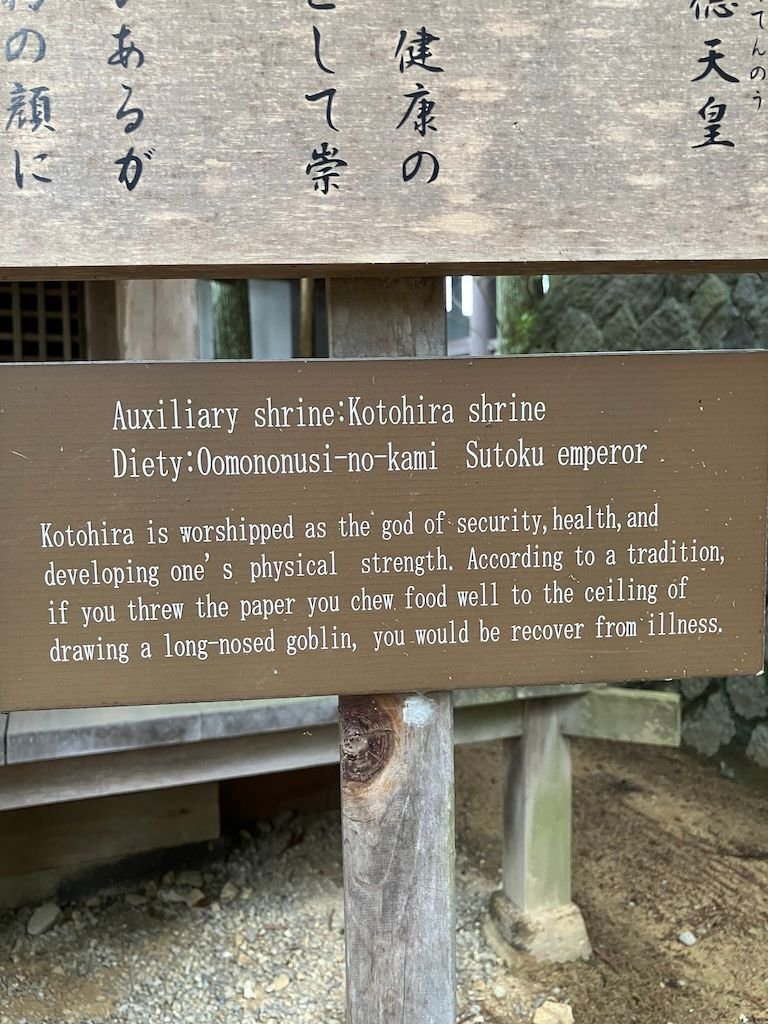
"Auxiliary" shrine and explanation
I went to a Shinto shrine, Sakurayama Hachimangu, that was nestled at the foot of a cedar grove. Based on what I’ve seen, I prefer the Shinto shrines because they’re not brightly painted; instead the cypress wood is either weathered naturally or painted with a dark stain made with soot; there are some gold/gilt decorations and a few white trim accents. In addition to the main worship hall, there were many stone lanterns and what they called “auxiliary shrines” to minor deities. The grounds were full of things to see and ponder; and all the while, the wind was tossing the cedar boughs way above. (Note that the stairway under the main gate is quite steep but there’s a gentler stairway to the left of the main stairway.)

Main entry
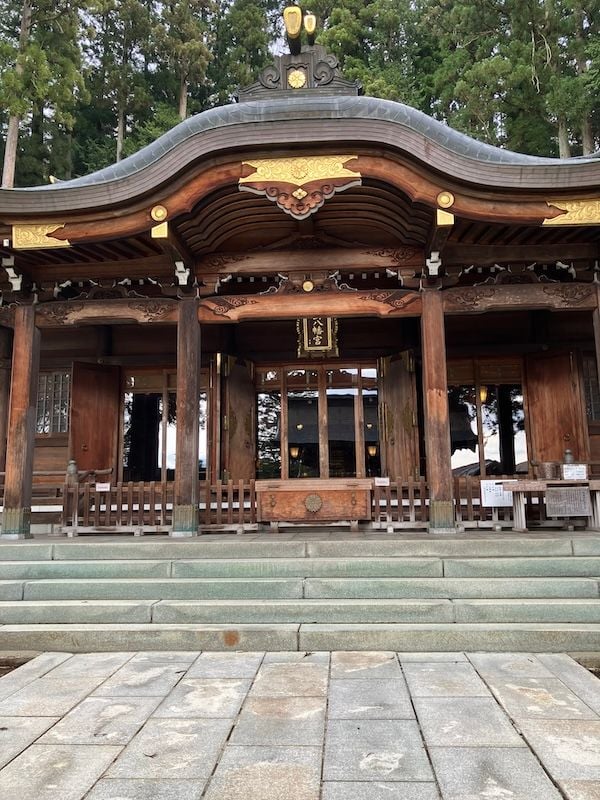
Main hall
Next to the shrine is the Takayma Matsuri Yatai Kaikan, an exhibition hall where several of the huge floats that are used in Takayama’s spring and fall festivals are stored. Guidebooks say that the Takayama festivals are among the top five in Japan; their spring festival was about 10 days away and I had purposely scheduled my visit ahead of the festival and crowds. These floats aren’t like the floats from local homecoming parades, Mardi Gras, or the Rose Bowl - those are amateur hour compared to these! These are made by dedicated artisans who don’t cut any corners and they are finished to the nth degree with lacquer, gilt, brass, wood carvings (a local specialty) and embroidered silks. Many of the floats feature puppets (costumed mannequins whose movements are controlled by people inside the float). Each float required numerous people to pull them (no motors) and each float’s support team wear unique outfits. The floats are super tall and the top levels can be retracted with a pulley system to avoid wires. They are owned/sponsored by neighborhood associations and the floats that aren’t stored in this hall are kept in garages throughout Takayama that have very tall doors.
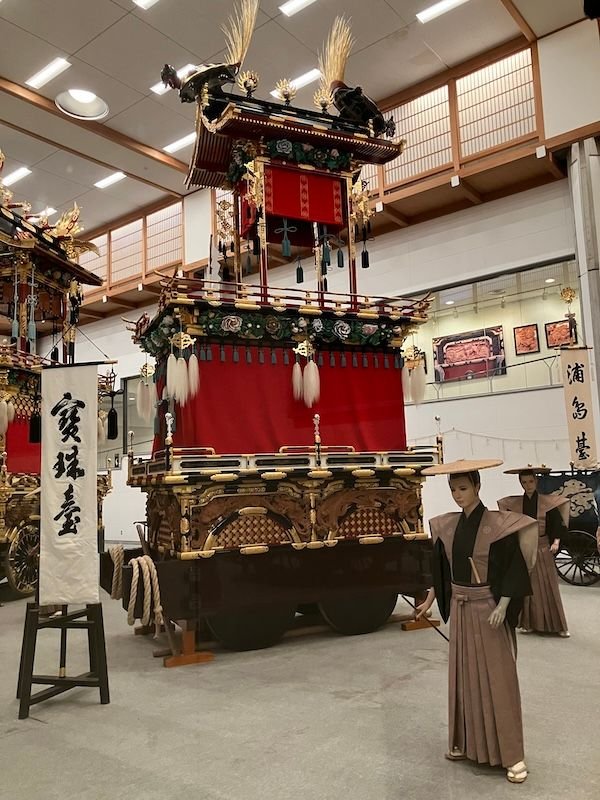
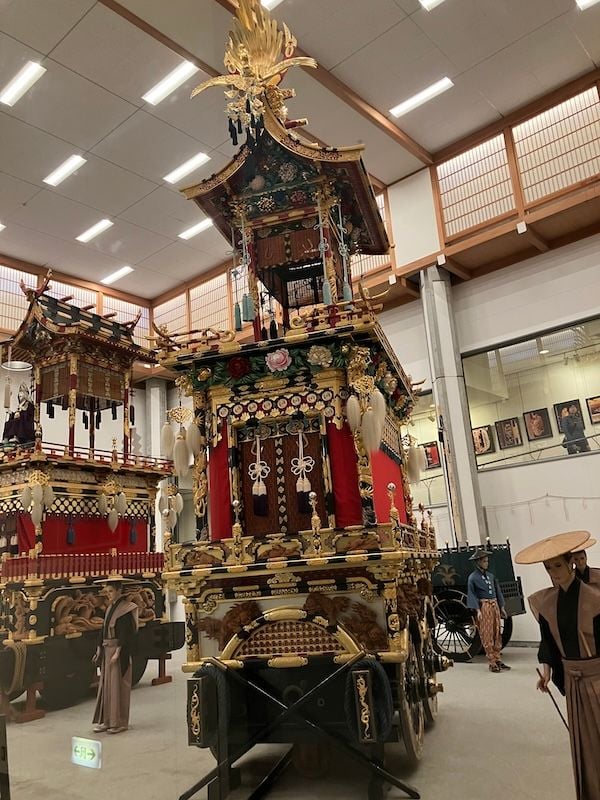
This had been a busy first day in Takayama and I was really winding down and starving. Most restaurants are not open all day so if you miss the 2:00/3:00 cut off, you’re doomed until about 6 PM. At some point during the day, I had bought a steamed Hida beef bun from a street stall (Hida beef is another local specialty); the filling of meat, veg, and some seasoning was tasty but the steamed bun – which is the first time I’ve had one – was very doughy and pale; not to my taste. Later that day I bought a skewer of grilled Hida beef from another street stall but it was quite rare, which is apparently the correct way to eat this treasured beef but it didn’t hit the spot for me. I asked my hotel for recommendations for a place to eat a quick dinner; they seemed uncertain so I suggested a sandwich, hamburger, or pizza/Italian. This threw them off totally and all they could come up with was ramen. I had seen a sign for McDonald’s, so asked them where that was but they kept pointing me to Japanese places. I thanked them and walked to McDonald’s and a supermarket that was nearby. I just wanted something quick and easy that would satisfy me without having to think too much. I totally understand that our Western concept of sandwiches for dinner is unfamiliar to them and that most tourists probably want to experience Japanese cuisine; having said that, I don’t need to make excuses or apologies for my food tastes and I quietly figure out how/where to eat. (I had better luck the next two nights w burgers which I discovered are popular in Japan.)


Gentle stairway up to main shinto grounds

Shrine

"Auxiliary" shrine and explanation
I went to a Shinto shrine, Sakurayama Hachimangu, that was nestled at the foot of a cedar grove. Based on what I’ve seen, I prefer the Shinto shrines because they’re not brightly painted; instead the cypress wood is either weathered naturally or painted with a dark stain made with soot; there are some gold/gilt decorations and a few white trim accents. In addition to the main worship hall, there were many stone lanterns and what they called “auxiliary shrines” to minor deities. The grounds were full of things to see and ponder; and all the while, the wind was tossing the cedar boughs way above. (Note that the stairway under the main gate is quite steep but there’s a gentler stairway to the left of the main stairway.)

Main entry

Main hall
Next to the shrine is the Takayma Matsuri Yatai Kaikan, an exhibition hall where several of the huge floats that are used in Takayama’s spring and fall festivals are stored. Guidebooks say that the Takayama festivals are among the top five in Japan; their spring festival was about 10 days away and I had purposely scheduled my visit ahead of the festival and crowds. These floats aren’t like the floats from local homecoming parades, Mardi Gras, or the Rose Bowl - those are amateur hour compared to these! These are made by dedicated artisans who don’t cut any corners and they are finished to the nth degree with lacquer, gilt, brass, wood carvings (a local specialty) and embroidered silks. Many of the floats feature puppets (costumed mannequins whose movements are controlled by people inside the float). Each float required numerous people to pull them (no motors) and each float’s support team wear unique outfits. The floats are super tall and the top levels can be retracted with a pulley system to avoid wires. They are owned/sponsored by neighborhood associations and the floats that aren’t stored in this hall are kept in garages throughout Takayama that have very tall doors.


This had been a busy first day in Takayama and I was really winding down and starving. Most restaurants are not open all day so if you miss the 2:00/3:00 cut off, you’re doomed until about 6 PM. At some point during the day, I had bought a steamed Hida beef bun from a street stall (Hida beef is another local specialty); the filling of meat, veg, and some seasoning was tasty but the steamed bun – which is the first time I’ve had one – was very doughy and pale; not to my taste. Later that day I bought a skewer of grilled Hida beef from another street stall but it was quite rare, which is apparently the correct way to eat this treasured beef but it didn’t hit the spot for me. I asked my hotel for recommendations for a place to eat a quick dinner; they seemed uncertain so I suggested a sandwich, hamburger, or pizza/Italian. This threw them off totally and all they could come up with was ramen. I had seen a sign for McDonald’s, so asked them where that was but they kept pointing me to Japanese places. I thanked them and walked to McDonald’s and a supermarket that was nearby. I just wanted something quick and easy that would satisfy me without having to think too much. I totally understand that our Western concept of sandwiches for dinner is unfamiliar to them and that most tourists probably want to experience Japanese cuisine; having said that, I don’t need to make excuses or apologies for my food tastes and I quietly figure out how/where to eat. (I had better luck the next two nights w burgers which I discovered are popular in Japan.)
#17
Original Poster
Join Date: Sep 2005
Posts: 499
Likes: 0
Received 0 Likes
on
0 Posts
A few more photos from yesterday.
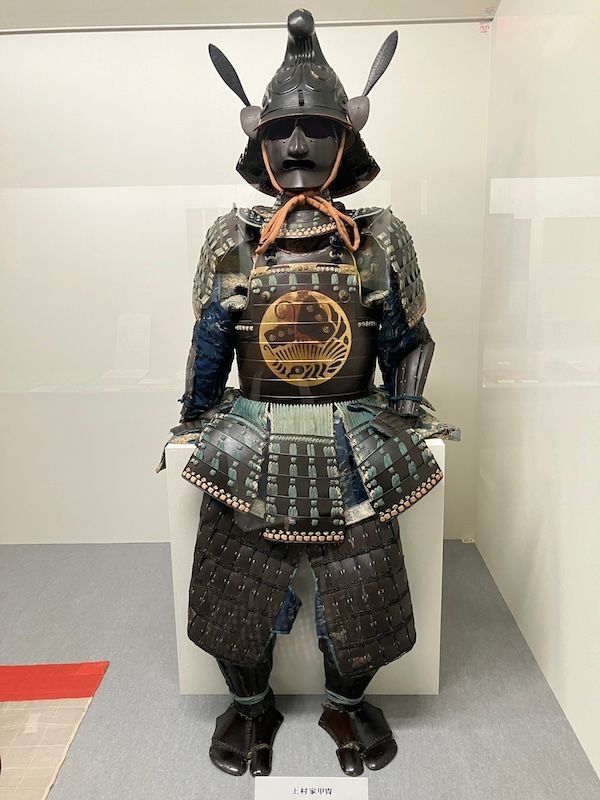
Samurai armor (I think at the float exhibition hall)
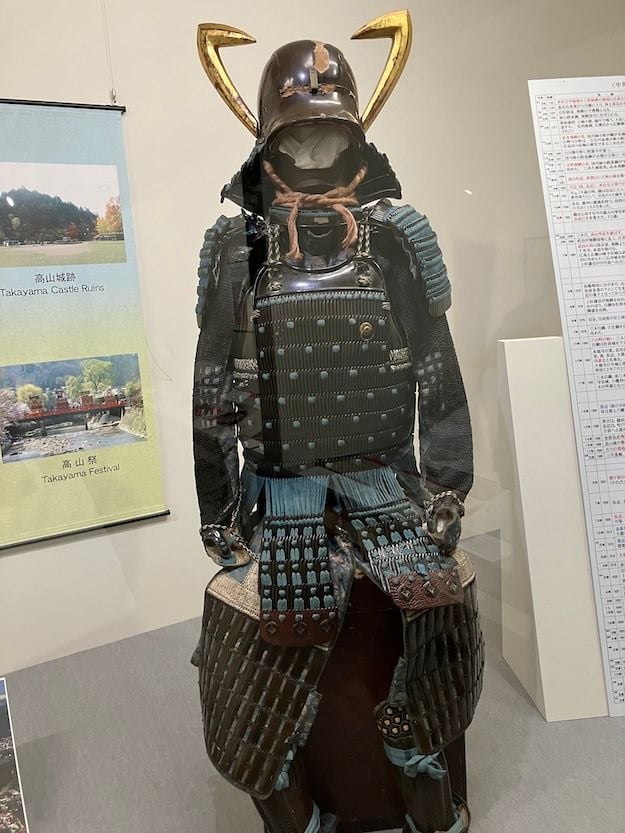
Samurai armor (I think at the float exhibition hall)

Wandering around I saw this very tall garage used to store floats!
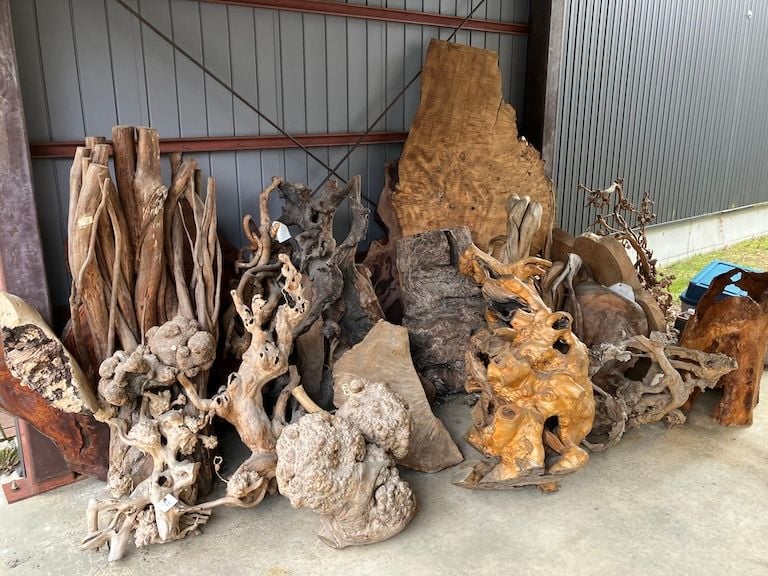
Wandering around, I noticed this stash of wood roots, trunks, etc in someone's garage - maybe a carver! (or landscaper)

Samurai armor (I think at the float exhibition hall)

Samurai armor (I think at the float exhibition hall)

Wandering around I saw this very tall garage used to store floats!

Wandering around, I noticed this stash of wood roots, trunks, etc in someone's garage - maybe a carver! (or landscaper)
#18
Join Date: Apr 2007
Posts: 431
Likes: 0
Received 0 Likes
on
0 Posts
I'm loving your report! My first trip to Japan isn't until this November, but I'm already(mentally) planning a second trip that includes Matsumoto, Takayama, Shirakawa-go, etc.
I'm always torn about whether to read books about a place before or after I've been there. I've been reading some books translated from Japanese (basically anything with a cat, cafť, or bookstore in the title or on the cover), but I keep telling myself to slow down and save them for during/after my trip so that I can better picture the settings.
I'm always torn about whether to read books about a place before or after I've been there. I've been reading some books translated from Japanese (basically anything with a cat, cafť, or bookstore in the title or on the cover), but I keep telling myself to slow down and save them for during/after my trip so that I can better picture the settings.
#20
Original Poster
Join Date: Sep 2005
Posts: 499
Likes: 0
Received 0 Likes
on
0 Posts
memejs: November is a great time to visit these mountain towns!! The bus ride between the towns will be spectacular; when you buy your bus ticket in advance, make sure to get a window seat. I really liked Matsumoto and Takayama; I feel as though I could have spent another day in Matsumoto because I would have liked to wander the town more and get out of the "tourist" area. When I travel, I often take local buses that do a loop just to see more and the very helpful people at the Matsumoto tourist office could help you figure out what bus route, etc. I had given myself a long list of places to see/things to do and not as time as normal for meandering. About reading location-centric books....I found that reading Shogun just prior and during my trip was very helpful since the majority of sites I went to were feudal (and the book was a million times better than either movie version) but it's 1200 pages. But reading them after your trip makes sense too 
plambers - I hope you have a great time in Takayama!
Day 9 –Takayama (April 5) Overcast but dry, low 50’s. Had a great day today.
I decided to get out early (at 8:00 am) to beat the tour groups and walk through the heritage preservation streets again, to hopefully see them without people. It worked so I was able to get the historic sense; very striking vista looking down the street of low, but varying heights, dark buildings with varied lattice work, doors & windows. It’s amazing how much more I see and enjoy without dodging groups of people 😀.
One of the “places to see” in Takayama are the two morning markets along the riverside which theoretically have local people selling produce and handmade goods so I went to the Miyagawa Market along the Miyagawa River in the old town. The tour groups had found the market, but I was still ahead of most of them. For me, this market was a waste - either the vendors were selling fresh produce which I can’t use or vacuum packed mystery food; mass produced souvenir items; or ice cream shops. But it was a walk along the river, which is still a rushing frothing river, so that was nice and it was on the way to my next stop the Buddhist Temple, Hida Kokunbunji, which was serene and super interesting. It’s not huge but there was so much to see! It was founded in the eighth century and some of the original foundation stones are still there; there’s a huge ginkgo tree that’s over 1200 years old; the only three-story pagoda in the region (theoretically, the tower at the top of the pagoda contains Buddha’s ashes); several odd small shrines; lots of little stone figures; and mossy stone lanterns. It’s a national historic site and important cultural treasure. For a small donation (300• which equals $1.98) you can buy a temple stamp with calligraphy from the monk on duty. I also rang the big bell as part of a prayer process – I tried to remember the correct order of bowing and clapping, but probably didn’t. And there’s a public toilet on the grounds! (always useful to know where those are 😉 . There were other tourists there but no tour groups so it was easy to wander around the various sites (there are English descriptions on most).
. There were other tourists there but no tour groups so it was easy to wander around the various sites (there are English descriptions on most).
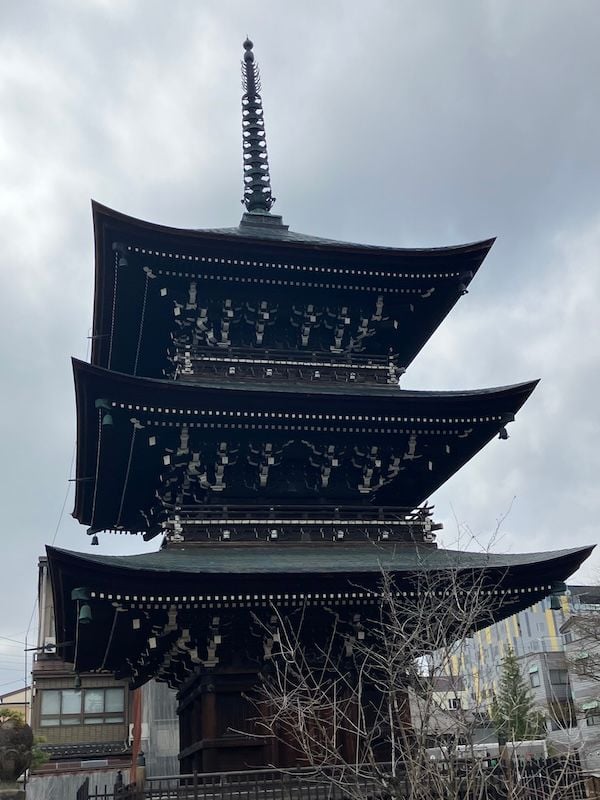
Hida Kokunbunji temple - 3 story pagoda
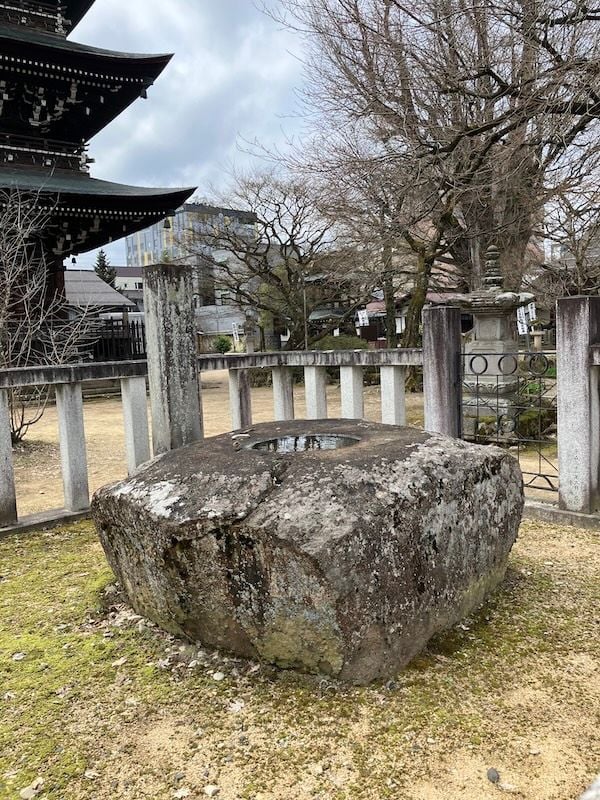
Hida Kokunbunji temple - 8th c foundation stone
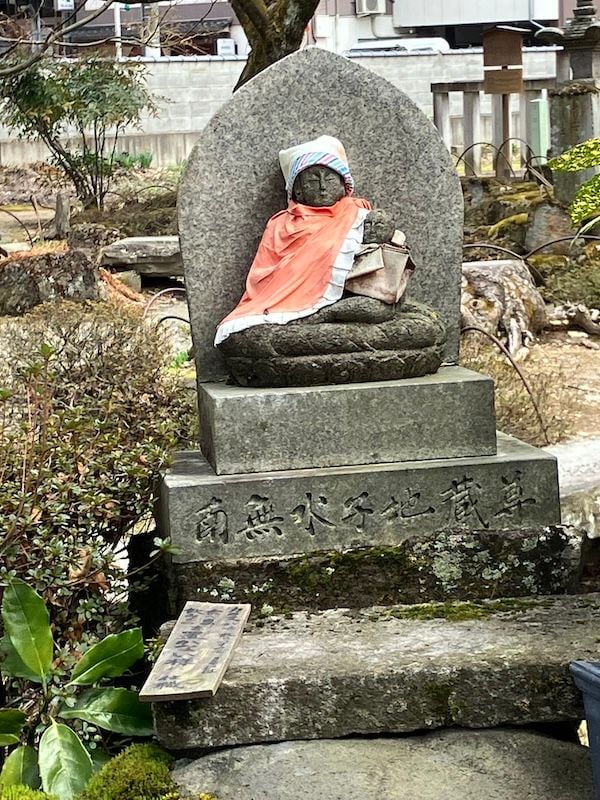
Hida Kokunbunji temple
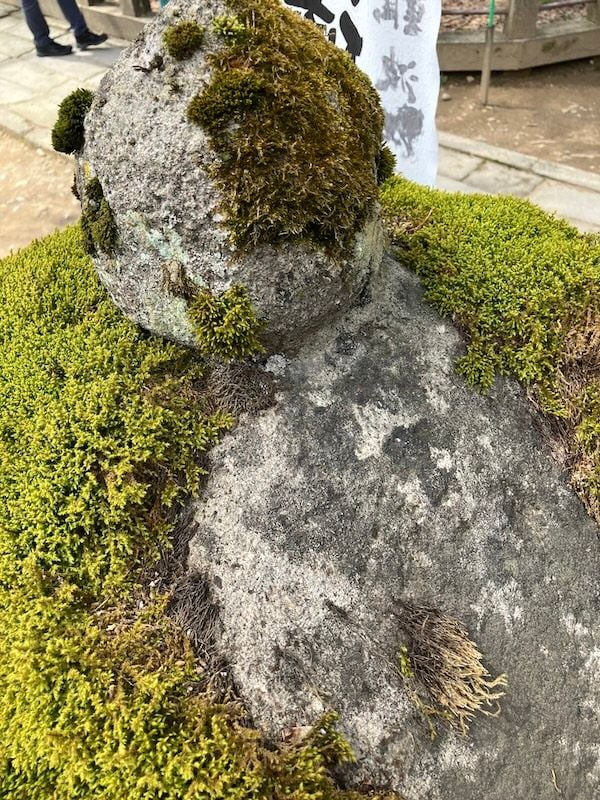
Hida Kokunbunji temple - mossy stone

Hida Kokunbunji - bell tower

Hida Kokunbunji - shrine

Hida Kokunbunji - sarubobo shrine
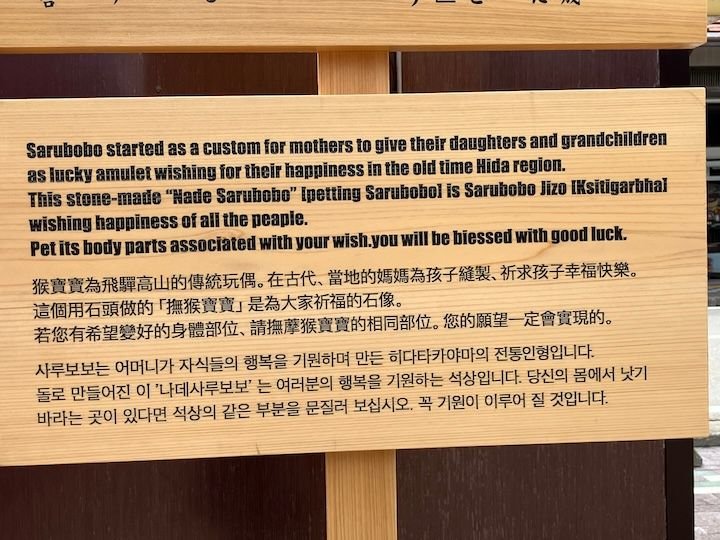
I decided to take a bus to the Hida Folk Village, an open air museum. Since I was at the transportation station, I took the opportunity to change my train ticket for Sunday; instead of taking a 3:30 train from Takayama to Nagoya, I’m taking a 9:30 train that will get me to Nagoya at about noon and I can do a little sightseeing there before going to the airport the next day. The train station service center switched tickets for no extra charge, which was a nice surprise. The bus to Hida only took 10 minutes and it was interesting to go through a non-touristy area of Takayama.
For some reason, I thought I didn’t like open air museums, perhaps because I was picturing a Williamsburg type place that’s all fake and Disneyfied. But I went to one in Northern England several years ago that was a mining village, and was really interested in it; and this one was also very interesting. The village is a collection of almost 30 original buildings which were brought to this site from the area with signage boards outside and exhibits inside with signage (no reenactments or people wearing period costumes). Residences included a village head's house, logging huts, storehouses and a number of gassho-zukuri farmhouses, which are named after their steep thatched roofs resembling a pair of hands joined in prayer (moved here from nearby Shirakawago). Because this is such a snowy area, homes in the countryside had very steeply pitched roofs with overhanging eaves so that the snow would either slide off, or at least melt and drip down the walls. The houses had different style roofs – some were very densely thatched and others were shingled but they all had very thick beams to support the weight of 6 feet of snow. They all had a very large central fireplace in the floor that they cooked over and it heated the house. It did do a good job heating because there were no sliding walls and no rice paper walls; although the ceiling was high, it was only high in the very middle with a steep pitch, and I’ll bet that thatch is a good insulator.

Hida Folk Village

Hida Folk Village

Hida Folk Village - lake and buildings beyond (parasols were available and I couldn't resist the pink!)
The buildings were all well preserved and each one had an exhibit of tools and utensils used in everyday life (all had English descriptions). In a few buildings, artisans were demonstrating their craft such as wood carving and pottery. In one building there was a small class in making friendship string bracelets (fee). There’s a large lake and a water mill in the middle of the grounds, with the buildings set around the lake and up a slight hill. There’s also a farm patch and rice paddy. People were spread out between the different areas; there were no tour groups here (I think they all go to Shirakawago); so you could take as much time as you wanted in the buildings. (In most, you have to take your shoes off, so wear socks!). I spent almost 3 hours here. I definitely recommend Hida Folk Village since it's not as crowded as Shirakawago, you can go into all the buildings, good descriptions are provided, exhibits in each building give context to that building’s purpose and it’s a short bus ride.
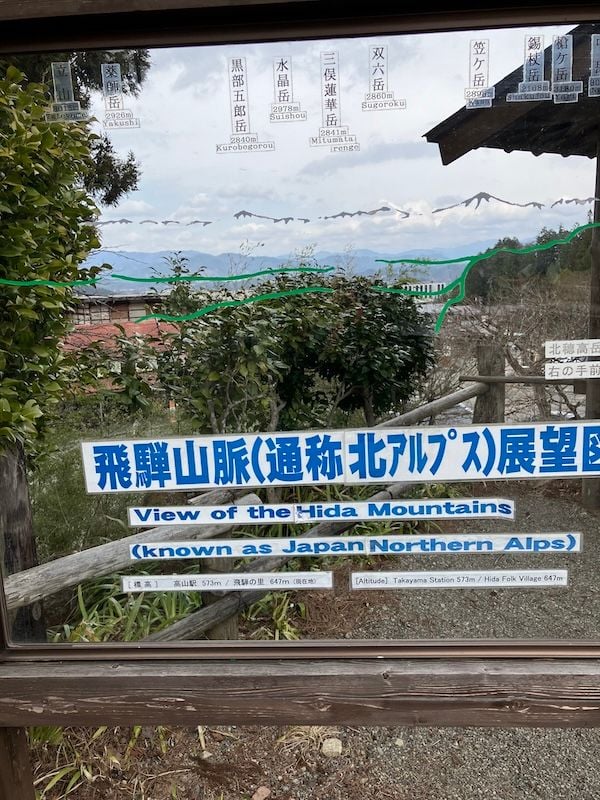
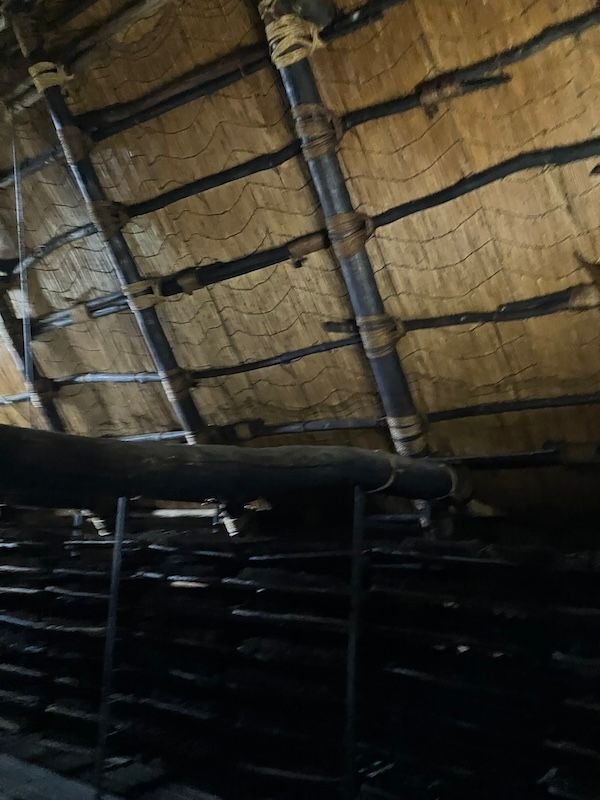
Interior roof construction
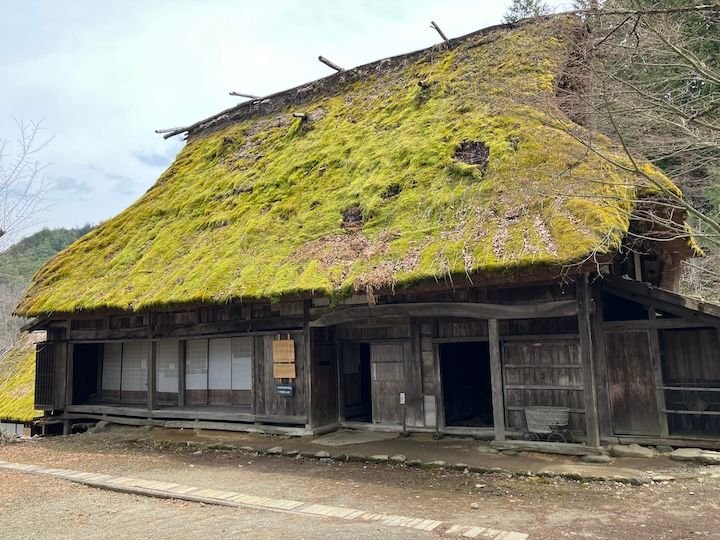
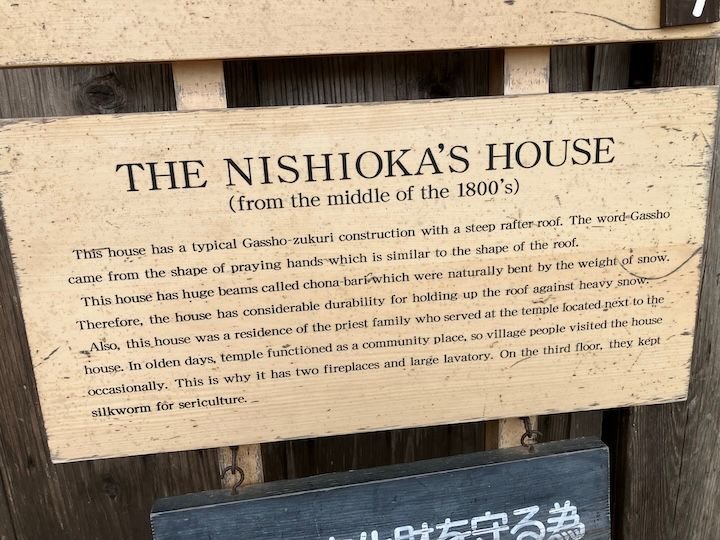

Note: At the parking lot where the bus drops off/picks up, there’s a building with souvenirs & pre-packaged snacks and toilets; next to that building is the Hida Takayama Crafts Experience Center, where workshops on local handicrafts are offered. For a fee of 700 to 1800 yen, you can learn make crafts such as beaded key chains, sarubobo dolls, wooden key rings or coasters, or mini-tapestries, and take them home as souvenirs. Workshops last 15-60 minutes, and reservations are not required. I checked it out but decided not to make anything since the bus would be leaving soon for my next stop.
A bus from Takayama to Hida also continues from Hida to the Matsuri no Mori (Festival Forest) museum, about 10 mins from Hida. This museum contains replica and life-size festival floats, taiko drums and karakuri dolls (marionettes). During the festivals, the karakuri dolls are manipulated by puppeteers, but the museum uses machine-operated ones for the demonstrations that are held frequently throughout the day. When you buy your ticket, they’ll tell you when the next demonstrations are (usually for 3 floats and the taiko drums). There’s a museum section that provides a good overview of the festivals and then the main hall contains a number of full size floats. The museum is underground and the main hall has a cave look (rough stone walls complete with some water leaks from the ceiling). You can walk all around the floats and get pretty close; there’s seating available in a central area where you can watch the demonstrations. During the demos, music plays, marionettes move and twirl and sometimes toss confetti; for the drumming demo, marionettes play the drums; and there’s a lion (dragon?) dance by marionettes also. Limited English descriptions of the floats but you can appreciate the workmanship and dťcor and the demos are entertaining. I spent about 45 mins there which seemed enough. If you’re going to Hida Folk Village and the timing works for you, then I think it makes sense to visit Matsuri no Mori regardless of whether you went to the Takayma Matsuri Yatai Kaikan float exhibition hall or not since the Matsuri no Mori demonstrations (marionettes & drums) add an element that the exhibition hall doesn’t offer.
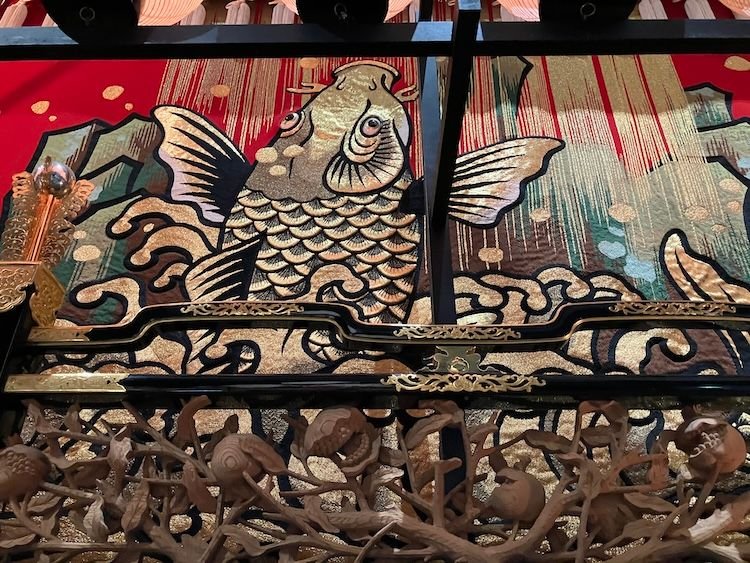
Matsuri no Mori - silk and carving decoration on float
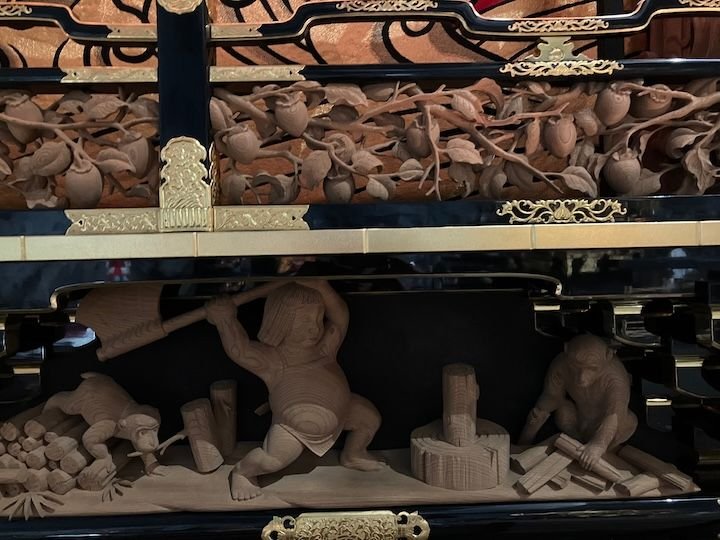
Matsuri no Mori - carving decoration on float
Earlier in the day when I left the Hida Kokunbunji temple en route to the train station, I noticed a sign for a restaurant called EvilTex which sounded like a great dinner option. I returned from my field trip before their dinner opening time of 5:00 so I sat in the Hida Kokunbunji temple grounds to relax and people-watch until I could go in. I loved this restaurant!!! First, location: it’s just off Kokobunji Street, about two blocks from the train/bus station; if you leave the Hida Kokunbunji temple exit onto Kokobunji Street (near the Sarubobo shrine), turn right; at the next block, you’ll see an Indian/Nepalese restaurant on the corner of Kokobunji Street and a smaller street; cross the street and go down that smaller street; the restaurant is about 30 feet ahead on your right, in a small strip of stores. It’s a small place with 5 or 6 tables and stools at the bar. I would call the dťcor 1950’s American gas station (old metal signs, etc) and the sound track was Grateful Dead. They focus on burgers and Mexican dishes; I got the shredded pork burger which was very good (not a burger, but shredded pork, with grilled pineapple, crispy fried onions, BBQ sauce and veg on a burger bun with fries). The pork was tasty, the grilled pineapple gave it an extra zing and the fries were crispy. Can’t express how that hit the spot. There was an American couple sitting behind me and as they left they thanked the staff and said “we only wish we were staying in Takayama longer so we could try all the Mexican dishes…we’ve eaten here 3 times already!” So I guess the TexMex items are good too! They have a website. The menu has English descriptions and photos, plus the staff are very helpful and speak excellent English. My burger and soda was $14 USD.

plambers - I hope you have a great time in Takayama!
Day 9 –Takayama (April 5) Overcast but dry, low 50’s. Had a great day today.
I decided to get out early (at 8:00 am) to beat the tour groups and walk through the heritage preservation streets again, to hopefully see them without people. It worked so I was able to get the historic sense; very striking vista looking down the street of low, but varying heights, dark buildings with varied lattice work, doors & windows. It’s amazing how much more I see and enjoy without dodging groups of people 😀.
One of the “places to see” in Takayama are the two morning markets along the riverside which theoretically have local people selling produce and handmade goods so I went to the Miyagawa Market along the Miyagawa River in the old town. The tour groups had found the market, but I was still ahead of most of them. For me, this market was a waste - either the vendors were selling fresh produce which I can’t use or vacuum packed mystery food; mass produced souvenir items; or ice cream shops. But it was a walk along the river, which is still a rushing frothing river, so that was nice and it was on the way to my next stop the Buddhist Temple, Hida Kokunbunji, which was serene and super interesting. It’s not huge but there was so much to see! It was founded in the eighth century and some of the original foundation stones are still there; there’s a huge ginkgo tree that’s over 1200 years old; the only three-story pagoda in the region (theoretically, the tower at the top of the pagoda contains Buddha’s ashes); several odd small shrines; lots of little stone figures; and mossy stone lanterns. It’s a national historic site and important cultural treasure. For a small donation (300• which equals $1.98) you can buy a temple stamp with calligraphy from the monk on duty. I also rang the big bell as part of a prayer process – I tried to remember the correct order of bowing and clapping, but probably didn’t. And there’s a public toilet on the grounds! (always useful to know where those are 😉
 . There were other tourists there but no tour groups so it was easy to wander around the various sites (there are English descriptions on most).
. There were other tourists there but no tour groups so it was easy to wander around the various sites (there are English descriptions on most).
Hida Kokunbunji temple - 3 story pagoda

Hida Kokunbunji temple - 8th c foundation stone

Hida Kokunbunji temple

Hida Kokunbunji temple - mossy stone

Hida Kokunbunji - bell tower

Hida Kokunbunji - shrine

Hida Kokunbunji - sarubobo shrine

I decided to take a bus to the Hida Folk Village, an open air museum. Since I was at the transportation station, I took the opportunity to change my train ticket for Sunday; instead of taking a 3:30 train from Takayama to Nagoya, I’m taking a 9:30 train that will get me to Nagoya at about noon and I can do a little sightseeing there before going to the airport the next day. The train station service center switched tickets for no extra charge, which was a nice surprise. The bus to Hida only took 10 minutes and it was interesting to go through a non-touristy area of Takayama.
For some reason, I thought I didn’t like open air museums, perhaps because I was picturing a Williamsburg type place that’s all fake and Disneyfied. But I went to one in Northern England several years ago that was a mining village, and was really interested in it; and this one was also very interesting. The village is a collection of almost 30 original buildings which were brought to this site from the area with signage boards outside and exhibits inside with signage (no reenactments or people wearing period costumes). Residences included a village head's house, logging huts, storehouses and a number of gassho-zukuri farmhouses, which are named after their steep thatched roofs resembling a pair of hands joined in prayer (moved here from nearby Shirakawago). Because this is such a snowy area, homes in the countryside had very steeply pitched roofs with overhanging eaves so that the snow would either slide off, or at least melt and drip down the walls. The houses had different style roofs – some were very densely thatched and others were shingled but they all had very thick beams to support the weight of 6 feet of snow. They all had a very large central fireplace in the floor that they cooked over and it heated the house. It did do a good job heating because there were no sliding walls and no rice paper walls; although the ceiling was high, it was only high in the very middle with a steep pitch, and I’ll bet that thatch is a good insulator.

Hida Folk Village

Hida Folk Village

Hida Folk Village - lake and buildings beyond (parasols were available and I couldn't resist the pink!)
The buildings were all well preserved and each one had an exhibit of tools and utensils used in everyday life (all had English descriptions). In a few buildings, artisans were demonstrating their craft such as wood carving and pottery. In one building there was a small class in making friendship string bracelets (fee). There’s a large lake and a water mill in the middle of the grounds, with the buildings set around the lake and up a slight hill. There’s also a farm patch and rice paddy. People were spread out between the different areas; there were no tour groups here (I think they all go to Shirakawago); so you could take as much time as you wanted in the buildings. (In most, you have to take your shoes off, so wear socks!). I spent almost 3 hours here. I definitely recommend Hida Folk Village since it's not as crowded as Shirakawago, you can go into all the buildings, good descriptions are provided, exhibits in each building give context to that building’s purpose and it’s a short bus ride.


Interior roof construction



Note: At the parking lot where the bus drops off/picks up, there’s a building with souvenirs & pre-packaged snacks and toilets; next to that building is the Hida Takayama Crafts Experience Center, where workshops on local handicrafts are offered. For a fee of 700 to 1800 yen, you can learn make crafts such as beaded key chains, sarubobo dolls, wooden key rings or coasters, or mini-tapestries, and take them home as souvenirs. Workshops last 15-60 minutes, and reservations are not required. I checked it out but decided not to make anything since the bus would be leaving soon for my next stop.
A bus from Takayama to Hida also continues from Hida to the Matsuri no Mori (Festival Forest) museum, about 10 mins from Hida. This museum contains replica and life-size festival floats, taiko drums and karakuri dolls (marionettes). During the festivals, the karakuri dolls are manipulated by puppeteers, but the museum uses machine-operated ones for the demonstrations that are held frequently throughout the day. When you buy your ticket, they’ll tell you when the next demonstrations are (usually for 3 floats and the taiko drums). There’s a museum section that provides a good overview of the festivals and then the main hall contains a number of full size floats. The museum is underground and the main hall has a cave look (rough stone walls complete with some water leaks from the ceiling). You can walk all around the floats and get pretty close; there’s seating available in a central area where you can watch the demonstrations. During the demos, music plays, marionettes move and twirl and sometimes toss confetti; for the drumming demo, marionettes play the drums; and there’s a lion (dragon?) dance by marionettes also. Limited English descriptions of the floats but you can appreciate the workmanship and dťcor and the demos are entertaining. I spent about 45 mins there which seemed enough. If you’re going to Hida Folk Village and the timing works for you, then I think it makes sense to visit Matsuri no Mori regardless of whether you went to the Takayma Matsuri Yatai Kaikan float exhibition hall or not since the Matsuri no Mori demonstrations (marionettes & drums) add an element that the exhibition hall doesn’t offer.

Matsuri no Mori - silk and carving decoration on float

Matsuri no Mori - carving decoration on float
Earlier in the day when I left the Hida Kokunbunji temple en route to the train station, I noticed a sign for a restaurant called EvilTex which sounded like a great dinner option. I returned from my field trip before their dinner opening time of 5:00 so I sat in the Hida Kokunbunji temple grounds to relax and people-watch until I could go in. I loved this restaurant!!! First, location: it’s just off Kokobunji Street, about two blocks from the train/bus station; if you leave the Hida Kokunbunji temple exit onto Kokobunji Street (near the Sarubobo shrine), turn right; at the next block, you’ll see an Indian/Nepalese restaurant on the corner of Kokobunji Street and a smaller street; cross the street and go down that smaller street; the restaurant is about 30 feet ahead on your right, in a small strip of stores. It’s a small place with 5 or 6 tables and stools at the bar. I would call the dťcor 1950’s American gas station (old metal signs, etc) and the sound track was Grateful Dead. They focus on burgers and Mexican dishes; I got the shredded pork burger which was very good (not a burger, but shredded pork, with grilled pineapple, crispy fried onions, BBQ sauce and veg on a burger bun with fries). The pork was tasty, the grilled pineapple gave it an extra zing and the fries were crispy. Can’t express how that hit the spot. There was an American couple sitting behind me and as they left they thanked the staff and said “we only wish we were staying in Takayama longer so we could try all the Mexican dishes…we’ve eaten here 3 times already!” So I guess the TexMex items are good too! They have a website. The menu has English descriptions and photos, plus the staff are very helpful and speak excellent English. My burger and soda was $14 USD.



